Camera traps in the jungles of Peru have captured footage of ocelots and opossums traveling together. We have at least four confirmed cases of the two animals walking in tandem, seeming to be perfectly aware and comfortable with the other's presence. The pairs were never more than two meters apart, moving at a leisurely pace. Their body language is relaxed, the opossum never attempting its famous "play dead" manoeuvre.
Experts believe that these aren't isolated incidents, but a pattern of behavior. A group of ecologists and researchers released a new study speculating on what that behavior could mean.
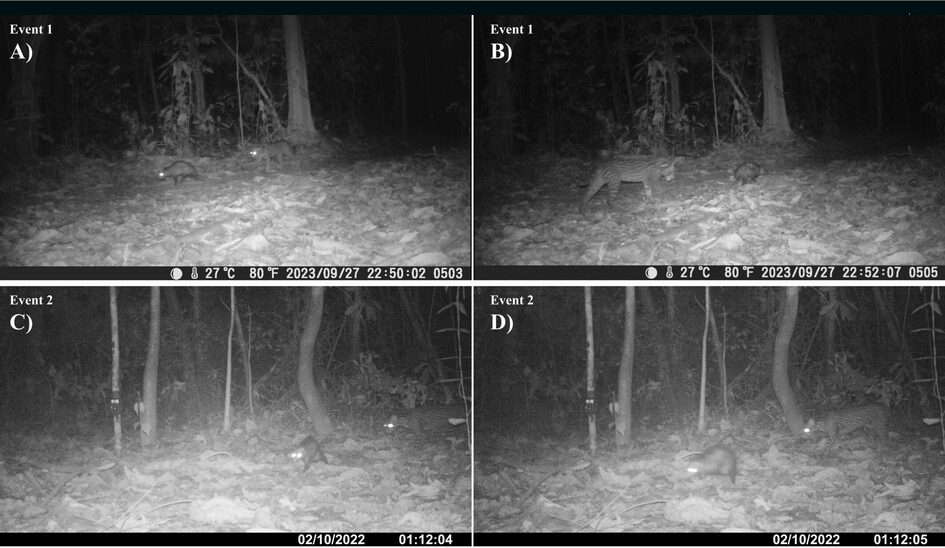
Sniff test
Before they developed formal theories, the researchers needed to collect more data. Ocelots might seek out opossums to hunt them, but would opossums actively seek out ocelots?
To find out, they set up camera traps with 'ocelot cues' -- items which gave off the scent of an ocelot, usually a strip of fabric -- and waited. Opossums showed up and even interacted with the ocelot cues, sniffing, biting, or rubbing themselves on the fabric. Opossums visited the ocelot-scented cameras far more often than control cameras.
To confirm that it was specifically ocelots that the little marsupials were interested in, they repeated the experiment. Using control and puma (cougar, catamount, mountain lion) scented traps, they observed that the opossums preferred the control, apparently disdaining the company of puma.
Both animals are solitary within their species, yet the ocelot and opossum don't just fall in together, but actively seek each other out. The question remains, why?
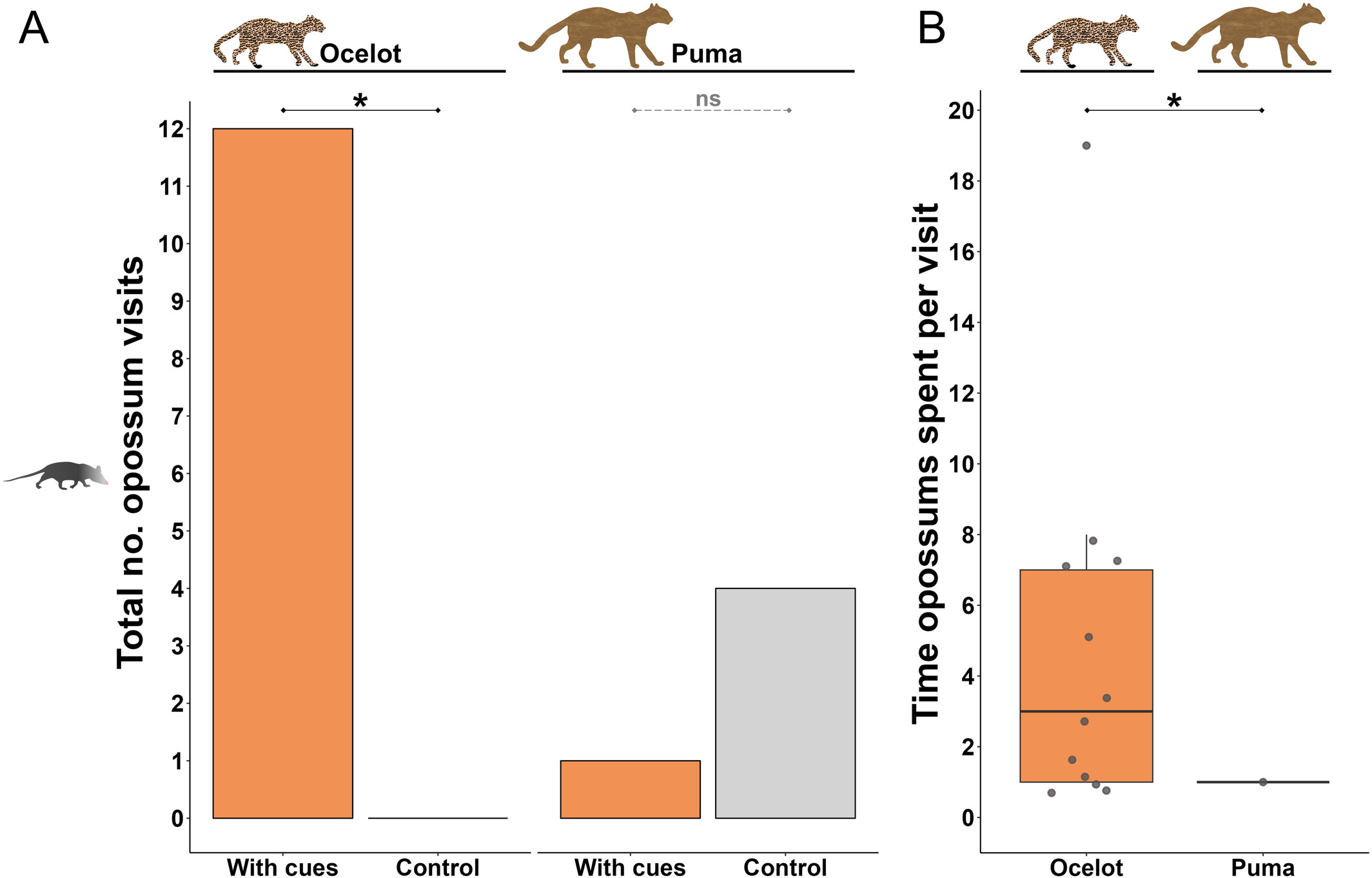
Much we don't know
Mutual partnerships between species are not rare and form when both sides have something to offer the other. Coyotes and badgers sometimes partner up to hunt burrowing prey. Their different adaptations and hunting strategies complement each other -- the coyote handles the chasing, and the badger handles the digging.
One theory is that the ocelot and opossum partnerships work much the same way. Opossums often feed on snakes and are even immune to viper venom, like the eponymous hero of Rudyard Kipling's short story Rikki-Tikki-Tavi. Perhaps the pairs team up to hunt serpents.
The researchers also speculate that moving as a pair may be a sort of camouflage. By moving with the notoriously odoriferous opossum, the ocelot could hide its scent, making it easier to stalk prey. Moving with the ocelot, the opossum would be safer from pumas and jaguars.
Ultimately, we don't know if one, both, or neither of these theories is correct. The study concludes with a call for more research, and a reflection on what this find reminds us: "how limited our understanding remains of the complex dynamics among tropical rainforest species."
Two killer whales have been caught "kissing" on camera in a fiord in northern Norway. A group of snorkelers-turned-citizen-scientists captured the moment last October, and now the internet is going wild for the smooching orcas.
This behavior, known as tongue-nibbling, has never been seen before in wild orcas. The snorkelers were on a whale-watching tour when they saw the two juvenile orcas approach each other and begin gently touching mouths and nibbling at each other’s tongues.
The video footage shows three separate interactions between the whales. Altogether, the whales spent nearly two minutes tongue-nibbling, a behavior that bears striking resemblance to French kissing. After their underwater make-out session, the two whales parted ways, swimming off in different directions.
Only seen a handful of times
Even in captive whales, this behavior is incredibly rare. It was first spotted in 1978 at Loro Parque Marine Park in Tenerife, Spain. Since then, only a handful of workers at marine parks have witnessed it.
"Orca caretakers at several facilities are aware of the behavior, but its prevalence is extremely low," study co-author Javier Almunia told LiveScience. "It may appear and then not be observed again for several years.”
The meaning of the behavior is open for interpretation. Some experts believe it’s a form of social bonding, similar to grooming in primates or the lip contact seen in beluga whales. Others suggest it could be play, part of how orcas express affection, or test social boundaries.
“Tongue-nibbling itself has not been recorded in other species, but comparable mouth-related social interactions have been observed in belugas," Almunia explained. "This could suggest that, given cetacean anatomy — particularly the adaptation of limbs to the marine environment — oral contact may serve as a more versatile means of social communication than in terrestrial mammals."
Others have speculated that it might be a way to clean each other’s mouths or beg for food. Regardless of the exact reason behind it, the kiss shows us that there is still a huge amount we don't know about cetacean behavior.
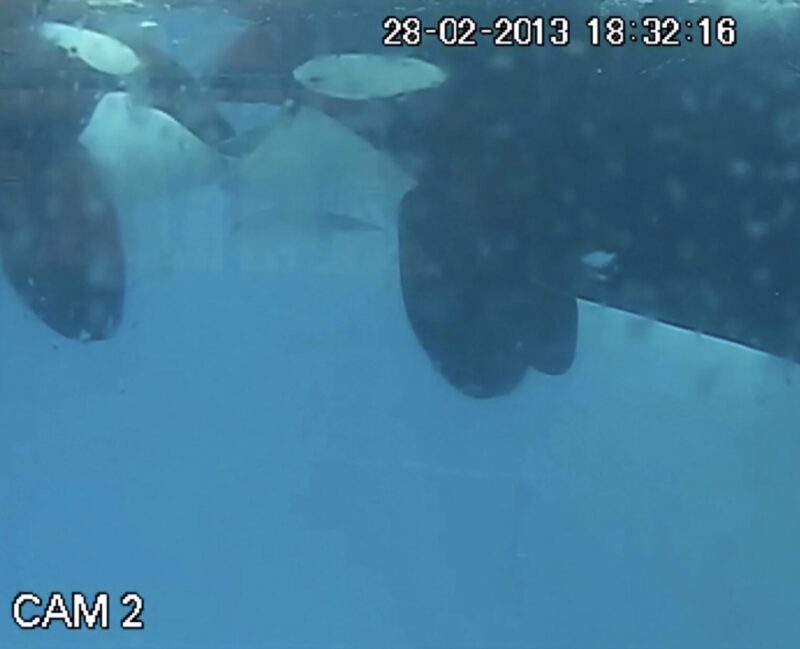
Natural behavior?
Those analyzing the footage believe that since this kissing occurs in wild orcas, it is a natural behavior also shown in orcas under human care.
Not all scientists agree. Some think that far more research is needed -- research that does not need captive whales.
“Even if the behavior itself is fascinating, and I think it is...it’s just one observation," marine mammal researcher Luke Rendall told LiveScience. "It is telling that in their summing up, these authors take great pains to explain how this observation justifies orca captivity and swim-with-cetaceans programs. It does not, in my view.”
In mid‑June, a rare case of mammalian altruism unfolded off the coast of Western Australia. A pod of dolphins escorted a young humpback whale from the confines of a shallow bay into deeper water.
Local conservationists from the Dolphin Discovery Centre spotted the humpback whale in Koombana Bay and were immediately concerned. Every year, the whales migrate roughly 5,000km from Antarctica to their breeding grounds near Australia’s Gold Coast. Humpbacks move along the coastline but do not usually venture into the shallow bay.
They quickly dispatched a boat crew to inspect the animal and sent drones to capture aerial footage.
“Sometimes it happens that an animal gets spooked by a predator, is [doing] poorly or injured, or might have a fishing gear entanglement," the Dolphin Discovery Centre commented. "These animals then often seek shelter in calmer and more shallow parts to rest up.”
The drone recorded the whale languishing near the bay’s edge. The footage showed no signs of entanglement or wounds. Just a whale that appeared a little bit lost. Then a curious pod of bottlenose dolphins appeared.
The dolphins started by circling the whale. Then came the pivotal moment. They began swimming northward, almost guiding the whale with purpose. The young humpback followed, moving into Geographe Bay’s deeper waters.
Dolphins are naturally sociable and curious, but this was more than a brief interaction. The footage seemed to show a coordinated effort, as if the dolphins recognized that the whale, possibly disoriented or exhausted from its migration, needed help. Inter‑species cooperation in the wild is incredibly rare. While marine animals sometimes travel together, they do not actively guide other species.
Dr. Vanessa Pirotta, a marine wildlife scientist, suggested that the dolphins might have even communicated with the whale.
“Whales use low-frequency sounds, while dolphins make high-frequency sounds, so I would assume these dolphins may have been buzzing around this whale," she said. "All in all, it looks like a very playful and innocent interaction between these two species.”
Each spring, millions of tiny brown Bogong moths fly 1,000km from southeastern Australia to the caves of the Australian Alps to escape the summer heat. Now we know how they find their way -- they navigate using the stars.
They have an innate ability to make this journey. After a few months in the caves, they return to their breeding grounds to mate and die -- so the next time they migrate, there are no individuals from a previous generation to show them the way. But somehow, the moths unerringly make it to a place they’ve never visited before.
Their journey can take weeks. The little moths fly each night and rest during the day, hiding up in whatever little crevices they can find en route.
“Their parents have been dead for three months, so nobody’s shown them where to go” said Eric Warrant, the author of the new study. "They just emerge from the soil in spring in some far-flung area of southeastern Australia, and they just simply know where to go. It’s totally amazing."
Magnetic field not as important
Warrant has studied the moths for years. He previously proved that they use the Earth's magnetic field to navigate, but he always thought there was more to the story. He believed that the moths had visual cues to guide them. As it turns out, the magnetic fields might play less of a role than previously thought.
To test his theory that the moths use the constellations, Warrant and his team set up a lab in his home near the Australian Alps. They designed a “moth arena” with a projection of the night sky on the ceiling. This perfectly mimicked the stars they would see if making the actual flight. To negate the impact of the magnetic field a Helmholtz coil was used, which creates a magnetic vacuum.
“We captured the moths using a light trap, brought them back to the lab, and then we glued a very thin rod on their back, made out of tungsten, which is nonmagnetic,” explained Warrant. "Once you’ve done that, you can hold that little rod between your fingers, and the moth will fly very vigorously on the end of that tether."
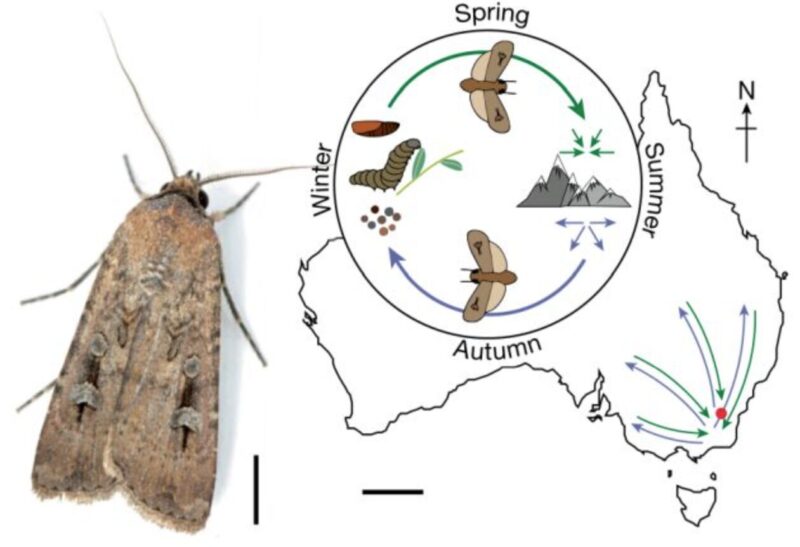
Positive proof
As the moths flew around the lab, an optical sensor detected their movement. In clear-sky tests, with accurate stellar projections above, the moths oriented themselves seasonally: flying south in spring and north in autumn. Astonishingly, when researchers rotated the star pattern, the moths adjusted their flight direction accordingly. If the stellar patterns were completely scrambled, the moths became disoriented, flying in every direction.
“That was, for us, like the final proof that they actually indeed use the stars for navigation,” said lead researcher David Dyer.
The experiment went even deeper. They then placed electrodes in the moths' brains to record neural activity. Researchers watched specific brain regions light up when the night sky shifted, especially as the insects faced south, the direction of migration.
Researchers now think that the Earth's magnetic field is more of a backup navigational system for the moths, used when heavy cloud cover blocks out the stars.

Other celestial navigators
We know there are several birds, seals, and frogs that navigate using stars. Birds such as Indigo buntings rely on the rotation of different constellations to figure out which way is south. In captive studies, harbor seals used specific stars or constellations to orient themselves. This may help them to search for food offshore.
The Bogong moth is the first invertebrate found to do this for such long migrations. Dung beetles (also an invertebrate) do use the stars to navigate, but only in a straight line over much smaller distances. They use the polarized light from the moon and the Milky Way to direct them as they push their dungballs.
Other moths use light sources like the moon to fly in a straight line by keeping the same angle to it -- but that is much less complicated than navigating an inborn direction by the stars.
Researchers hope that understanding their navigation will provide clues on how other insects figure out where they are going.
A young female bear spent last weekend roaming the leafy suburbs of Vilnius, the capital of Lithuania. She wandered out of the forest and then meandered around residential areas, crossed highways, and explored backyards, completely unaware of the commotion she was causing.
Her short city break quickly captured the nation. Onlookers trailed across the city, capturing footage of her on their smartphones and drones. Concerned for public safety, the Lithuanian government issued a permit to shoot the animal, causing uproar among the hunting community.
Members of the Lithuanian Association of Hunters and Fishermen categorically refused to carry out the order. Brown bears are scarce in Lithuania. The association thinks there are only five to ten individuals left in the country. They were once native to Lithuania but disappeared in the 19th century due to excessive hunting and habitat loss. Recently, small numbers have returned, migrating from neighboring Belarus and Latvia.
Lost, not aggressive
The association disagreed with the government's directive to shoot the bear, which is endangered and protected by Lithuanian law. This bear had shown no aggressive behavior. Ramute Juknyte, the association's administrator, told the Associated Press that the two-year-old bear was "a beautiful young female" and was frightened rather than hostile. “She just didn’t know how to escape the city, but she didn’t do anything bad.”
First spotted in the capital on Saturday, the bear finally came within four to five kilometers of the city center. At this point, the hunters suggested a different strategy to move her away from the city. They wanted to sedate, tag, and release her back into the wild.
In the end, none of this was needed. On her own, the young bear ambled back into the forest. By Wednesday, she had left the outskirts of Vilnius behind. A forest camera positioned 60km away recorded her quietly feeding on corn.
The tooth-billed pigeon, often dubbed the "little dodo," is one of the most elusive birds in the world. There are fewer than 100 left in the wild, and no one has photographed one since 2013.
Found only in Samoa, this critically endangered pigeon is uniquely adapted to island life. Its strong, curved beak allows it to eat tough native fruits. Between 4,000 and 7,000 roamed the island as late as the 1980s. Unfortunately, habitat destruction, hunting, and invasive species have pushed the bird to the edge of extinction. Locating one in the wild has been nearly impossible for years.
Now, the Colossal Foundation and several conservation partners have joined forces to find the bird using sound. The Colossal Foundation is part of Colossal Biosciences, the company best known for trying to revive extinct species like the woolly mammoth and the dire wolf.
The bioacoustic effort involves placing recorders in the forest to capture the sounds of wildlife. Later, researchers use AI to pick out the sounds that belong to the tooth-billed pigeon. By filtering thousands of hours of rainforest sounds, the AI algorithm can pick out promising audio clips that might reveal the bird's presence.
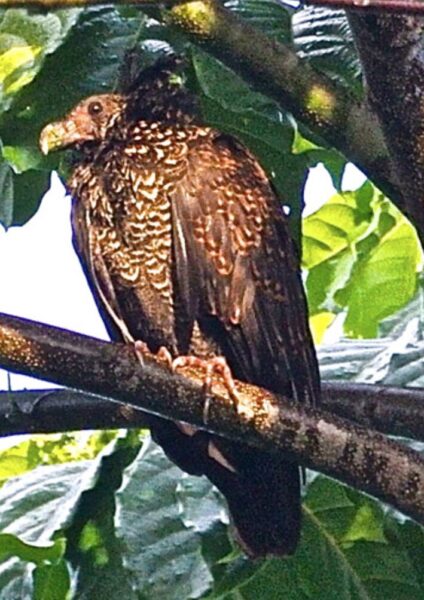
Bird sounds are like fingerprints
Sounds are critical identifiers for birds, and expert birdwatchers use sound more than sight to identify birds for their life lists. Birds call to attract mates, defend territory, and communicate with their young, and their calls are often as distinctive as fingerprints. That’s why bioacoustics has become an increasingly valuable tool in conservation, especially in hard-to-access areas.
A few researchers had previously attempted to use sound to find the endangered bird, but analyzing the data proved too difficult. Conservation officer Moeumu Uili, whose photo of a tooth-billed pigeon in 2013 is the last-known trace of it, admitted that "a significant gap remained in data analysis skills, limiting our ability to process results."
Colossal stepped in to address the issue. Using a five-minute audio clip of three tooth-billed pigeon calls recorded at Germany's Berlin Zoo in the 1980s, they created their AI algorithm. It analyzes recordings made in parts of the forest where the bird once lived. In a major breakthrough, it has identified 47 possible calls that offer hope that the Little Dodo may have survived.
While Colossal brings machine learning and acoustical analysis to the collaboration, the Samoa Conservation Society gives local knowledge and boots-on-the-ground support. Their team also installs and monitors the recording devices.
Verify the bird's existence is the first step to preserving its habitat and helping the population recover.
In the same way you can't prove a negative, "extinction" is always an informed guess. If we haven't seen hide nor hair (sometimes literally) of something for long enough, we have to assume it's not out there anymore.
But sometimes we assume wrong. Such was the case with the De Winton’s golden mole, which no one saw between 1936 and 2023, or the giant, elusive "ghost fish" of Cambodia's Mekong River. But finding these never-extinct-in-the-first place species is rare.
However, one more miracle reappearance has just occurred. Amid a global biodiversity crisis, the Asian small-clawed otter has emerged from hiding in Nepal to give otter enthusiasts hope.
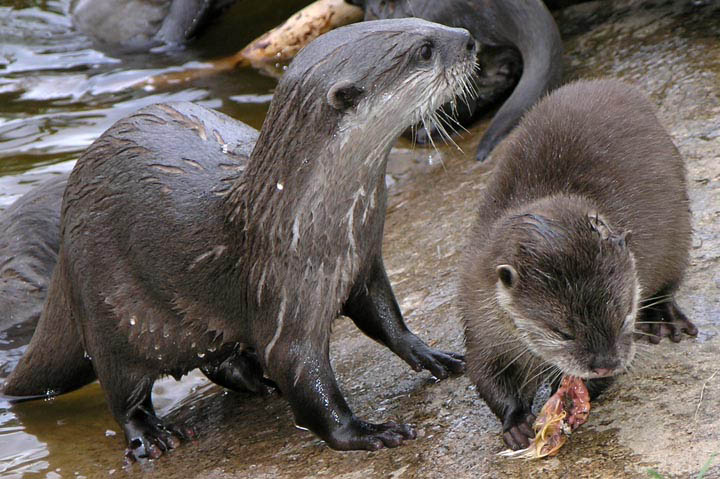
The otter of the hour
The Asian small-clawed otter (Aonyx cinereus) is the smallest otter species on the planet, weighing only 2.7 to 3.5 kilograms. Its short claws, which give it its name, make it particularly dexterous, helping it pry open the molluscs and crabs it feeds on. These otters are very social and friendly, mating for life and often traveling in large family groups.
They're adaptable too, and live in a variety of different environments, including mangrove forests, swamps, swift rivers, stagnant pools, and rice paddy fields. In fact, rice farmers consider them helpful to have around, since they eat crabs, which farmers consider pests.
Small-clawed otters still live across Southeast Asia and into India. The last time they were officially seen in Nepal was 1839, so it's no surprise that they were considered extinct there.
Over the past few years, visitors to Makalu Barun National Park in the eastern Himalaya have reported scattered, unverified sightings of the little otter. But it remained elusive until forestry officials stumbled upon it.
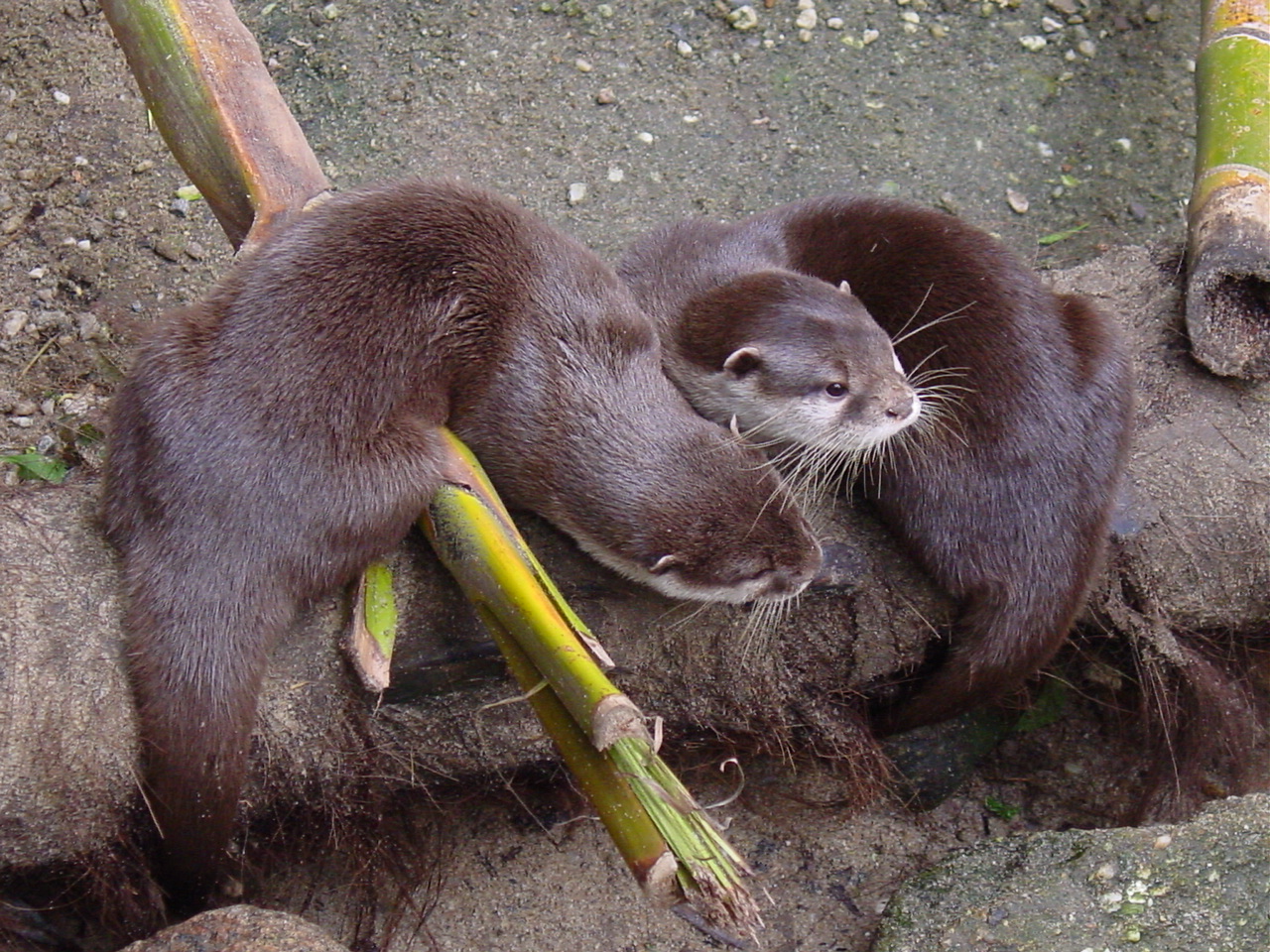
The once and future Asian small-clawed otter
A bulletin by the IUCN/SSC Otter Specialist Group announced the confirmed presence of the Asian small-clawed otter in Nepal. The discovery of a surviving Nepalese otter population came when a local from Dadeldhura village found an injured baby otter by the Rangun and Puntara Rivers. Not knowing the significance of the little creature, the local passed it on to local forestry officials.
The Forestry Officer, Rajeev Chaudhary, thought it might be a small-clawed otter. While he was nursing it back it health, he took photos and videos of the pup. Chaudhary then sent them to Nepalese otter experts at the IUCN Otter Specialist Group. They confirmed his suspicions and set about a habitat study in the area. Meanwhile, the pup in question recovered its strength and was released back into the wild.
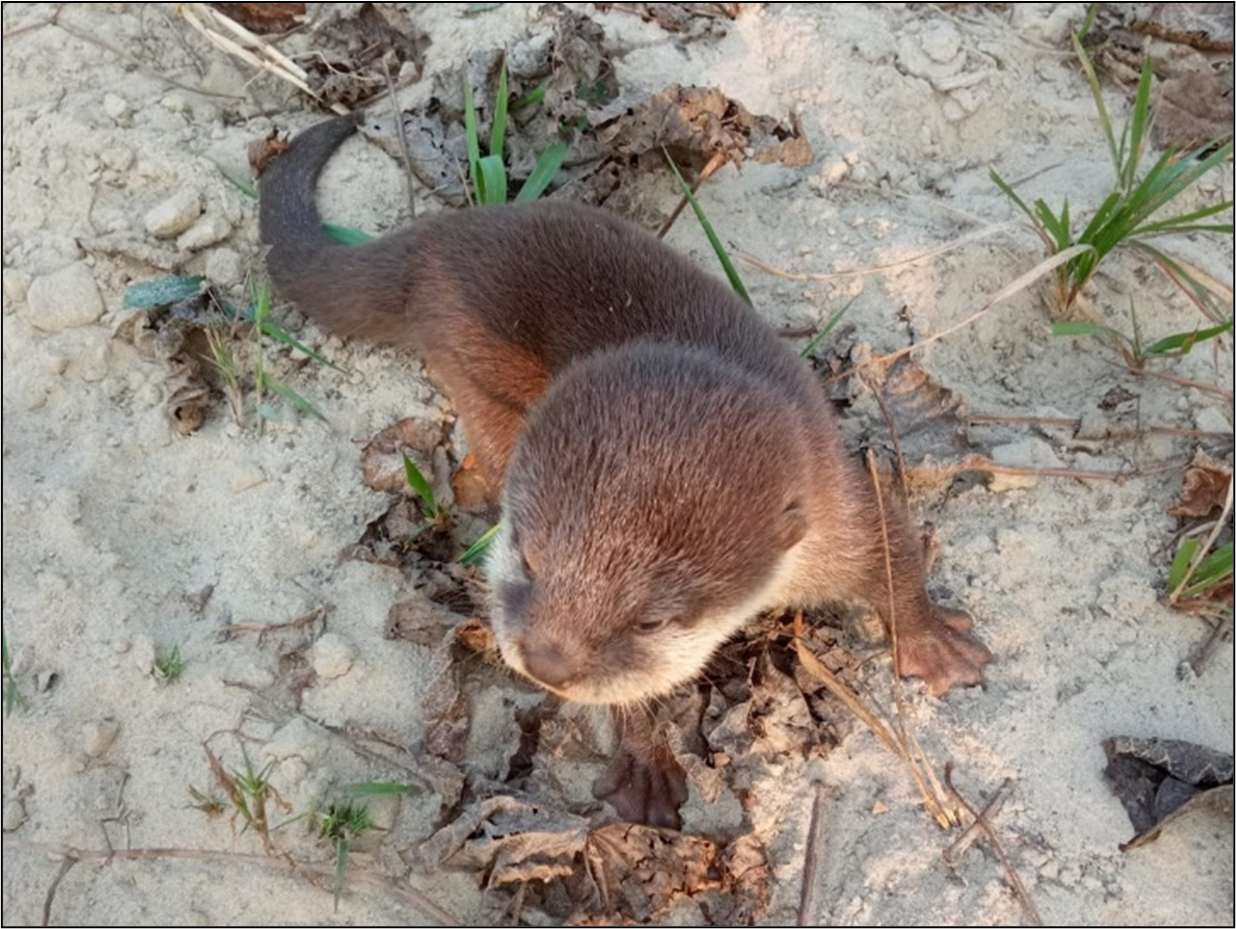
Asian small-clawed otters are listed as Vulnerable to Extinction. This discovery doesn't change that. The fact that these tenacious little otters are clinging on to their ancestral territory in Nepal is only more reason they need immediate support.
For one thing, they aren't on Nepal's Aquatic Animal Protection Act list. The river ecosystems they inhabit are threatened by mining, over-fishing, agricultural run-off, and deforestation. Getting official protection, now that they officially exist, is crucial.
"A timely conservation effort for this exceptionally rare species, a keystone aquatic mesocarnivore, is now urgently needed in Nepal," the IUCN bulletin concludes.
We are the worst primates when it comes to wound healing, according to a new study. Our wounds heal nearly three times slower than those of chimpanzees, our closest living relatives, and other primates and mammals.
Evolutionary biologist Akiko Matsumoto-Oda was watching wild baboons in Kenya when she noticed their wound-healing abilities. The monkeys could be very violent and aggressive with each other, and often sustained injuries.
“I was struck by how rapidly they recovered — even from seemingly severe wounds,” she told The New York Times.
Her intrigue triggered new research at how skin wounds heal in a controlled environment for various primates and mammals. The study included humans, chimpanzees, olive baboons, Skye’s monkeys, vervet monkeys, mice, and rats. The 24 humans were all volunteers and patients from Japan's University of the Ryukyus Hospital. All were having skin tumors removed.
The monkeys, rats, and mice came from various research facilities. Some had been injured in fights. A very few were anaesthetized and surgically wounded. “As a field researcher, I personally believe that invasive studies should be minimized,” Matsumoto-Oda explained.
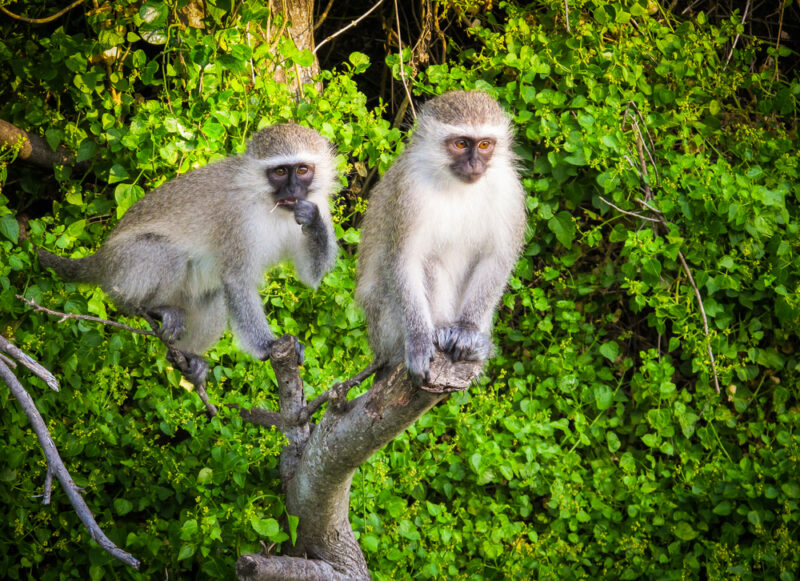
Human skin regrew 2.5 times more slowly
Humans regrew their skin at around 0.25mm per day, while the other primates and mammals exceeded this. Skin regrowth proceeded at approximately 0.62mm per day. The team discovered that there was no significant difference in the healing rate of the other primates or between the other primates and the rats and mice.
Why humans heal so much more slowly seems to lie in our evolutionary past.
“We found that chimpanzees exhibited the same wound-healing rate as other non-human primates, which implies that the slowed wound-healing in humans likely evolved after the divergence from our common ancestor with chimpanzees,” says Matsumoto-Oda.
The exact reason for this is unknown, but one possibility is our loss of body hair. Unlike most mammals, we developed a dense network of sweat glands to cool down more efficiently. This adaptation helped early humans survive in hot climates and allowed them to run and hunt over long distances without overheating. However, this trade-off came with a hidden cost.
Animals covered in hair are also covered in hair follicles, and these contain stem cells. Usually used in hair formation, these stem cells appear to give other mammals an edge when they have a cut or scratch.
A three-penguin race on Galindez Island, site of the Ukrainian Antarctic Expedition, concluded on Tuesday. The victory went to a newcomer to the racing scene, Unidentified Penguin #2. Unfortunately, no penguin equivalent of FastestKnownTime.com exists, but we encourage the penguin-loving community to create one.
Not professional racers
Penguin racing often flies under the radar. Averse to social media, many champion FPT-setters also have day jobs as penguins, doing penguin things like diving for fish. Fortunately, the Ukrainian Antarctic Expedition (UAE) filmed the first half of the Galindez Island race.
"This video is for those who still doubt that penguins are surprisingly fast creatures," wrote the UAE on Facebook.
In the video, the eventual winner races neck and neck with two other penguins. The three-penguin lead pack jostles for space. A large part of penguin racing appears to be strategy: when to waddle like a weird little windup toy versus coast on one's belly like a sled? Penguins can accelerate to 6kph on their bellies, but navigating difficult ground requires a combination of the two modes of transport.
Penguins are even faster in water, reaching speeds of 36kph.
The purpose of the race remains unclear
While setting the FPT on Galindez Island is a worthy goal, the exact nature of this race has not been confirmed.
"This trio must have had extremely important things to do," the UAE suggested. "Was it krill again at a discount, or did they bring a truckload of pebbles from a neighboring island?"
Penguins are very social birds, nesting in large groups and often mating for life. A penguin in veterinary care at the Perth Zoo made headlines in 2021 for its investment in watching episodes of Pingu on an iPad. And in Japan's Tobu Zoo, a penguin captured the internet's heart by apparently falling in love with a cardboard cutout of an anime character.
Still, documented evidence of racing on land is a rare treat.
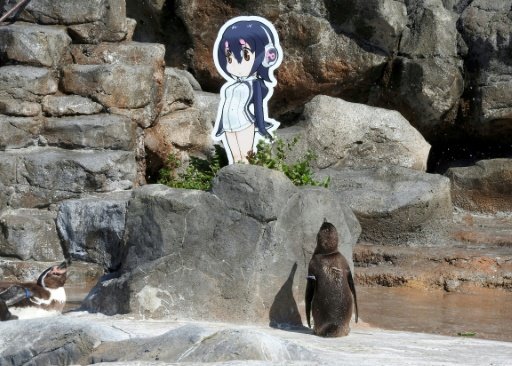
Each spring, the Farne Islands off England's Northumberland coast transform into a seabird heaven, with puffins center stage. This year, to mark the 100th anniversary of the National Trust's stewardship of the islands, two webcams have been set up so that anyone can watch the charismatic little birds.
The archipelago hosts approximately 200,000 seabirds each year, including 50,000 breeding pairs of puffins. Each spring, they return from their winter haunts to nest in the same burrows they've used for years.

The first camera sits beside the puffin burrows. Initially, you will likely see male puffins trying to defend their territory. As we head into July, young pufflings will start to appear. The second camera will show the cliffside, where over 20 species of seabird that breed on the islands, including guillemots, shags, kittiwakes, razorbills, and peregrine falcons, cohabit with the puffins.
Each year, conservationists monitor the puffin population by gently extracting them from their burrows and weighing and measuring them. From 2020 to 2024, this work paused because of the pandemic and various avian flu outbreaks.
A stable population
The 2024 count revealed a relatively stable puffin population, which offers hope amid the dwindling numbers of other seabird species. Some, such as European shags and arctic terns, have suffered significant losses because of disease and severe weather.
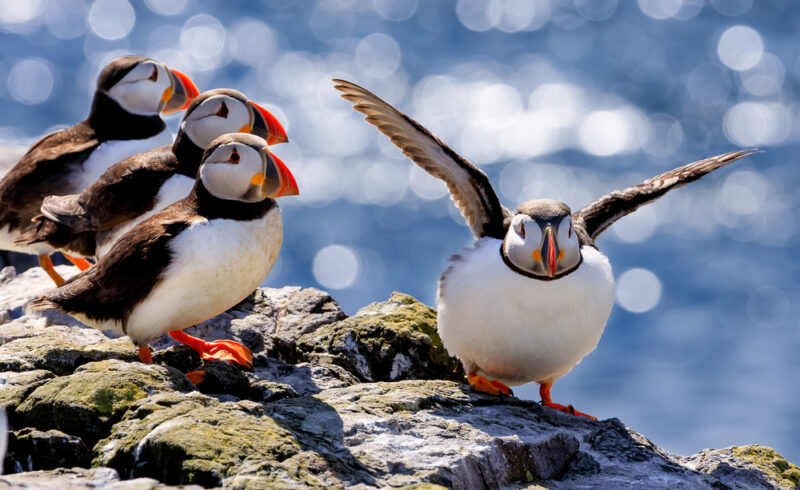
Beyond the Farne Islands, the Alderney Wildlife Trust in the Channel Islands has also set up live streams from its puffin colony on Burhou Island. Similarly to the Farne Islands, they have two cameras. Their Puffin Main Cam and Burrow Cam should capture the daily activities of the birds, from burrow maintenance to feeding routines.
Despite the positive signs, puffins continue to confront numerous threats. Climate change, marine pollution, and overfishing all create hardships. Researchers have begun tagging puffins for an in-depth study of their lifespans and migration patterns to better understand the threats the colorful little birds are facing.
Scientists have discovered two unknown species of crocodile on islands off Mexico's Yucatan Peninsula. They were always assumed to be American crocodiles (Crocodylus acutus), but new genetic testing proves they are distinct.
Researchers from McGill University and collaborating Mexican institutions found that the isolated crocodiles differed in several ways from their mainland relatives.
"The results were totally unexpected," said lead author Jose Avila-Cervantes in a statement. "We assumed Crocodylus acutus was a single species ranging from Baja California to Venezuela and across the Caribbean."
The two yet-to-be-named new species live on Cozumel Island and the Banco Chinchorro atoll. Their isolation caused them to adapt to their unique environments, beginning about 11,000 years ago.
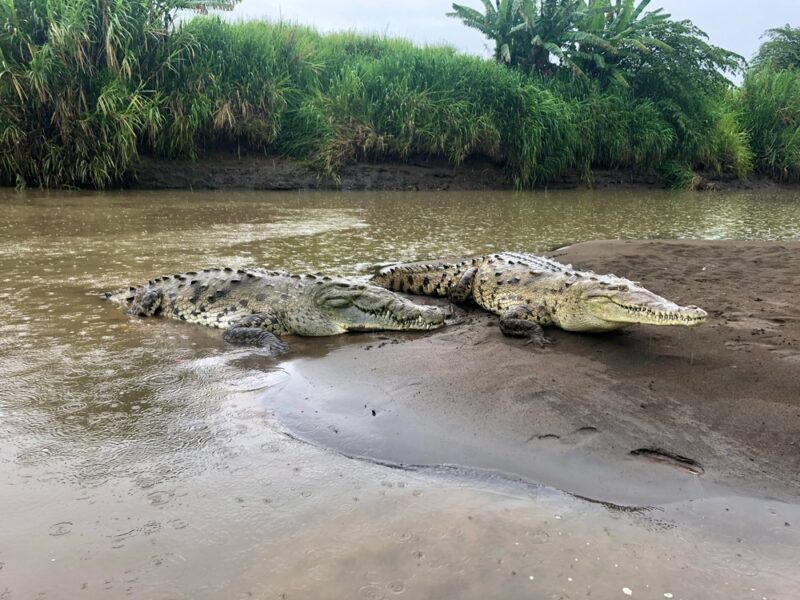
Besides DNA disparities, physical exams revealed noticeable differences in skull shape and scale patterns. The Cozumel crocodiles have long and narrow "longirostrine” snouts that may be an adaptation for catching specific prey. Meanwhile, the Banco Chinchorro crocodiles have broader skulls that help them crush hard-shelled prey.
Each population contains fewer than 1,000 breeding individuals, and their restricted habitats make them susceptible to climate change and human activities, such as coastal development.
For centuries, the Yangtze porpoise was a common sight on the river it is named after. Now, the freshwater mammal is critically endangered, rarely sighted, and only found in a tiny proportion of the huge waterway that winds from the Tibetan Plateau to the East China Sea. To track the species' decline, researchers have turned to an unusual source— ancient Chinese poetry.
Researchers analyzed 724 ancient Chinese poems that referenced the Yangtze porpoise. Some date back to the Tang dynasty (618–907 CE). Penned by scholars, emperors, and poets who often traveled along the Yangtze, the poems provide vivid accounts of the porpoise's presence and behavior.
“Our work fills the gap between the super long-term information we get from fossils and DNA and the recent population surveys," said Zhigang Mei, co-author of the new study. "It really shows how powerful it can be to combine art and biodiversity conservation.”

Harming the porpoise was bad luck
The Yangtze finless porpoise holds an important place in Chinese folklore. Mei remembers the elders in his community speaking of them as spirits, believing they could predict weather changes and good fishing. Harming the creature was considered bad luck. This is perhaps why they featured so heavily in ancient poetry.
To ensure accuracy in the poem's content, the researchers cross-referenced the information in the poem with what they knew about that author's life. They identified where each poet lived and traveled to ensure that it matched the information within their poems. This approach allowed them to extract reliable ecological data from the verses.
Using the poems with historical records, they mapped the porpoise's distribution across different dynasties. Poems from the Qing dynasty referenced the porpoises 477 times, whereas they appeared slightly less in earlier periods.
Despite this, there was a clear pattern. Over time, a sharp decline in porpoise sightings has occurred. Tributaries and lakes associated with the river had a 91% decrease; the main river channel had one-third fewer. Overall, the findings reveal a staggering 65% reduction in the porpoise's habitat over the last 1,400 years.

Causes of decline
Poets like Emperor Qianlong of the Qing dynasty often described the porpoise's playful antics, especially its tendency to leap from the water in stormy weather.
“Compared to fish, Yangtze finless porpoises are pretty big, and they’re active on the surface of the water, especially before thunderstorms when they’re really chasing after fish and jumping around,” explained Mei. "This amazing sight was hard for poets to ignore."
Since the 1950s, new dams have made huge sections of the river inaccessible to the porpoises. Pollution and fishing have also affected the porpoise populations.
With fewer than 1,800 freshwater porpoises left in the river, conservationists are worried they will follow the same path to extinction as their cousins, the Yangtze River dolphin.
“Protecting nature isn’t just the responsibility of modern science; it’s also deeply connected to our culture and history,” said Mei in a statement. "Poetry can really spark an emotional connection, making people realize the harmony and respect we should have between people and nature.
A bird once declared extinct in the wild has just laid eggs in Hawaii.
The sihek, also known as the Guam kingfisher, has a striking burnt orange breast, electric blue wings, and a sharp beak. Native to the island of Guam, the tiny birds thrived until the accidental introduction of the brown tree snake in the mid-20th century. Sihek populations plummeted. By 1988, the bird was declared extinct in the wild.
The sihek became a feathered example of what can happen when an invasive species runs wild. The bird didn’t vanish entirely because of a last-minute rescue operation. Conservationists captured 29 of the remaining siheks and began a careful breeding program.
Several institutions have been raising siheks for the last few decades, trying to increase their numbers. Last year, some donated eggs to a special facility at the Sedgwick County Zoo in Kansas. Here, the hatchlings were cared for until they were old enough to journey to the atoll.
Researchers released nine of the hand-reared siheks in September 2024. They were rewilded in The Nature Conservancy’s (TNC) Palmyra Atoll Preserve, which lies around 1,600km south of Honolulu. They chose this area because the birds have no predators there, and the area is fully protected.
One lonely male
The four females and five males formed four breeding pairs. (One lonely male didn't have a mate.) Less than a year later, all the pairs established territories, built nests, and laid eggs in the wild for the first time since the 1980s.
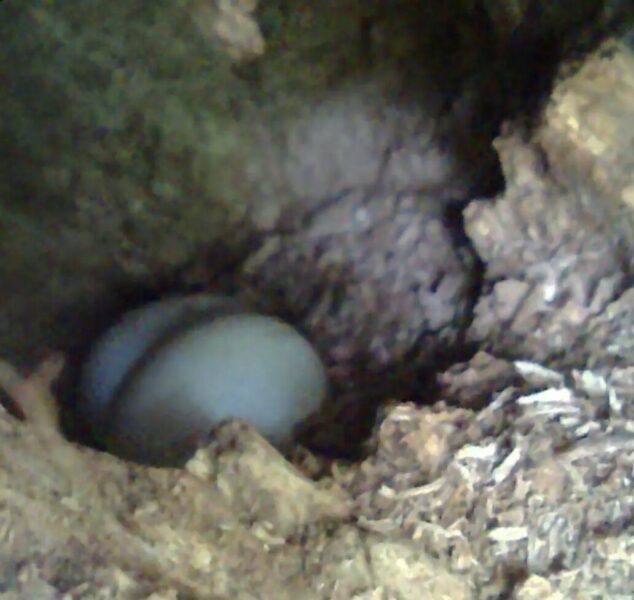
“This is a huge win," said John Berry of the Cincinnati Zoo. "It means the birds are not just surviving—they’re beginning to thrive.”
Though everyone is excited about the new eggs, they also admit it is very unlikely that they will survive. The mating pairs are less than a year old and have never had to care for eggs and incubate them before. It often takes a few attempts at laying and looking after eggs for them to actually hatch.
Conservationists are now planning to release more young siheks onto the atoll later this year.
Forget the latest Netflix and Amazon Prime offerings -- right now, one of the hottest shows on the planet is a 24/7 live-stream of moose slowly migrating through the Swedish wilderness.
Dubbed The Great Moose Migration, this unlikely sensation is exactly what it sounds like. Hours of footage show moose slowly plodding through forests and wading across rivers. Viewers can’t get enough.
Broadcast by SVT (Sweden’s public broadcaster), the event was first live-streamed in 2019. It was created as part of a wider "Slow TV" movement showing real-time footage of mundane activities; think knitting and train rides. Unlike other shows, there is no backing music, commentary, or editing. It is exactly what is caught on camera. What started as a quirky local experiment quickly became a hit. A million viewers tuned in during the first year. Last year, that had increased to nine million.
Deeply soothing
It seems there is something deeply soothing about watching the slow, lolloping animals wander through a pine forest along this ancestral route to their summer grazing spots. With 26 remote cameras and seven night cameras, the show cuts between the various spots to show what is happening. For large swathes of time, there may be no moose in the shot at all.
Despite this, some viewers watch for almost 24 hours a day. Others admit to setting up separate screens so that they can have it on in the background as they work. Mega-fan Ulla Malmgren said she had purposefully stocked up on snacks, pre-prepared meals, and coffee so that she could watch the 20-day migration.
Due to unseasonably warm weather, this year's migration started a week earlier than usual, but fans were ready. Some 77,000 are part of a Facebook group that provides updates on the migration. It is expected to last until May 4. With panoramic shots, long silences, and the occasional splash as a moose crosses a river, the live-stream is oddly hypnotic.

Long lulls
SVT puts out notifications on their app when a moose appears on camera, so viewers don’t miss the excitement. Sometimes, hours pass with nothing but swaying trees and chirping birds. Then, suddenly, a moose appears — and the chat explodes with excitement.
The live stream focuses on a key stretch of the annual route in northern Sweden, where the animals are funneled toward a few river crossings. There are around 300,000 moose in Sweden, but they are notoriously shy creatures.
“We actually don’t see them very often,” explained SVT project manager Johan Erhag. "I think that’s one reason why it has been so popular. You bring nature to everyone’s living room."
So if you’re looking for a way to de-stress, or just need a weirdly captivating distraction, consider tuning in. No plot, no dialogue, just moose.
BY RACHELLE SCHRUTE
In a groundbreaking leap reminiscent of Jurassic Park, scientists have successfully revived the dire wolf, an apex predator that vanished nearly 13,000 years ago.
The revival project, spearheaded by startup company Colossal Bioscience, used advanced DNA editing techniques. By sequencing ancient DNA samples recovered from fossils preserved in tar pits, researchers reconstructed a complete genome of the dire wolf, closely related yet distinctly separate from modern grey wolves.
Two male pups, Remus and Romulus, were born in October 2024, followed by a female named Khaleesi in January 2025. Fans of HBO’s Game of Thrones will likely recognize both the creature and the inspiration behind their names.
But are these really dire wolves or just genetically modified grey wolves? That “grey” area is up for interpretation.
While Stanford led the genetic effort, biotech startup Colossal Biosciences played a pivotal role in bringing the project to life. Known for its mission to resurrect the woolly mammoth, Colossal provided logistical support, funding, and proprietary gene-editing tools that accelerated the dire wolf program.
Colossal’s involvement also sparked public curiosity, thanks in part to its high-profile partnerships and unapologetically bold marketing. I mean, just take a look at the company’s website. It’s hard to decide whether it’s legit or a carefully crafted sci-fi movie promo.
CRISPR to the Rescue
Using CRISPR (Clustered Regularly Interspaced Short Palindromic Repeats) technology, the team introduced precise genetic edits into embryos of modern wolf relatives, effectively recreating dire wolf traits. After several attempts, the first litter of dire wolves was successfully born last fall in a controlled facility in Montana.
These animals are designed to thrive in rugged, challenging environments. The project’s next step involves assessing their viability in protected wilderness areas.
Dire wolves, once dominant across North America, were notably larger and sturdier than today’s wolves, capable of taking down massive prey such as bison and giant sloths. Their reintroduction could radically reshape modern ecosystems, presenting both exciting opportunities and ecological challenges.
The project has sparked vigorous debate within the conservation community. Supporters view it as a monumental achievement in species restoration, while skeptics caution about potential risks to existing wildlife.
Are they actually dire wolves?
This article first appeared on GearJunkie.
When you think of dangerous animal encounters and surfing, you immediately think of sharks. But something completely unexpected attacked RJ LaMendola when he was surfing off Oxnard, California. Around 140 meters from shore, a sea lion chased him down and bit him.
Showing highly erratic behavior, the animal charged at him with alarming speed, mouth agape, and eyes locked onto him. Despite his efforts to evade the deranged sea lion, it bit him on the left buttock, dragging him off his surfboard and into the water. LaMendola managed to fend off the attack and paddle back to shore, where he sought medical attention.
Posting about the incident on Facebook, LaMedola said, “It started as an ordinary session…The ocean was calm, the rhythm of the swells familiar — until, out of nowhere, a sea lion erupted from the water, hurtling toward me at full speed…My heart lurched as I instinctively yanked my board to the side, paddling frantically to evade it as it barrelled forward, intent on crashing into me.”

Continued the attack
Even after the sea lion bit him and wrenched him from his board, it continued to pursue him as he tried to get back to shore.
“Its expression was feral, almost demonic, devoid of the curiosity or playfulness I’d always associated with sea lions,” he recalled.
Back on land, LaMendola drove himself to the hospital where the bite was treated. It should heal fully, but LaMendola is still shaken and concerned about getting back into the water. He contacted local wildlife authorities to report the incident. The attack comes amidst a growing number of incidents involving sea lions and dolphins in Santa Barbara and Ventura County. It highlights a growing environmental crisis along the California coast.
Sea lions and other marine mammals are displaying unprecedented aggression due to domoic acid poisoning. Harmful algal blooms flourishing along the coastline release a neurotoxin called Pseudo-nitzschia. The toxin accumulates in fish like anchovies and sardines, which are primary food sources for sea lions and dolphins. When these marine mammals chow down on the contaminated fish, they take in the toxin, which affects their brains and leads to seizures, disorientation, and aggressive behavior.
A deadly plague
The current algal bloom has had devastating effects on marine life in Southern California. The Marine Mammal Care Center in San Pedro is caring for over 140 sick sea lions, with a further 45 at the Pacific Marine Mammal Center and another 15 at SeaWorld San Diego. Wildlife authorities in the area are being inundated with calls about dolphins and sea lions washing up on shore. Though they can treat poisoned sea lions, the same cannot be said for dolphins. Vets have to euthanize the beached cetaceans, as they rarely survive domoic acid poisoning.
These toxic blooms are worsening due to warming oceans and agricultural pollution. In 2023, thousands of marine mammals died, and this year's algal blooms could be even more devastating.
The birds of the Galapagos Islands gave Darwin some of his best evidence for evolution. Now some of those birds have evolved an extreme dislike of all the noise of this increasingly busy tourist destination.
A new study suggests that traffic noise affects the behavior of the Galapagos yellow warbler. The little yellow birds are altering their songs, and the males have become more aggressive. Think of it as the avian version of road rage.
Birdsong is a crucial tool for male warblers to defend territories from rivals. External noises, such as traffic, hamper the effect of their songs. Rather than fend off competitors with their vocal stylings, the little birds resort to physical aggression instead.
Researchers from Anglia Ruskin University and the Konrad Lorenz Research Center carried out experiments at 38 sites across the islands of Floreana and Santa Cruz. Researchers played recorded bird songs in all those locations, mimicking an intruder. Some songs had accompanying traffic noise, and others did not. The responses varied significantly based on how close the birds lived to the road noise.

Change of tune
Warblers near roads were aggressive when the combined sounds of rival bird songs and traffic played. They approached the source of the sound, increased their physical displays, and prepared to fight. By comparison, birds in quieter, more remote areas showed far less aggression. Researchers believe this is due to their unfamiliarity with traffic noise.
The warblers also changed their singing because the traffic noise masked their normal birdsong. To counteract this, the clever birds adjusted the frequency of their singing so that their calls were still audible over ambient traffic.
“We have to think about noise pollution even in places like the Galapagos,” co-author Çaglar Akçay told The Guardian. "The results of the study are clear: Human-induced noise pollution is affecting wildlife behavior, even in remote and protected regions like the Galapagos."
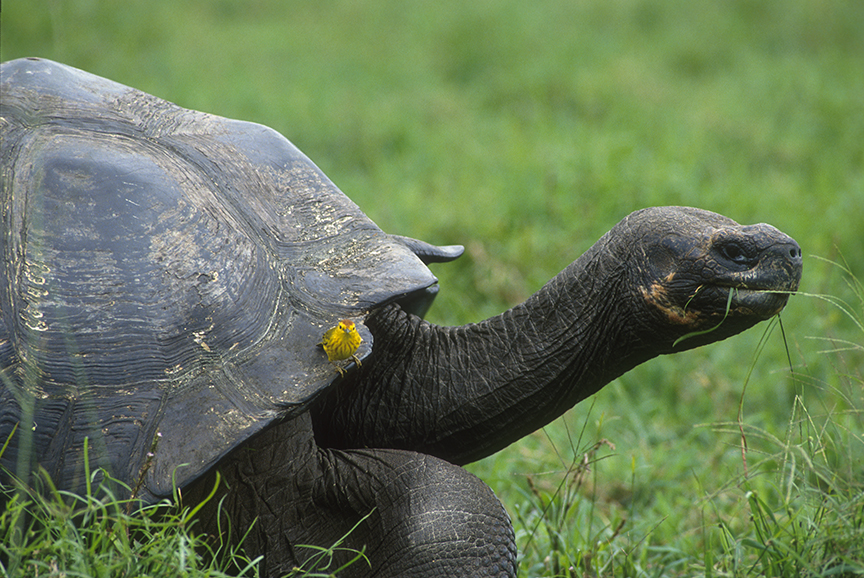
Shark researchers at Australia's University of Auckland were surprised recently to see an orange octopus perched atop a mako shark. They sent up their drone and captured a delightful if mystifying video.
'Sharktopus'
The research vessel was near the northern coast of New Zealand, studying shark feeding, when they spotted a large short-fin mako shark just underwater.
The patch of orange on top of its head confused them. Marine scientist Rochelle Constantine initially thought they were seeing a shark entangled in fishing gear. They sent up a drone to look closer, and that's when they realized the orange blob was a living animal.

The Maori octopus is one of the biggest octopuses in the southern hemisphere and can weigh 12 kilograms fully grown. Known for being rather ill-tempered and aggressive, they usually live on the seabed. Mako sharks, meanwhile, prefer shallower waters. The two species shouldn't even have met, yet alone interacted in this peculiar way.
The "sharktopus," as the amused researchers dubbed it, is a previously unrecorded phenomenon. Octopuses are famously intelligent, enough to work cooperatively with other species, and may act as strict leaders of mixed fish-octopus hunting parties. But researchers aren't sure whether the octopus intended to ride on a shark's head.
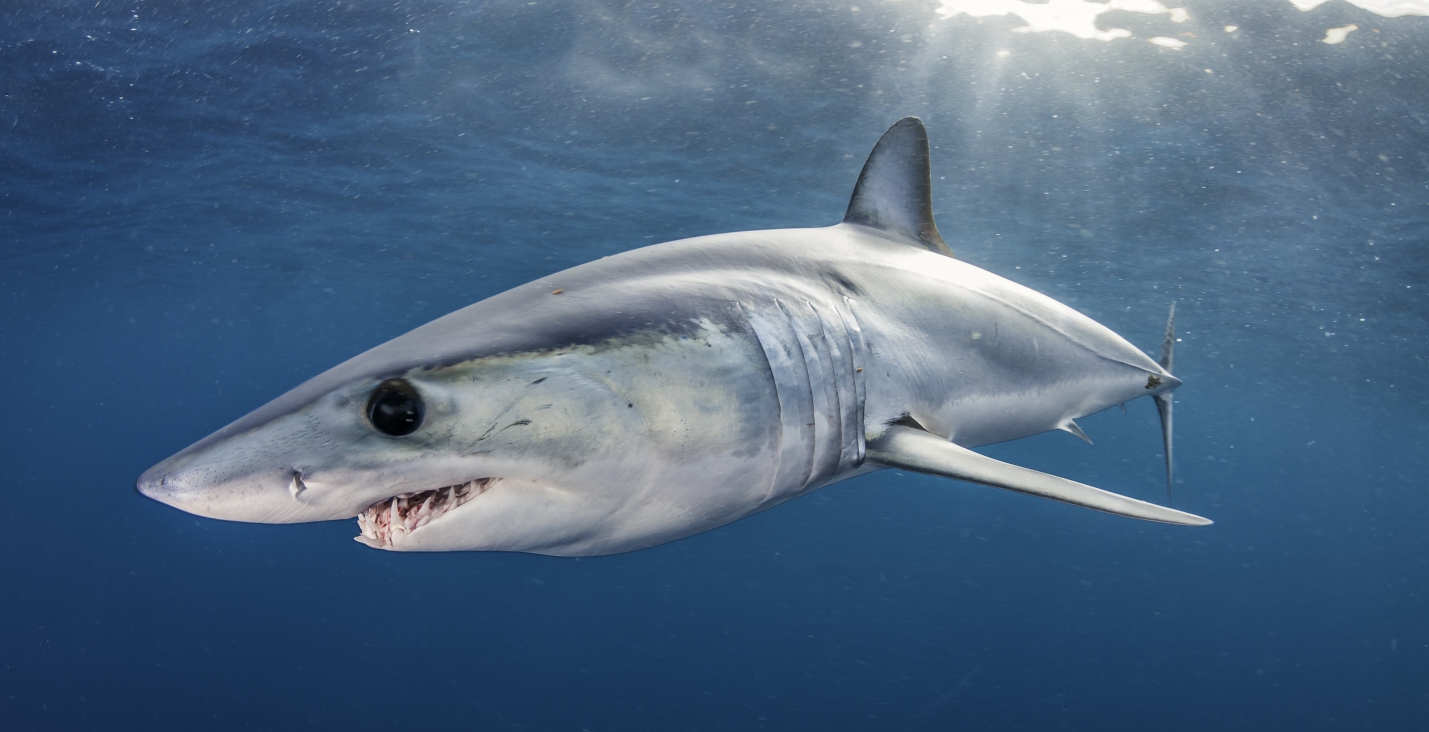
World's fastest shark
Like many octopus species, the formidable Maori octopus has a paralyzing neurotoxin that it uses to hunt. It can grow up to a meter long and may go after larger animals than itself, grasping with its strong, thick arms.
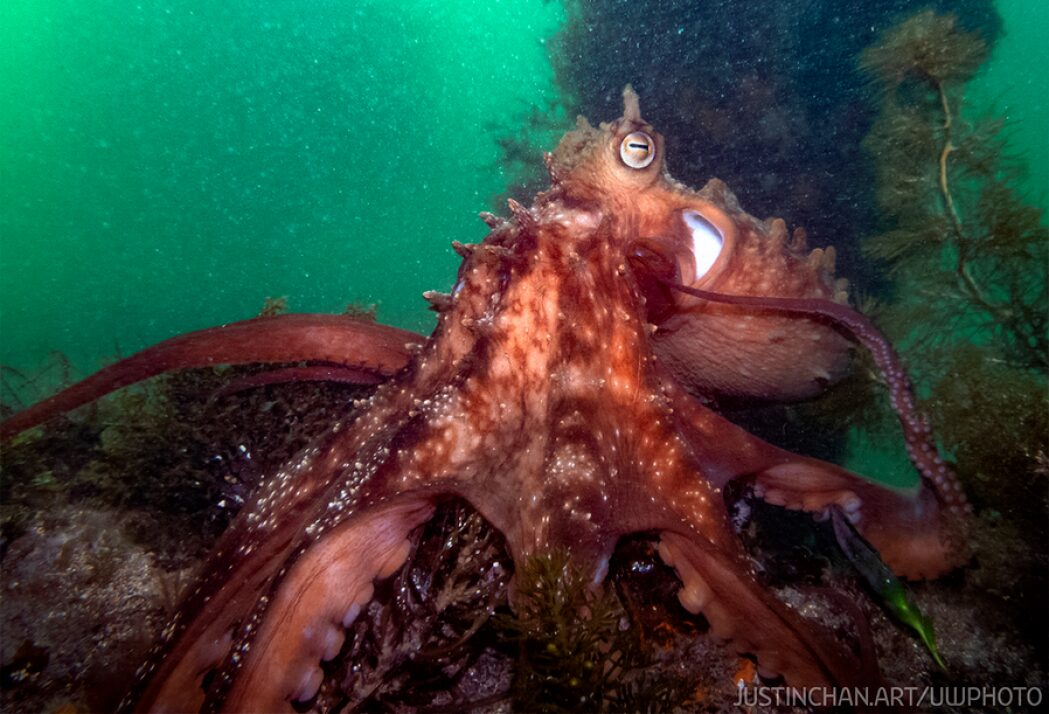
Not mako shark large, though. Also known as the blue pointer or bonito shark, the shortfin mako can be up to four meters long and 570 kilograms. They are also the world's fastest shark, hitting speeds of up to 50kph. The Maori octopus would have to make full use of its strong arms to hold on for dear life.
The Gulf where they recorded the sharktopus is considered an important shark conservation area. It is the home and breeding ground of many shark species, including the endangered shortfin mako. For Constantine, the encounter is a reminder of the mystery and wonder of the ocean.
Millions of years ago, a group of adventurous iguanas did something no one expected. They crossed the Pacific Ocean from the Americas to the islands of Fiji on giant rafts of vegetation.
The iguanas in Fiji and Tonga have always been an evolutionary puzzle. Iguanas are native to the Americas and the Caribbean, but somehow millions of years ago, a small group of them made it all the way to Fiji. There was never land bridge between the two distant places. So how on Earth did they get there?
Evolutionary biologist Simon Scarpetta of the University of San Francisco and his colleagues think they have solved the mystery. They believe the reptiles caught a lift across the ocean on a platform of trees, plants, or debris. These rafts occasionally break off from coastlines and drift out to sea as floating islands. Animals on them may wind up in new and unexpected destinations. In the case of the Fijian iguanas, researchers believe they made a record-breaking trip by drifting over 8,000km across the Pacific Ocean.
“You could imagine some kind of cyclone knocking over trees where there were a bunch of iguanas and maybe their eggs, and then they caught the ocean currents and rafted over," Scarpetta told The New York Times.
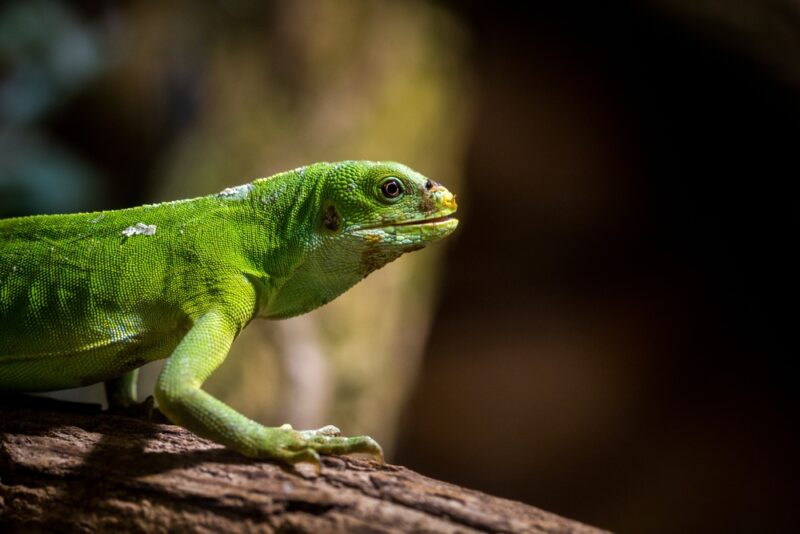
Masters of survival
It is quite rare for vertebrates to survive such trips. But iguanas can go weeks without food or fresh water, making them well-suited for long voyages of deprivation. They have been seen rafting before, but their journeys have never been this long. In 1995, a group of about 15 iguanas were spotted hitching a ride 320km between Caribbean islands aboard hurricane debris. The team thinks their slow metabolism and rainwater allowed them to survive the incredibly long journey to Fiji.
There have long been two hypotheses about these out-of-place reptiles. First, that they rafted over from the Americas; and second, that a now-extinct ancestor drifted over from Asia or Australia.
Scarpetta and his team studied the evolutionary history of over 200 species of iguanas and lizards. The four species in Fiji are most closely related to the desert iguanas of Mexico and the American Southwest. That is clearly where they came from, although the timing of their great voyage remains uncertain.
"This suggests that as soon as land appeared where Fiji now resides, these iguanas may have colonized it," Scarpetta said. "Regardless of the actual timing of dispersal, the event itself was spectacular."
Hummingbirds are famously the smallest birds in the world, but they are also surprisingly aggressive with each other. Because they are so territorial, you would never think of them as living amicably in colonies. Yet one unusual species in Ecuador is nesting in colonies in the High Andes.
When ornithologist Gustavo Cañas-Valle stumbled upon this fraternization among the Chimborazo Hillstar hummingbirds, he couldn’t believe his eyes.
“It was mind-boggling," he said in a statement. "Finding them nesting in the same location was amazing. Then I realized that males and non-reproductive females were also roosting in the same space as reproductive females." That, he said, was even stranger.
Hummingbirds are especially territorial during feeding and nesting. Females typically nest alone, while males ferociously defend their territories, sometimes to the point of fatal confrontations. The discovery of these hummingbirds that are so chummy with each other suggests that they have adapted because of environmental pressures.
Not like penguins
“Hummingbirds are not a species like penguins where you see hundreds of them together,” co-author Juan Bouzat explained. "These are hummingbirds that live in the High Andes, above 10,000 feet, in a very, very harsh environment above the tree line."
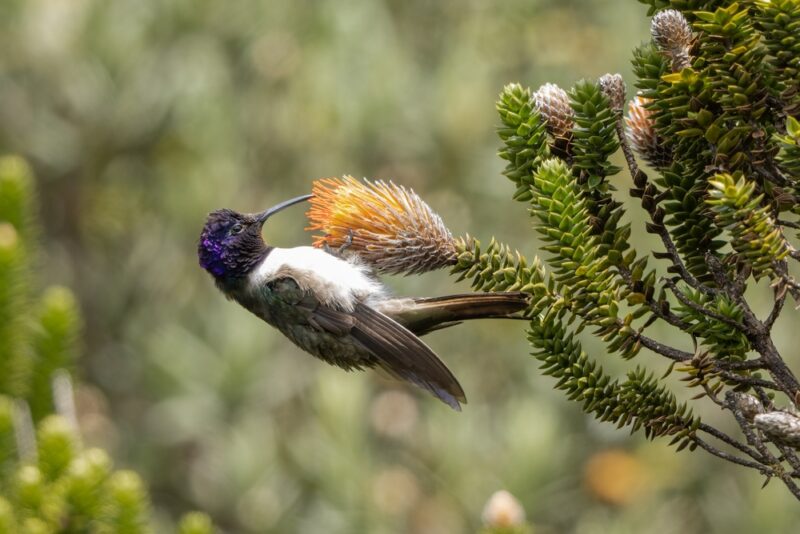
Cañas-Valle identified 23 adult birds and four chicks nesting and roosting within a single cave. This particular cave sits over 3,600m above sea level. Nearby vegetation is almost nonexistent, shelter is sparse, and temperatures at that altitude can be frigid despite its location on the equator.
Cañas-Valle and Bouzat wanted to determine whether this sociability was solely due to the harsh conditions and a lack of nesting sites or if it also occurred elsewhere.
The research duo scoured the area, identifying several places where solitary nesting would be possible. While some were in use, a large proportion were not. Instead, 80% of the active nests they found were within colonies. The study suggests that the birds prefer to live together rather than were forced to.
Bird colonies usually exist because the individuals benefit from living together.
“Somehow, they get a benefit...from the social group,” said Bouzat.
Exchanging information?
What that benefit is remains up for debate. Cañas-Valle regularly saw hummingbirds leaving and returning to the cave together. He speculates that the members of the colony may be exchanging information about the location of food and mates.
The situation is so unusual for hummingbirds that some experts question whether the birds are actually showing colonial behavior. Cañas-Valle and Bouzat understand the skepticism. Cañas-Valle joked that it took years just to convince his colleague.
“It took me probably two years for Juan to say, ‘Well, Gustavo, you convinced me. We can call this gathering of nests a colony from now on,’” he said. “I was thinking,’ Finally.’ That was a priceless moment.”
Disease tops nobody's list of Antarctic dangers. "The great advantage of this place is that one never gets ill," said Robert Falcon Scott. His contemporary, Douglas Mawson, even suggested that the icy continent would be an ideal place for tuberculosis sufferers to recover due to the lack of germs.
A lot can change in a hundred years.
Deadly new strain
It's been over five years since a new, deadly strain of Avian flu, called HPAI H5N1 clade 2.3.4.4b, began decimating global bird populations. There have been significant outbreaks in the UK, Europe, South Africa, and the Americas. The disease targets not only birds but also pinnipeds like seals, walruses, and sea lions. Last year, it finally landed on the Antarctic Peninsula.
But scientists could do nothing, not even monitor the situation. During the long, black winter, they were unable to study the progress of the disease. As soon as conditions allowed, a research team about the Australis crossed the Drake Passage into Antarctic waters. They were led by Spanish virologist Antonio Alcamí, who had identified the first case a year earlier.
The ship, equipped with a state-of-the-art lab, visited dozens of sites along the peninsula's coast and in the Weddell Sea. What they found wasn't encouraging.

Widespread infection
In total, they collected and tested 846 samples, and 188 tested positive for H5N1. The infected animals were from nine bird and four seal species. The animals they tested had a high viral load, making them highly infectious to other animals around them. Carcasses, especially, are a vector, and because of this the skua, a carrion-bird, has been especially hard hit.
The disease has spread geographically, too. The virus was present in 24 out of 27 sites they visited, ranging down the arm of the peninsula and across various Antarctic and subantarctic islands, including South Georgia. The older infections were on the north side of the peninsula, where visitors observed lower populations, especially of the skuas. On the south side, the outbreak is more recent, and visitors can see dead and dying seabirds.
No infections have been confirmed on the Antarctic continent beyond the peninsula, but that doesn't mean H5N1 isn't there. Researchers have already observed unusual mortality among bird populations further east along the Princess Astrid Coast.
Along with the skua, crab-eater seals have been particularly affected by recent outbreaks. On Joinville island, where crab-eaters are common, the local population was devastated.
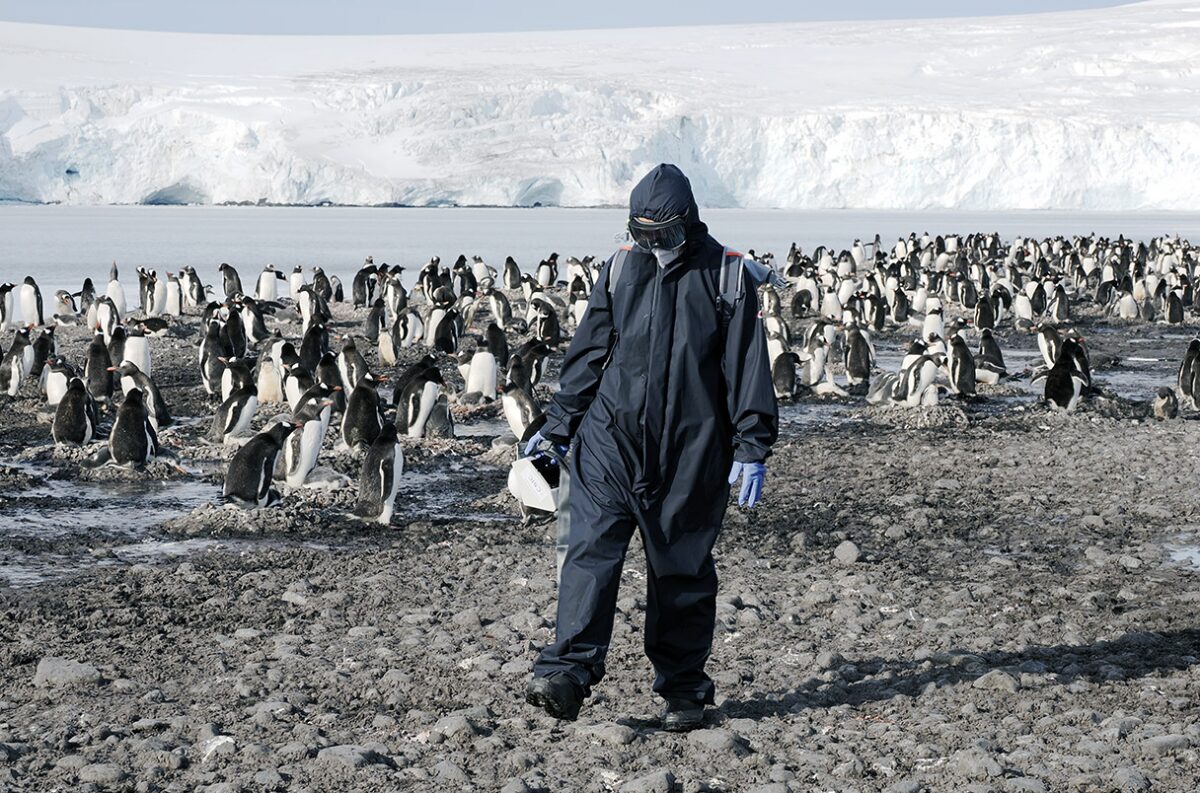
What about penguins?
One animal that hasn't been dying off is penguins. Both Adelie and Gentoo penguins have tested positive for the virus, but many infected individuals appear healthy. The virus is so thick in the air at their colonies that the researchers detected it using an air pump.
There were some suspicious penguin die-offs last year, which researchers think may have given the surviving birds immunity.
This is good news for penguins but presents a substantial risk to human visitors. Avian flu can infect humans who come in contact with infected birds. Of all Antarctic birds, the cute and friendly penguin is most likely to approach, or be approached, by humans.
The Scientific Committee on Antarctic Research (SCAR) established the Antarctic Wildlife Health Network database to monitor the spread. According to SCAR President Yeadong Kim, they are "deeply concerned with the evolving situation" in Antarctica.
With the fall of Antarctica, Australia is now the only uninfected continent.
Perched 44 meters up in a Jeffrey pine tree in California, two bald eagles have become the stars of a live-streamed saga. Earlier this week, the pair -- nicknamed Jackie and Shadow -- became new parents to two tiny eaglets while thousands of people tuned in to watch.
The non-profit Friends of Big Bear Valley (FBBV) installed high-definition cameras near the eagles' nest to give an unfiltered view into their world. Positioned discreetly to avoid any disturbance, these cameras operate around the clock.
Jackie and Shadow's journey has been anything but smooth. In previous years, viewers have watched ravens scavenge their eggs and harsh weather conditions thwart their breeding efforts. In both 2023 and 2024, Jackie laid eggs but they didn't hatch. Despite these setbacks, the pair rebuilds their nest for each breeding season, and every year, more viewers tune in.
Jackie has laid three eggs for the second year in a row, shocking experts.
“I’m very excited and a little bit surprised,” Sandy Steers, executive director of Friends of Big Bear Valley, told the Los Angeles Times. "Last year, it happened for the first time, and it’s so rare to have her lay three eggs again."
Since early March, viewers have waited impatiently to see if any of the eggs will hatch. In general, only 50% of bald eagle eggs hatch. This is often due to the high altitude, low oxygen, and cold temperatures. This year, Jackie and Shadow beat the odds.
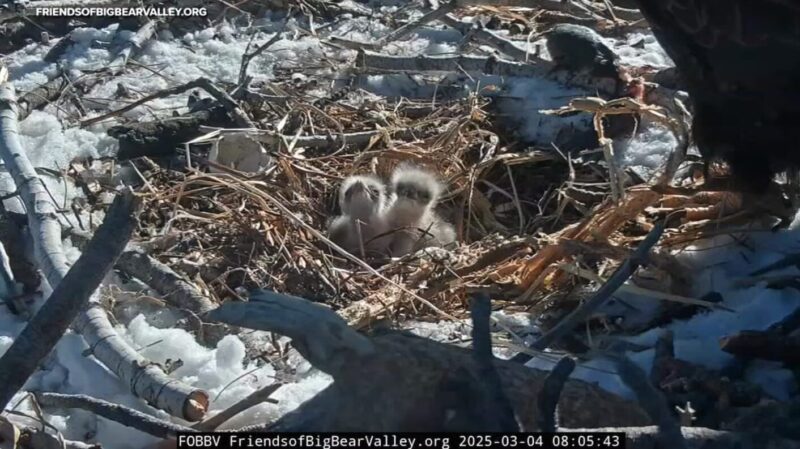
Cracks appear
Cracks started to appear in one of the eggs on March 2. Although it's been three years since her last chick, Jackie immediately knew what was happening.
“Jackie was obviously feeling the movement underneath her as she kept looking down and standing up to roll the eggs much more than usual," said the FBBV in a statement. "Shadow happily got a turn on the eggs to give Jackie a morning break.”
The first eaglet emerged on March 3, and the second poked its head out through the eggshell on March 4. The live stream captured these moments in real time, allowing thousands of viewers to share the joy.
In an unbelievable turn of events, cracks started showing on the third egg on March 6. Hatching is not the quick process most imagine it to be. It can take a few days for a hatchling to fully make it out of the shell. Everyone is now waiting with bated breath to see if the third eaglet will hatch.
Next time you’re thinking about pond swimming, look for signs of beavers. A new study shows that these industrious rodents improve water quality, making wild swimming safer.
Among nature’s best engineers, beavers build dams that slow the flow of water and create small pools. These dams act as natural filters. They trap pollutants and keep harmful agricultural runoff out of our waterways. Stillwater pools allow sediment and pollutants to settle rather than flow downstream, significantly reducing harmful chemicals in the water.
"These ponds act as natural traps for pollutants and silt, especially when muddy or contaminated water flows in from upstream," co-author Nigel Willby told The Times. "[This] benefits downstream ecosystems."
The University of Stirling study found that water passing through areas inhabited by beavers had fewer pollutants compared to those without. Their dams cut pollution by up to 95%. This is particularly good news for wild swimmers, who risk infections and illnesses when dipping into contaminated water.

A cheap and simple solution
Agricultural pollution is an ongoing issue across the UK. Pesticides, fertilizers, and sewage often pour into rivers, destroying many once-popular wild swimming spots. Beavers might be the most cost-effective solution to this issue. Their dams require no maintenance and work around the clock. The reintroduction of beavers in certain areas has already shown very promising results.
Fishing enthusiasts also benefit from their presence since cleaner water means healthier fish populations. Often, excessive nutrients from agricultural runoff cause algal blooms on the surface of the water. This blocks the sunlight from aquatic plants, depleting the oxygen in the water and eventually suffocating underwater life.
Many conservationists are arguing for reintroducing beavers to more rivers and lakes. Some landowners worry that the dams may cause local flooding, but the overall benefits outweigh the drawbacks.
Coyotes will scavenge from bins, hunt small vertebrates, and chow down on pretty much anything. But now we can add something new to their list of favorite meals. For the first time, scientists have captured footage of coyotes hunting harbor seals.
We know that land carnivores hunt marine mammals. It happens on coastlines around the world. On Canada's Ellesmere Island, arctic wolves occasionally prowl cracks in the sea ice, looking for sunbathing seals. But little is known about how common such interactions are.
In the last few years, Sarah Grimes, co-author of the new study, had noticed seal-pup carcasses on MacKerricher State Beach in California. Weirdly, they had all been dragged to almost the exact same spot and then eaten. What predator was devouring the pups was a mystery. Black bears, bobcats, mountain lions, and coyotes all stalk the region. Based on nearby tracks and droppings, Grimes had suspected coyotes but never had any proof.
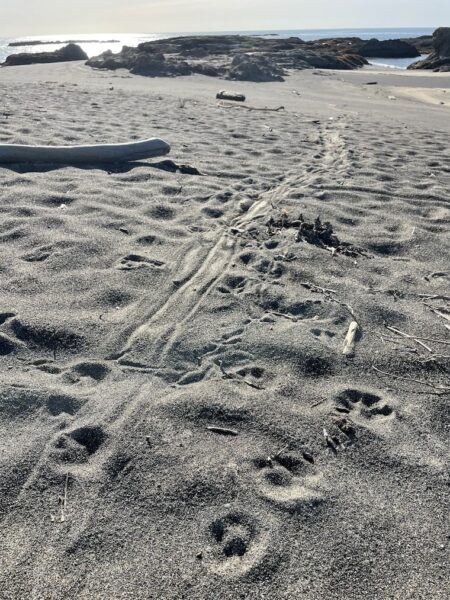
Caught on camera
Then in 2023-24, the motion-trigger cameras recorded coyotes dragging the seals away from the beach on three separate occasions.
Since the new study, other researchers have come forward with photos of coyotes hunting seal pups elsewhere in California, as well as in Washington State and Massachusetts.
These are not simply opportunistic attacks. Most of the time, the coyotes start by eating the brain, tearing off the baby seals' heads to get to it. Between 2016 and 2023 scientists discovered the remains of over 50 pups that had been dragged away from the rookery on MacKerricher State Beach to nearby dunes and eaten this way.

Historically, seals in the area raised their pups on the islands. As the numbers of wolves and grizzlies fell in California in modern times, some seals moved to the mainland. In recent years, more seals are choosing rocky, hard-to-reach areas rather than more accessible beaches. It seems that the presence of land predators influences where seals raise their young.
The team is now interested in seeing if this coyote behavior also occurs at other seal rookeries.
Frankie Gerraty, lead author of the study, has long studied coyotes and worries this will only put people off coyotes even more.
“Coyotes have a PR problem,” he says. “A lot of people do not like coyotes, but everybody loves baby seals.”
A young Venezuelan packrafter briefly became a modern-day Jonah and Pinocchio when he found himself inside the mouth of a humpback whale. The whale released Adrian Simancas unharmed, and his father, Dall Simancas, caught the entire bizarre incident on video.
Adrian Simancas, 23, and his father Dall, 49, were packrafting through the Strait of Magellan between Tierra del Fuego and mainland South America. Dall, who’d been filming the waves, had his camera trained on his son when two massive jaws emerged from the water and closed around the little yellow inflatable and its lone passenger.
For a moment, the choppy waters are empty, with man, beast, and boat submerged beneath the waves. Then, Adrian reemerges, followed by the packraft, which he quickly swims for. A massive grey, finned back crests briefly beside him and then is gone.
Amazed at his lucky escape, Adrian later described his experience. The inside of the whale’s mouth, he said, was slimy against his face, and all he saw was dark blue and white. He thought he was going to die -- and then he was on the surface again, pulled up by his life vest.
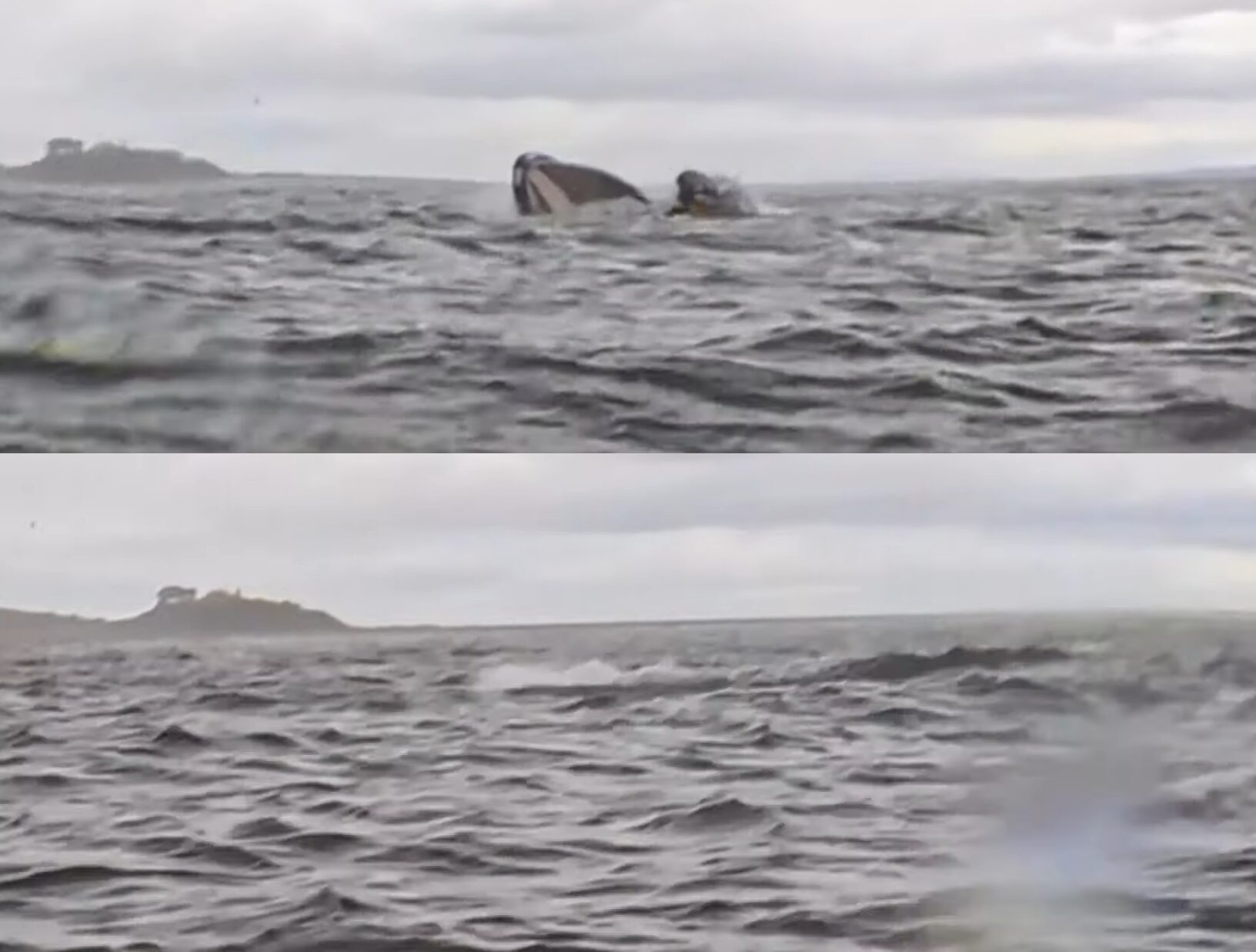
Not technically swallowed
Despite thousands of years of mythology, it is not actually possible for a person to find themselves in the stomach of a whale.
"Ultimately, the whale spit out the kayak because it was physically impossible to swallow," said Brazilian conservationist Roched Jacobson Seba.
Despite their massive size, whales have very narrow throats, about the width of a human fist. They can stretch to be a bit larger, up to about 38cm, but a boat and its passenger are quite beyond their capabilities.
Only one whale can theoretically swallow a human. The sperm whale has sharp teeth and feeds on large squids and fish. This means it has a large enough esophagus to gulp down a human. Encounters with them are much rarer, though, and sperm whales have not swallowed any humans except in fiction. The leviathan in Moby Dick that nipped off Captain Ahab's leg was a sperm whale.
Being engulfed in the massive mouth of a humpback, however, is not off the table, as Simancas learned. He isn’t the first person to spend time in the slimy maw of a whale. In 2021, a humpback 'swallowed' lobster diver Michael Packard off Cape Cod. Like Simancas, he was soon spat back out. Californian kayakers in 2020 and a tour operator off South Africa’s Port Elizabeth in 2019 reported similar incidents. This even once happened to a confused harbor seal.

Probably unintentional
Researchers have weighed in on these engulfing incidents. They insist that the whales did not intend to have people in their mouths any more than the people intended to be there.
As baleen whales, humpbacks take in huge gulps of seawater. Then they use the bristles in their mouths to filter for plankton, shrimp, and small fish. This is what they are after, and the rest, like paddlers, they soundly reject. When you are as big as a whale and maybe not paying attention, you can accidentally gulp down Adrian Simancas and his packraft along with your seawater and shrimps.
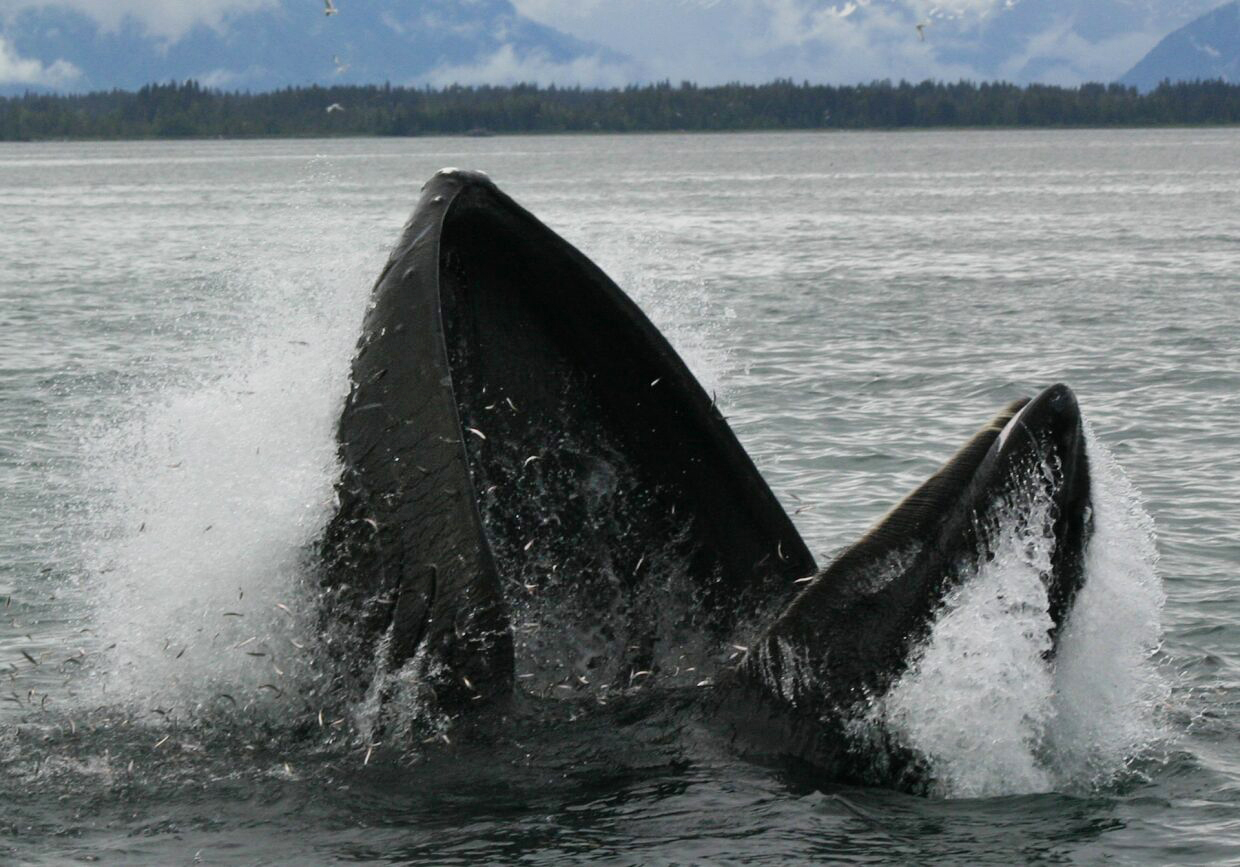
Accidents like these are why whale researchers warn people not to use silent craft, like kayaks and paddleboards, in waters where whales are active. Whale-watching boats keep their engines on at all times to alert the whales to their presence.
Adrian Simancas and his father don’t hold a grudge against the whale. At first, terrified, Adrian thought an orca was eating him. However, after he got free, he realized that the whale was probably “just curious.” Father and son said they plan to get back in the water soon, despite the engulfing.
There is good news for anyone afraid of sharks. Last year, there were only 47 unprovoked shark attacks, a 28-year low. The annual average over the last decade has been 70 a year.
The Florida Museum of Natural History pulls together the International Shark Attack File (ISAF) annually. This is perhaps not surprising since Florida has the highest number of unprovoked bites worldwide. Of the 47 attacks, 14 occurred in the Sunshine State. Eight of those were from a single county, Volusia, in the northeast part of the state.
Florida has more shark attacks per year than the second, third, fourth, fifth, and sixth countries on the list combined. This is likely due to the number of juvenile sharks in the area. It is also a known breeding ground for blacktip sharks.
“Some years see an increase in bites, followed by periods of decline in what appears to be a random cycle," ISAF’s Joe Miguez told CNN. "Because of this natural variability, we cannot attribute this year’s decline to any single cause.”
For an attack to make the list, the victims must not have initiated any contact with the animals. This includes situations where they are actually trying to help the sharks, such as disentangling them from fishing nets.

Only four fatalities
Swimmers and waders were the victims of half of all shark attacks in 2024. Surfers came next at 34%, and then snorkelers and free divers at 8%.
Of the 47 bites, only four were fatal. Actor Tamayo Perry died surfing in Hawaii, and three tourist fatalities occurred in Egypt, the Maldives, and international waters near the Western Sahara.
What is always clear from this yearly data is that the risk of being bitten by a shark is almost zero. The odds sit at about one in 28 million. You are more likely to be killed by lightning.
“The fact that numbers are even lower than last year reinforces the idea that humans aren’t natural prey or even likely targets for sharks,” said Neil Hammerschlag of the Shark Research Foundation.
The ISAF's top tips for staying safe include avoiding going into the ocean at night, dawn, or dusk. Sharks are harder to see and more likely to be feeding. You should also remove jewelry, which can resemble fish scales when light reflects off them.
While filming the BBC Winterwatch television series in Northern Ireland, the crew discovered a dead body.
It was a spider’s dead body, which is not nearly as alarming as other types of corpses, but it nevertheless presented a rather creepy mystery.
The spider was an orb-weaving cave spider, Metellina merianae, found deceased on the ceiling of an abandoned Victorian gunpowder store. A strange location for the reclusive, cave-dwelling spider, but even stranger was the condition of the body.
A crystal-like whitish growth entirely covered the victim's body, with only the legs sticking out from the pale and jagged fungal mass. Intrigued, the crew photographed the fungus and the spider it had consumed.
They sent the photos and the specimen to Dr. Harry Evans, an expert in fungi. He received the body, which had been carefully air dried in a sterile plastic tube, and set to examining it. A new article reveals the results of his investigation: They had found a new fungi species, one that infected and took over the bodies of spiders.

An accidental Victorian import?
Genetic analysis backed up Dr. Evans’ initial observations. His colleague at the Centre for Agriculture and Biosciences International, microbiologist Dr. Alan Buddie, sequenced the DNA of the new fungus. He confirmed that it was a unique species of the genus Gibellula and sketched out an evolutionary tree.
The phylogenetic tree placed it in the same family as two species of fungus from Asia. leading to speculation about its origin. Paul Stewart, Manager of Castle Espie, where the gunpowder store is located, proposed that it had come from Asia. During the 19th century, the British Isles engaged in a brisk trade with Asian markets. Could this fungus have entered Ireland over a century ago on gunpowder packaging and flourished in the dark, damp storeroom?
They needed more samples. An Irish caving specialist named Tim Fogg entered two different cave systems in Northern Ireland armed with delicate forceps and sterile collection tubes. He carefully noted the spiders’ locations and then sent them on to researchers. The fungus was present, which confirmed that it had not been imported in the 19th century but had been in Ireland for far longer than that.
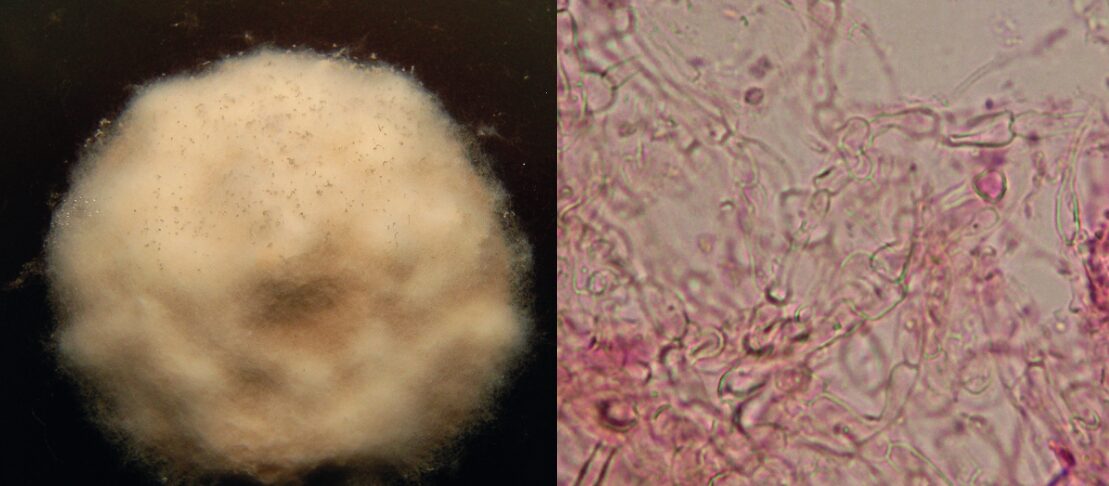
Gibellula attenboroughii
At first, the new fungus was humorously known as Gibellula Bangbangus, in honor of the gunpowder storeroom. But ultimately, it received a new name, Gibellula attenboroughii, after legendary BBC presenter Sir David Attenborough. Without his work, the nature program that found the fungus would likely never have existed.
This is not the first species named after David Attenborough. Previous examples include a Peruvian frog, a long-beaked echidna, an Indonesian weevil, and a tiny marsupial from Australia’s early Miocene.
The fungus is certainly novel in other ways, however. It doesn’t just grow on its hosts, the cave-dwelling Irish orb-weaver, and its close relatives. It also controls them. Once infected, the spiders were swallowed up by a mass of fungus, growing out in thin tendrils and spikes. The fungus then changed the behavior of the hosts in order to propagate itself.
Usually a reclusive creature hiding in dark corners and waiting for prey, the cave spiders were forced to move, minds and bodies overcome by the invader. They were driven out into the open and allowed to die. The fungus then began releasing spores into the open air.

More zombifying fungi out there
The spiders were found dead on open ceilings and cave walls and even, perhaps, on a patch of moss beside a Welsh lake. A dead Metellina merianae spider turned up on the shore of Lake Vyrnwy in Wales in 2016, covered in fungus and exposed to the open air. Researchers now believe this, too, was Gibellula attenboroughii.
The spider fungus of the British Isles, the new study argues, has been long neglected. This new discovery shows that more work is needed to understand the variety and extent of the fungal infections in British and Irish spider populations. Spiders are key to the ecosystem, and so their health is vitally important. Especially since more undiscovered Gibellula species likely exist.
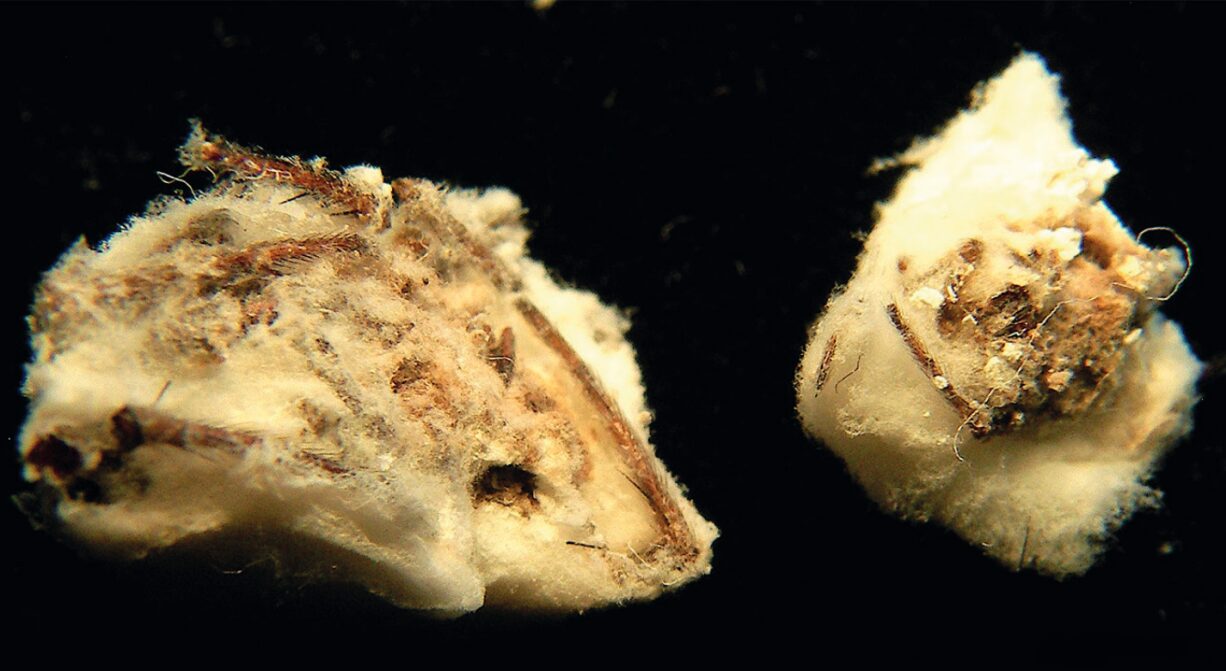
Perhaps the most intriguing question to pursue, however, is how the fungus works. The fungal infection forces the spiders out into the open, but it isn’t clear how it does so. The infamous cordyceps fungus, which infects and controls Amazonian ants, works by taking control of the body, leaving the mind terrifyingly unaltered. Is this what is happening to scores of shy Irish orb-weavers? Is the fungus triggering hormonal changes that alter behavior?
We are left with unknowns. How are the spiders being controlled? Perhaps more importantly, just how widespread are these understudied arachnid fungi? For now, we can only be grateful not to be orb-weaving cave spiders.
Two thousand kilometers from the southern tip of South America sits the island of South Georgia, a Yosemite-sized piece of polar tundra boasting thriving communities of king penguins, elephant seals, and fur seals. Alongside this charismatic fauna, native birds like the South Georgia pintail duck and Antarctica's only songbird, the South Georgia pipit, coexist. And here, in 2021, Belgian nature photographer Yves Adams caught a striking yellow-gold penguin on camera.
Where normal penguins had black feathers, this one had neon yellow. The effect was probably caused by leucism, a genetic mutation that results in depigmentation. Because the penguin was never studied closely, though, it could also have been albino.
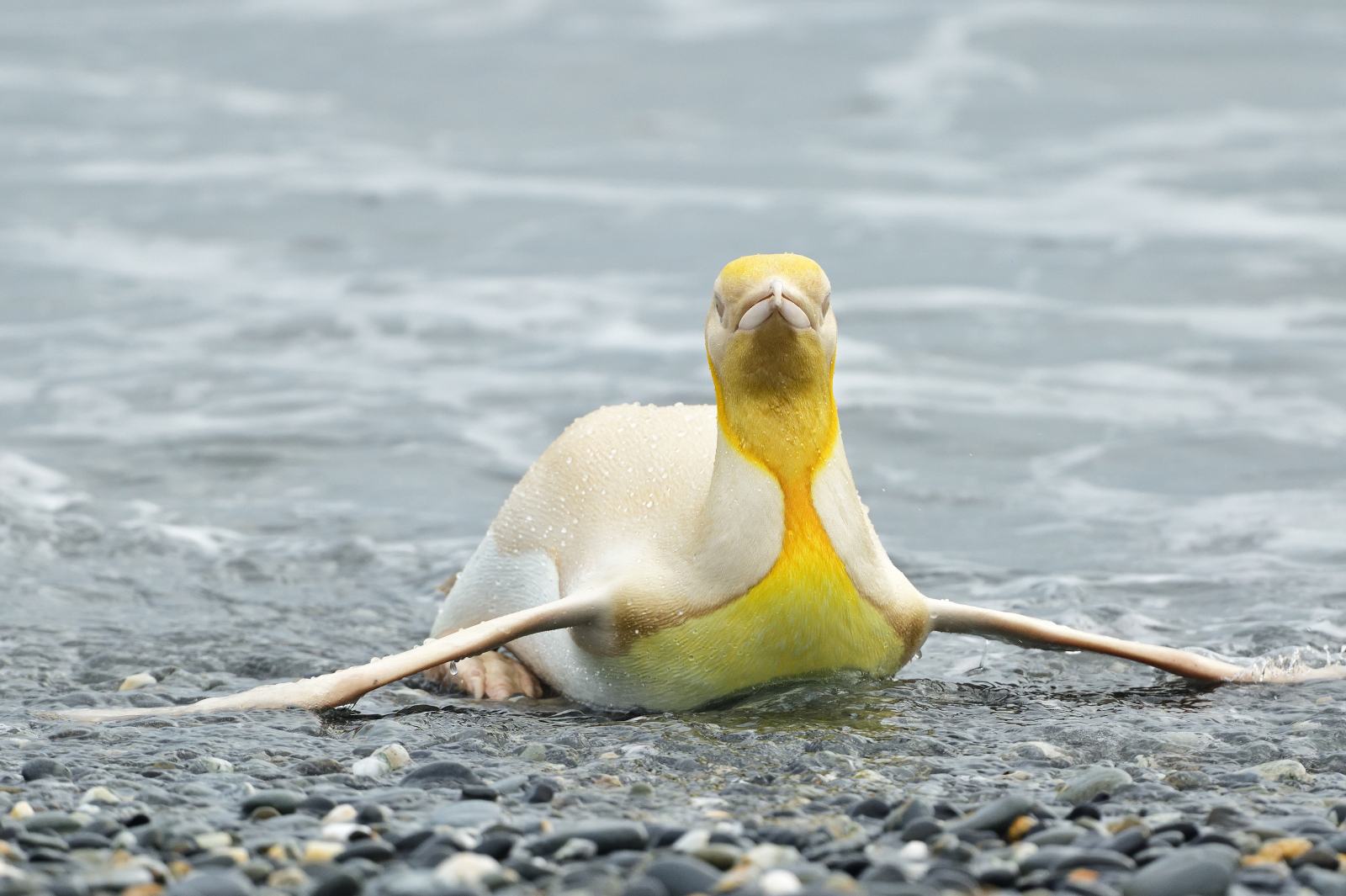
Mission yellow penguin
Yves Adams returned to South Georgia this year as an expedition guide, hoping to find his golden penguin once more. It was nowhere to be found.
But his expedition leader tipped him off to something even more extraordinary, Adams told IFLScience. Adams kept his eyes open, and his patience was eventually rewarded. In a flock of its peers stood a jet-black king penguin.
Besides the video above, Adams snapped a set of glamor shots of the penguin: standing solo, frolicking in the snow, and inspecting the ground with neck-elongating intensity.
Adam's black penguin is striking, but beyond that, it's also amazingly rare. In 2019, a National Geographic photographer snapped a shot of another black king penguin, this one with splashes of white on his wing. Partial melanism, when animals are mostly but not entirely black, is more common than complete melanism. Even for the 2019 penguin, an ornithologist made the journalist who contacted him swear an oath that the black penguin was real.
But Adams' new penguin isn't mostly black -- it's entirely black.
#blackoutpenguin
Up close, Adams said, the penguin's belly feathers have a greenish tint. He seemed healthy and fit in with the rest of the flock.
On Instagram, he wrote, "This one is for the penguin addicts!" In case the penguin addicts needed some help from the algorithm, he tagged the photos #gothicpenguin, #formalpenguin, and #blackoutpenguin.
The prize for his best hashtag, though, stays with his original golden penguin: #yellowpenguinlove. Well, just look at it -- it's yellow, and hard not to love.
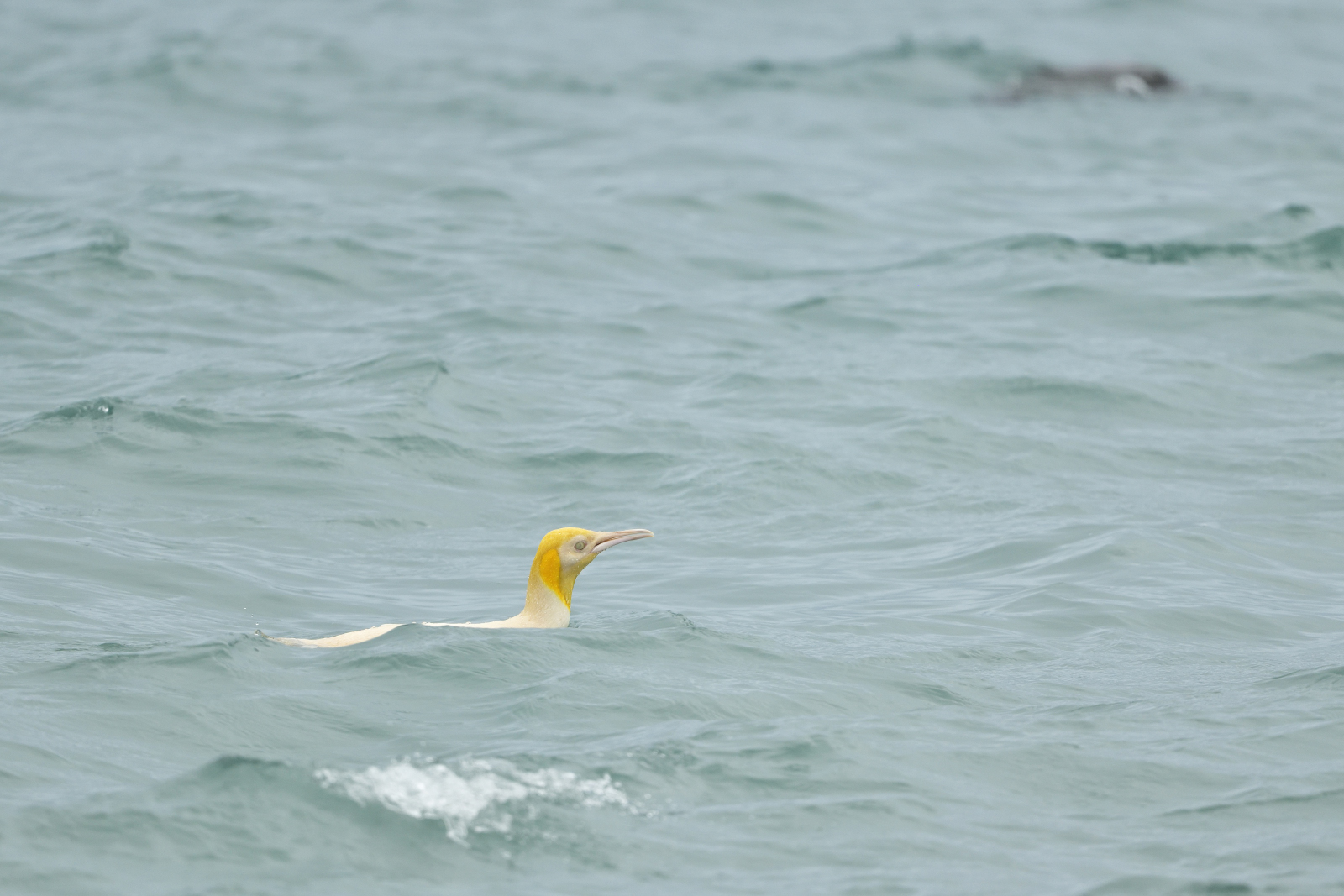
Australia has a reputation for venomous wildlife, particularly spiders. A good part of that reputation comes from the deadly Sydney funnel-web spider, Atrax robustus.
This particular spider has evaded easy categorization. Different specimens across its range vary widely in size and, crucially, the amount and deadliness of venom. But researchers have taken a closer look at this spider and discovered something unexpected: it isn’t a single species at all.
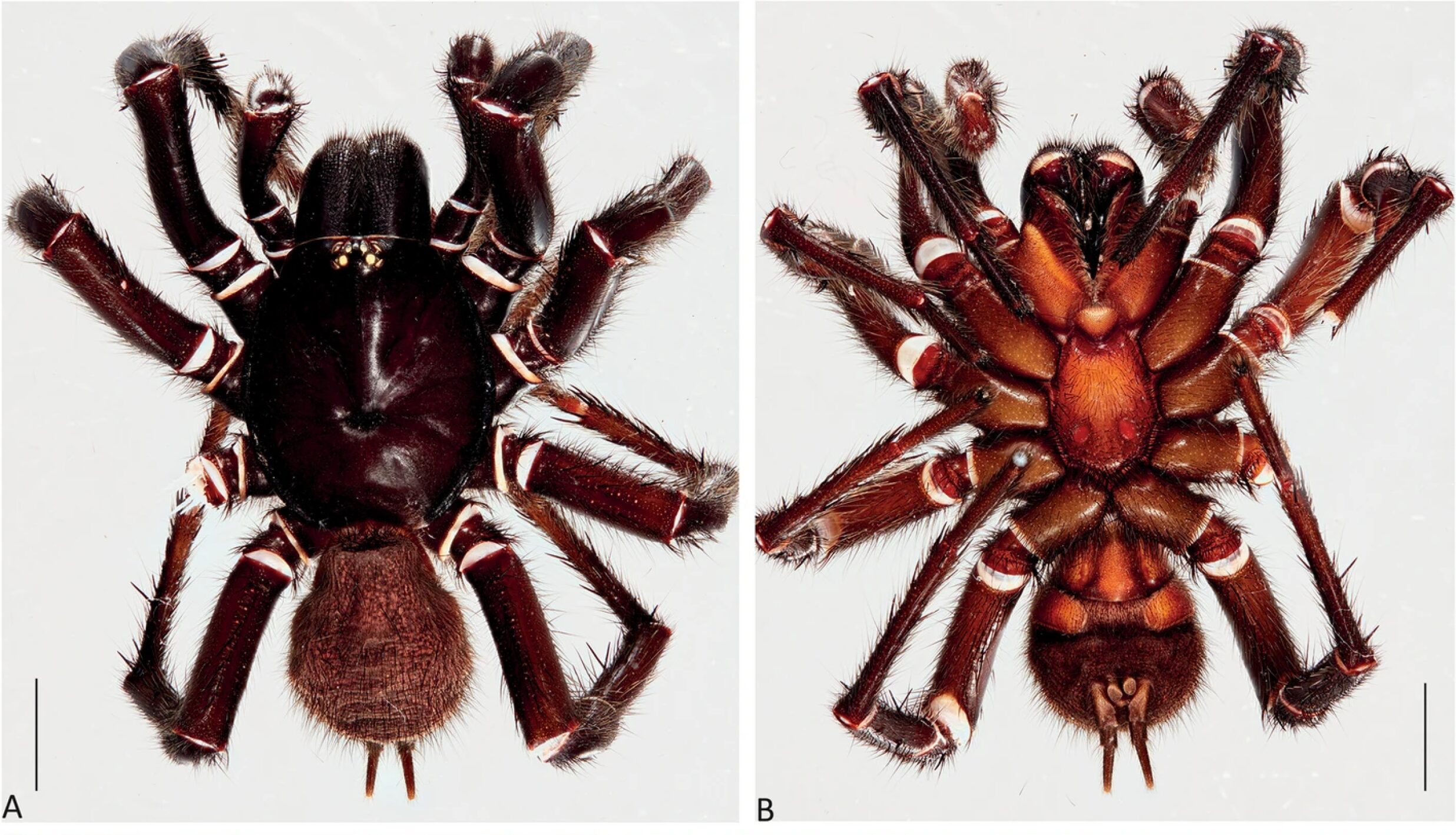
Venomous menace
First described by English clergyman and noted arachnologist Octavius Pickard-Cambridge in 1877, the Sydney funnel-web spider is responsible for over a dozen recorded deaths. It is considered the most venomous spider in the world. The venom is more potent in males, which are also more aggressive and tend to wander in the open after a rainfall. They also tend to hang on or bite multiple times once confronted.
The initial bite is painful, and symptoms set in quickly, within an hour of the bite. The Sydney funnel-web deploys a neurotoxic called Delta atracotoxin. This D-atracotoxin causes breathing difficulty, wild fluctuations in blood pressure, muscle twitches, vomiting, and nausea. Other symptoms include uncontrollable weeping, sweating and salivation.
Luckily, there is an antivenom. Since it was developed in 1981, there have been no recorded deaths from the Sydney funnel-web. Producing this antidote requires a large number of captive spiders, which researchers at the Australian Reptile Park carefully “milk” for their venom.
This program received a donation of one such spider in early 2024. When measured, this individual measured 7.9 centimeters or 3.1 inches from leg tip to leg tip. Named “Hercules,” he was the largest Sydney funnel-web spider ever recorded.
Actually, it turns out he isn’t. He’s an entirely new species.
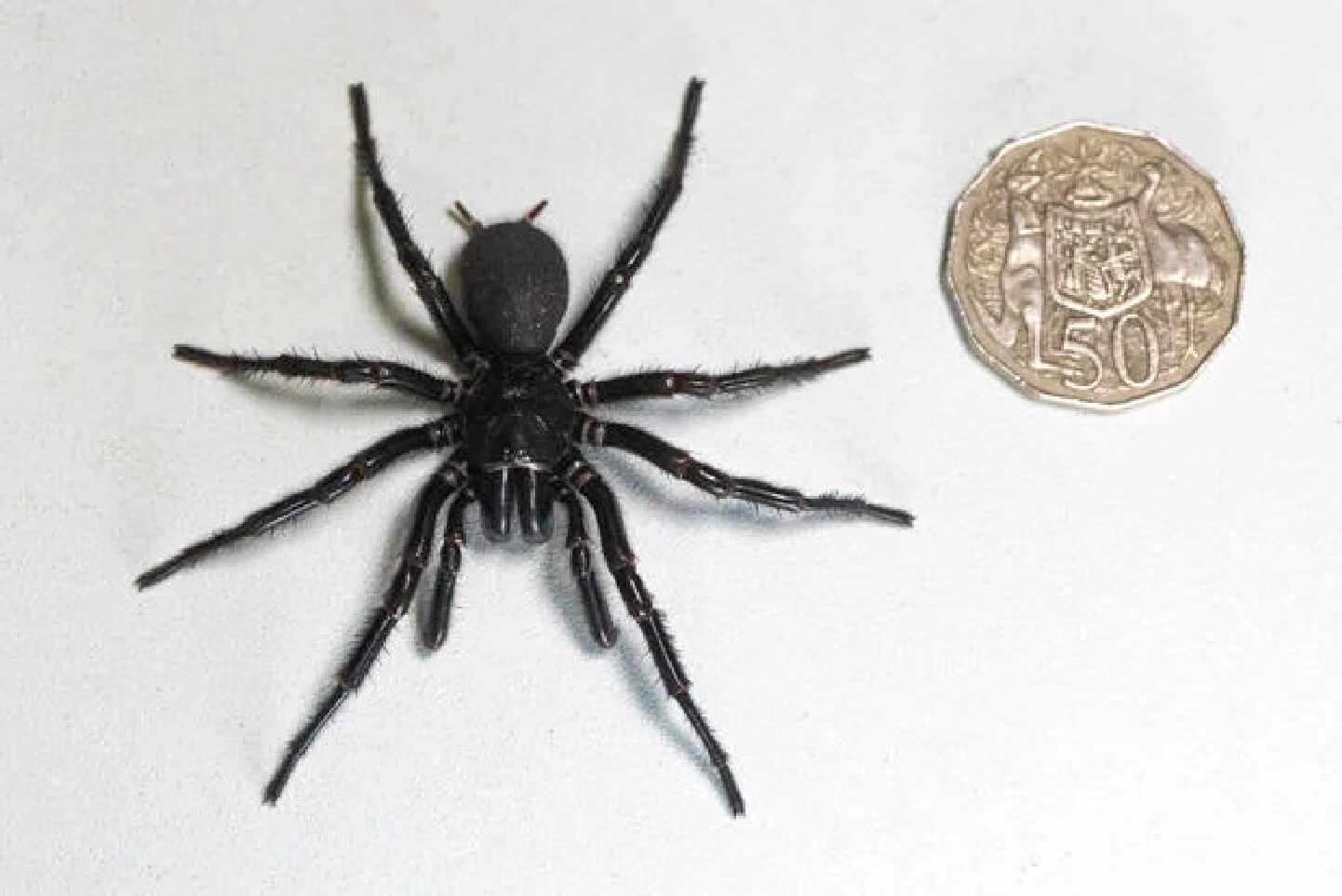
A puzzling species
Massive specimens like Hercules and Colossus, the previous largest specimen, collected in 2018, raised questions for researchers. Why did the Sydney funnel-web vary so widely in size and lethality? Nearly 150 years after the species was first defined, it was time to look into this.
Researchers from the Australian Museum, Flinders University, and the Leibniz Institute in Germany collected several specimens, including the original holotype used to define the species in 1877. Then they carefully measured every part of the spiders, from fang length to internal genitalia.
They also performed genetic analysis on 57 of the specimens, testing for the degree of difference between different groups. They found three distinct clades, which matched the geographical distributions and physical differences they observed.
So the one species was actually three. They estimate that the spiders diverged from each other in the late Miocene, between 13 and 2 million years ago.
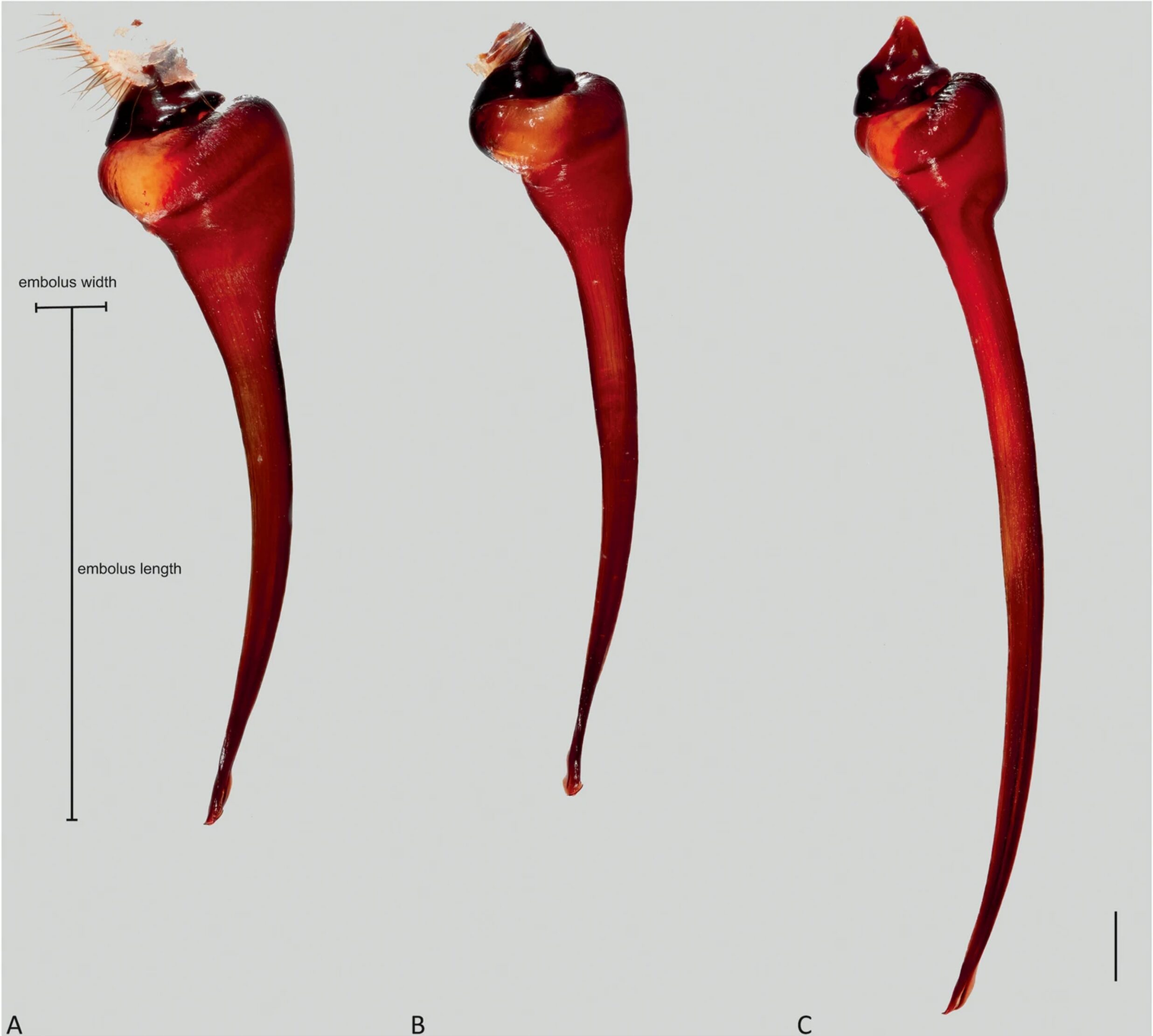
The 'Big Boys'
The “true” Sydney funnel-web, and the most common of the three, will remain Atrax robustus. A second mountain-dwelling variety is now officially Atrax montanus. The final, larger, more venomous species is officially the Atraz christenseni. Researchers are calling them “Big Boys.”
Big Boys have a small range: only the area surrounding and to the north of Newcastle. The Big Boys also tend to build more cryptic funnel webs, making their burrows harder to spot than those of their smaller and more common cousins. This and their limited distribution may be why they were not previously identified as a unique species.
This discovery isn’t just great news for fans of large, extremely venomous spiders. It may be important for developing antivenom. The new species differentiation will help make better antivenom and allow doctors to predict how serious a given bite will be.
Their exact haunts have not been made public, as their unusual size and limited distribution, so close to an urban area, may make them vulnerable to overexcited collectors. While the Big Boys may seem fearsome, researchers are already worried for them.
“Conservation measures may be warranted,” the study warns, in order to preserve the iconic Sydney funnel-web family.
In 2018, an orca mother made global news for her striking display of grief. Her young calf had died soon after birth, but she had refused to let go of her offspring. Instead, she pushed the body of her calf through the water, balancing it on her head for 17 days and 1,600 kilometers before she finally left its body behind.
So when J35, as scientists called her (or Tahlequah, as she was known to the public), gave birth again in late December, it was a cause for celebration. However, the mother and calf were already behaving unusually, which made scientists with the Center for Whale Research concerned for the health of the baby whale.
Unfortunately, their worries were well-founded. A little over a week later, the calf died. The mother once again took up her sad burden and has again been carrying the body of the deceased calf with her.

Do whales mourn?
Humans are always quick to assign human emotion to animals, and we aren’t always right. But scientists believe that Tahlequah is truly mourning the loss of her calves.
“Grief isn't owned by humans,” said Jenny Atkinson, executive director of The Whale Museum on San Juan Island, where Tahlequah was observed in 2018.
In fact, killer whales often carry their deceased calves with them for around a day before letting them go. None have been observed to do so as long as Tahlequah did in 2018. It is likely that she will repeat this behavior the second time.
Researchers believe that there is a practical element to carrying deceased calves. It is possible for a calf to appear dead but just be unconscious. In this case, continuing to care for them after an apparent death might save their lives.
However, whales like Tahlequah continue to carry their offspring long after they are clearly dead. This may mean they have accepted that the death has happened but haven’t yet come to terms with it emotionally, say researchers. In other cases, bereaved cetacean mothers have even carried around parts of a dead calf or other “surrogate objects.” In 1954, for example, a bottlenose dolphin carried the severed head of her calf.
While it is important not to anthropomorphize, Tahlequah clearly shows a deep emotional attachment to a deceased offspring, which can only be called grief.
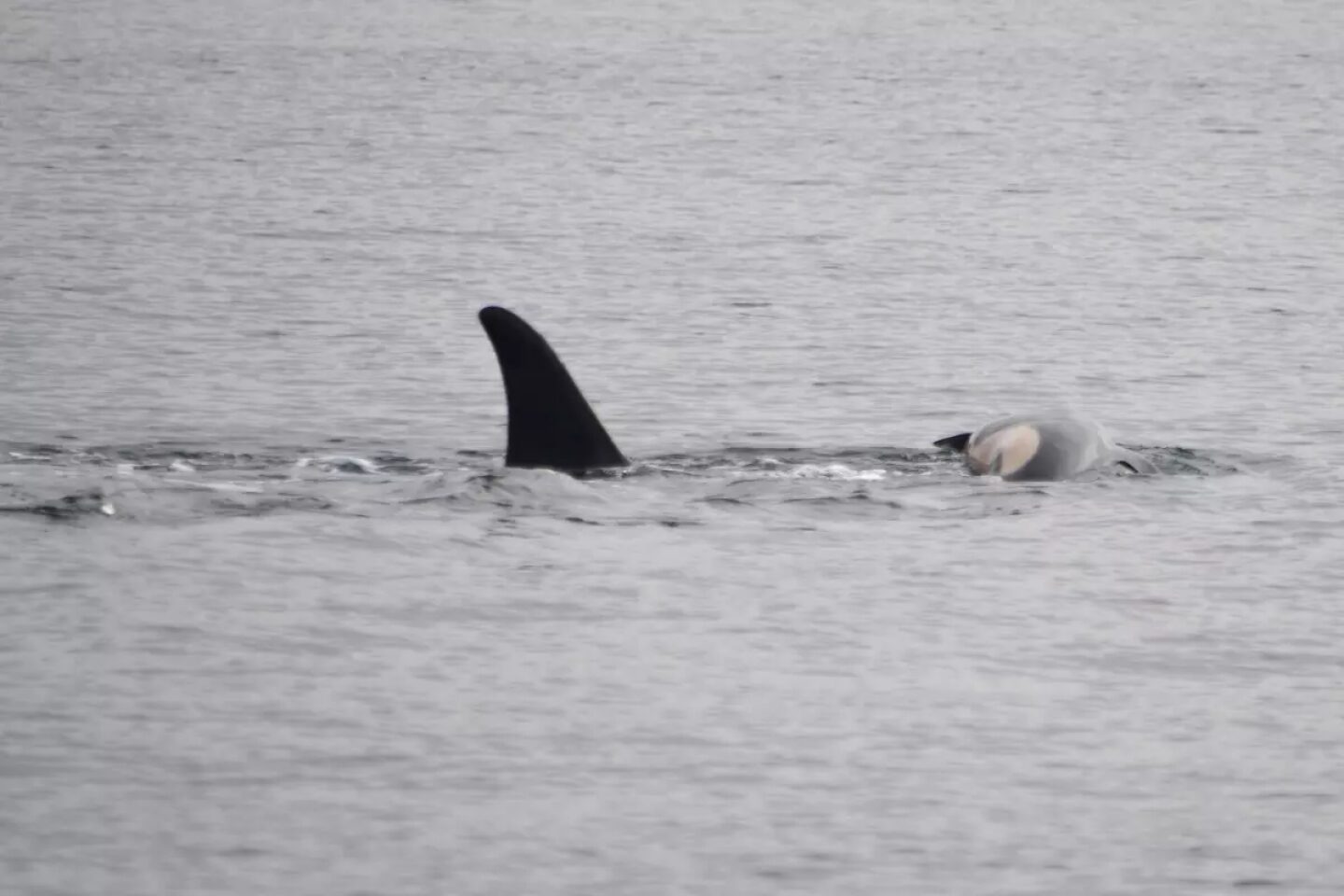
The future of the pod
Tahlequah and her calves are Southern Resident Killer Whales, a critically endangered population which winters off the coast of Washington State in Puget Sound. There are fewer than a hundred left in the wild, making the loss of a female calf even more devastating.
It is common for calves to die in their first year. Estimates suggest that between 20 and 50 percent of calves do not survive. Those numbers are only increasing as the Southern Residents struggle to find enough food. Upriver damming and habitat loss have affected the endangered Chinook salmon, the orca's favorite food.
The fate of Tahlequah
Researchers are worried for Tahlequah herself. While she mourns, she isn’t foraging and is expending a great deal of energy on carrying her dead calf. After her ordeal in 2018, she recovered her lost weight, even delivering a healthy male calf two years later.
In 2018, she was accompanied by her own mother, who has since died. She isn’t alone now, however. She is currently accompanied by her sister, Kiki, and son, Phoenix, who may share food and provide emotional support. They are swimming together, bearing the body of the calf, a little way behind the rest of her pod. Researchers hope that with the help of her surviving family, she will make it through her ordeal.
There is one piece of good news. A second calf was seen swimming with the pod on New Year's Day. So far, the new calf seems normal and healthy.
In a major sting, UK authorities have seized over 6,000 wild bird eggs. It is the largest haul of stolen eggs in the nation's history. The hidden eggs were found in attics, offices, and drawers during coordinated raids across Scotland, South Yorkshire, Essex, Wales, and Gloucestershire.
These raids are part of Operation Pulka, an international initiative launched in 2023 to combat the illegal trade in wild birds' eggs. The operation began in Norway, where authorities seized more than 50,000 eggs and arrested 16 individuals. In Australia, approximately 3,500 eggs were confiscated, including some belonging to critically endangered species.
Egg collecting, or oology, was a popular hobby in the UK during the Victorian era. Its ongoing popularity had damaged bird populations to the point that the UK criminalized the practice with the 1954 Protection of Birds Act.
Then came the even stronger Wildlife and Countryside Act 1981, which calls for the protection of all wild birds, their nests, and eggs. Despite this, the illegal trade persists, especially for rare and exotic eggs. The National Wildlife Crime Unit (NWCU), which is leading Operation Pulka, believes the trade in wild bird eggs “has an even greater impact now."
Staggering prices
Rare eggs can fetch a staggering price. The 3,500 eggs seized in Australia are worth over $300,000 on the black market.
“These criminals are very well organized and connected," explained Mark Harrison of the NWCU. "The rarer a species is, the higher its demand and value to these criminals.”
The success of Operation Pulka, unfortunately, also reveals the size of the illegal trade.
“The scale of this operation is alarming," Dominic Meeks from the University of Cambridge told The Guardian. "Previous seizures have been the product of singular obsessive individuals. The complexity of this operation appears to be far greater."
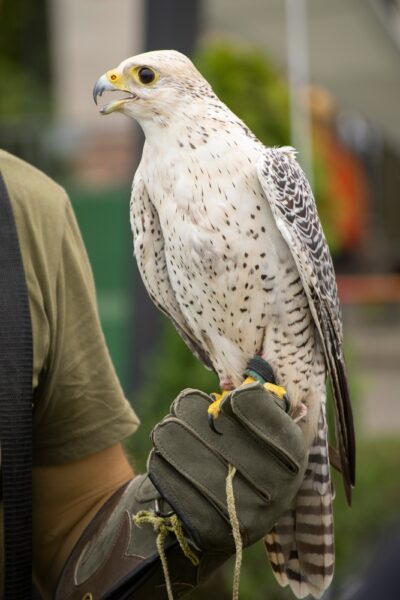
A worldwide problem
To many, the idea of a flourishing illegal egg trade is a little bizarre. But egg poaching is not as rare as you would expect. Decades ago, Lear jets from the Middle East regularly landed in Iqaluit on Baffin Island, Canada, to transport stolen gyrfalcon eggs to wealthy falconers. These eastern Arctic gyrfalcons were especially coveted for their pure white plumage, in contrast with the greyish tones of their western counterparts.
Then in 2002, two men pretending to be nature photographers were apprehended with falcon eggs in Kuujjuaq, Quebec. They were trying to smuggle them into Dubai. One falcon egg was worth $30,000 in the Middle East.
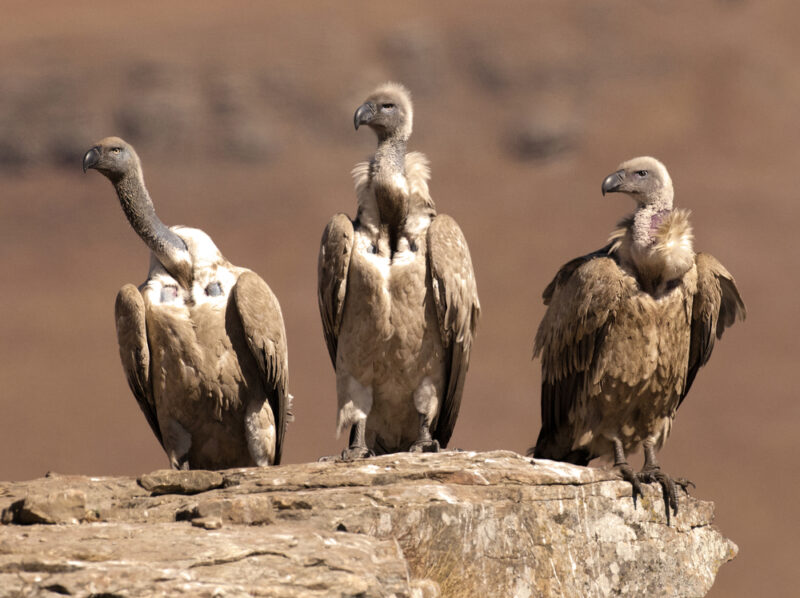
In 2019, prolific egg smuggler Jeffrey Lendrum was caught at Heathrow Airport with a dozen eggs from endangered species. He even had two hatched Cape vulture chicks, worth $110,000, hidden in woolen socks. It was his fifth arrest.
Experts will now analyze the eggs from the most recent raids to decipher which species they belong to.
Scientists named a staggering 190 new species in 2024. The list, which comes from London’s Natural History Museum (NHM) and elsewhere, includes a vegetarian piranha and a rat endemic to a single Indonesian island.
Vegetarian piranha
Myloplus sauron was discovered in the Xingu River in Brazil. New research showed that Myloplus schomburgkii, a fish that scientists believed was one species, should be split into three. The three species had subtle differences in their scales, coloration, and proportions, as well as clear genetic differences. Because of its red fins and black stripe, researchers named one of the fish after Tolkien's Eye of Sauron.
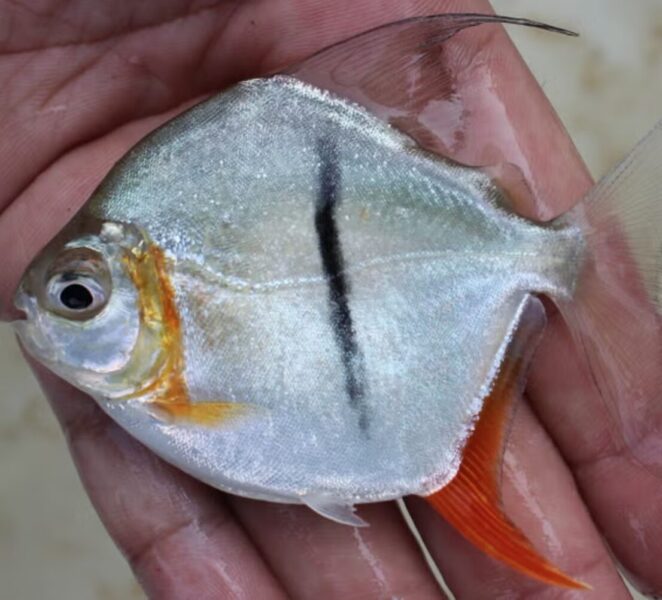
This species highlights one of the reasons it is so important to continue naming new species. Brazil is building dams across Myloplus sauron's habitat. When the government green-lit the project, evaluators grossly underestimated the river's species diversity.
"We didn’t know how many endemic species are there," one scientist explained. "But since these projects launched, we’re finding that there’s probably upward of 70 endemic species in this very small region in the Xingu River."
Simply put, researchers and conservationists cannot protect species if they do not know they exist.
"To fix our broken planet, we need to keep learning about how life evolves and how vital its diversity is in keeping nature healthy. Naming new species helps us do just that," Tim Littlewood, Director of Science at the NHM, commented.
Discoveries in surprising places
Other discoveries include a moth from a living room in Wales and the most complete dinosaur discovered in the UK in a century.
A young ecologist caught a photo of the moth in Wales when it fluttered into their living room. They didn't know what it was but posted the picture on social media, where it caught a researcher's eye. Named Carmenta brachyclados, the clear-winged moth is native to Guyana in South America.
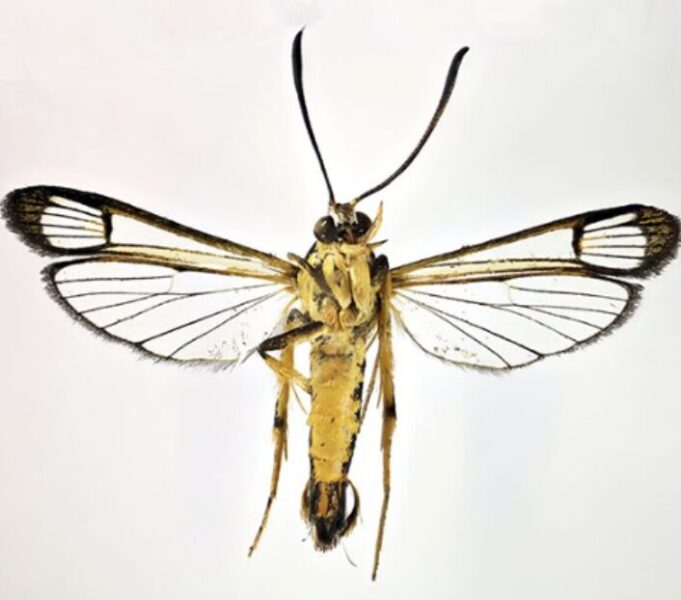
The NHM named the UK dinosaur, Comptonatus chasei, partly after Nick Chase, the fossil hunter who unearthed the skeleton in 2013.
There were many other newly described species of dinosaur, including a pterosaur from the Isle of Skye, a stegosaur from China, and a sauropodomorph from Zimbabwe.
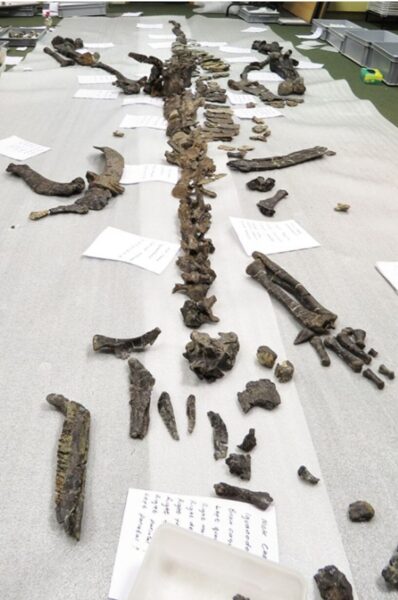
The 2024 list also includes a dozen new species of beetle, over 50 Bryzoans (aquatic invertebrates), a fossil poo named after author AA Milne, five species of snake, three species of Candiru catfish (famed for swimming up urethras), several frog species, and a rat only found on the Indonesian island of Obi.
A full list of the new species can be found here.
I started using iNaturalist in 2018. I had been using the app, a free citizen science platform that defies easy categorization, to record the wildlife I observed as I traveled. A sort of real-life Pokemon. But it wasn't until 2020 that I was fully hooked.
I was walking through Cat Tien, a sweaty chunk of lowland jungle in Vietnam. I had spent the night at a ranger station set up to protect a critically endangered population of Siamese crocodiles. But it wasn't the crocodiles that triggered my iNat addiction. It was something much smaller, something I might not have noticed pre-iNat, let alone photographed. On the trail, I found a large land snail and decided to take a couple of snaps of it.
Later, I uploaded the sighting to iNaturalist. For some organisms, the AI identification tool immediately provides an ID with reasonable certainty. For others, it has less information to work with. In these cases, you upload with an ID to whatever level you're comfortable with. With no knowledge of Vietnamese snail species, I went with the very generic gastropods.
More than a social network
This is when another of iNat's functions comes in. The app (and website) do much more than serve as a gallery of the things you've seen. It describes itself as "an online social network of people sharing biodiversity information to help each other learn about nature. It's also a crowdsourced species identification system and an organism occurrence recording tool."
Within a couple of days, other users identified my snail as Bertia cambojiensis, the Vietnamese giant magnolia snail. Critically endangered, this species was long thought extinct and only rediscovered in 2012.
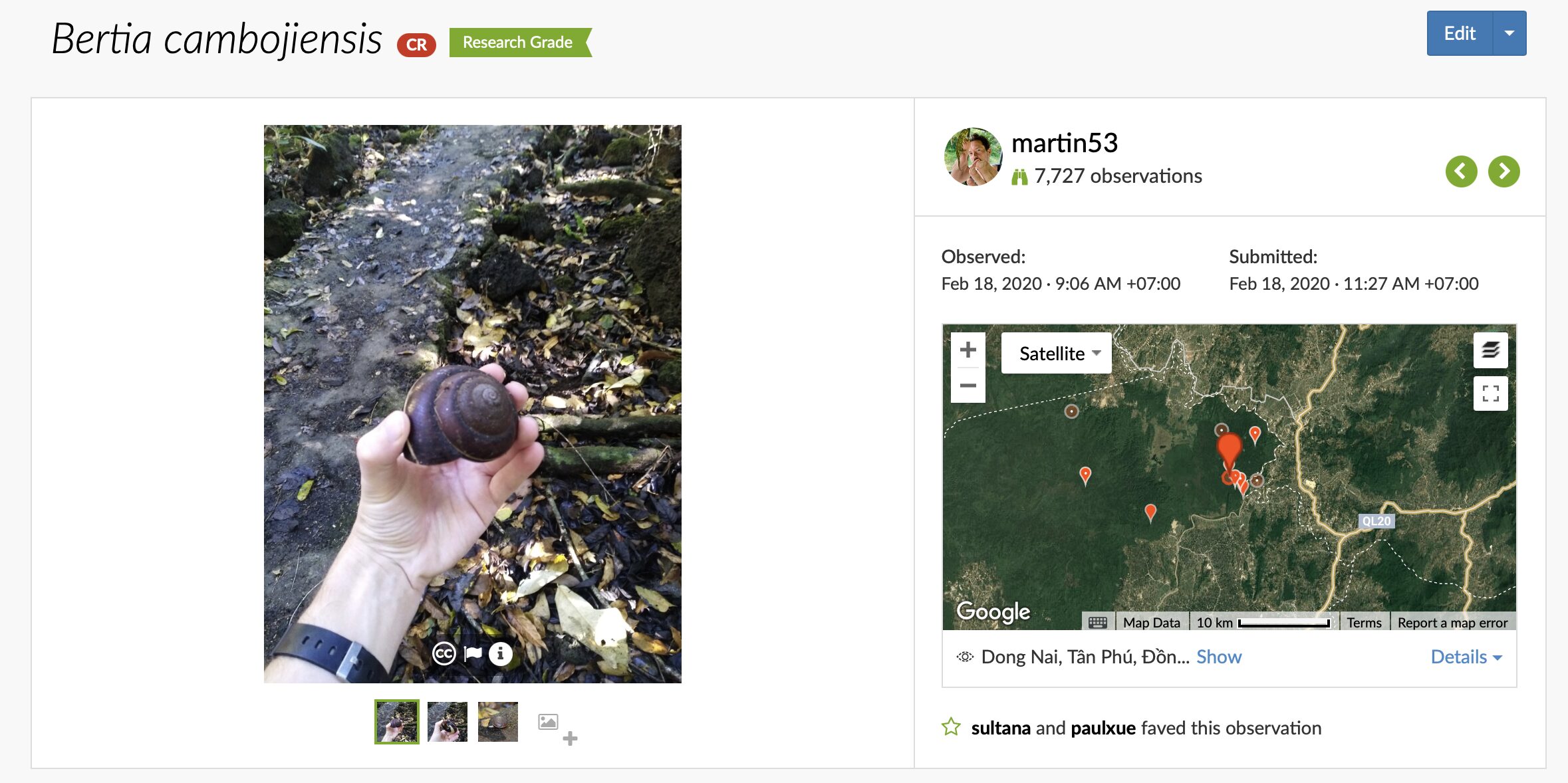
From there, it was a slippery slope. Within a year, I'd bought a large camera and some proper binoculars. Soon, I was reading research papers on species splits and primate behavioral studies. Last week, I was chatting to a lepidopterist (someone who studies moths/butterflies) in Colombia who wanted to know if she could use one of my photos for a field guide. I'm 2,400 species deep and still going strong.
And that's the thing: iNaturalist makes you look at the world differently. It encourages you to take in what's around you, to explore, and to learn about what you find. Unlike eBird, which has been around much longer and also collects crowd-sourced data, iNat deals with all life: plants, birds, mammals, reptiles, viruses -- if it is wild, upload it. This breadth encourages learning, and it encourages a more holistic view of the natural world.
Fancy getting addicted, too? Here's a quick explainer on how to use iNaturalist.
Getting started
It might be helpful to think of the three elements of iNaturalist as different levels of interest.
Do you just want a quick AI-driven ID of something in your garden? Try the Seek app, made by the same company. This is the most basic version of what iNaturalist offers. Point your phone at a flower, take a photo, and the image recognition software will try to tell you what it is. You don't have to upload the observation (but you can!).
Want to track what you've seen and contribute to science? Then, the iNaturalist app is better for you. It will track what you've uploaded, allow you to explore other people's observations from around the world, and provides most of the functionality of the website. You can find the Android app here and the iPhone app here.
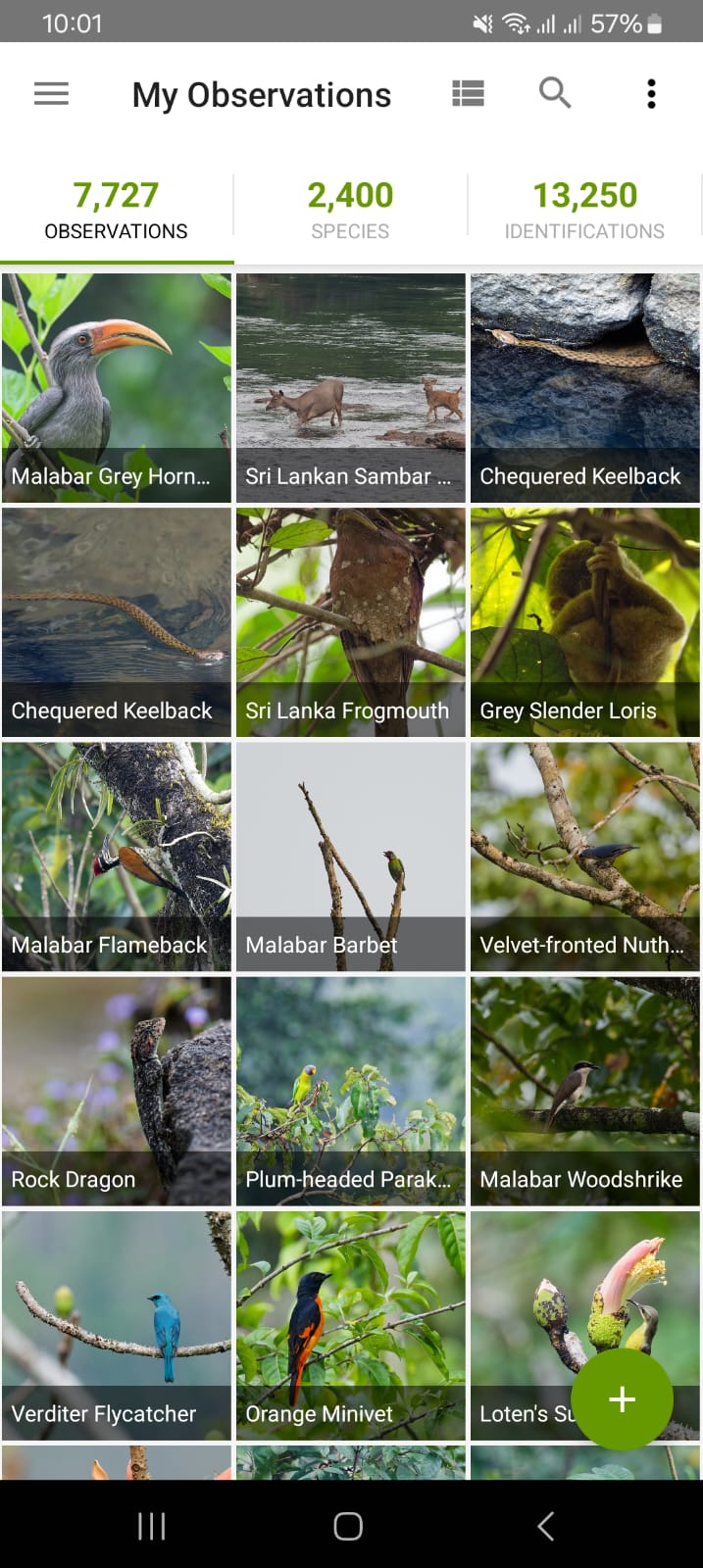
Want the full package? The website is best if you want to do all of the above and also help others to identify their observations. I use it to learn, plan trips, and help out by identifying birds and mammals in Southeast Asia, where fewer users have the requisite knowledge.

Making an observation
To make an observation, you need a few things.
- A photo or a sound recording.
- When (date/time) you saw the organism. This is usually added automatically from a photo's metadata.
- Where you saw the organism. This can be added automatically if you're taking the photo on your phone. Otherwise, you will need to do this manually using the map.
- What did you see? The AI will offer suggestions. Sometimes, it will say: "We're pretty sure this is..." with a single suggestion. If this matches what you observed, select this. Other times, it won't be so sure: "Here are our top suggestions." In this case, it is best to only ID to a level you are sure of -- eg. You've seen a woodpecker but you're not sure of the species? Type in woodpeckers and select the family group. It's always better to go with a coarse ID like "Birds" or "Mammals" rather than guess what something is.
- Was it wild? Is it a pet/zoo animal/cultivated plant? Then tick the captive/cultivated box.
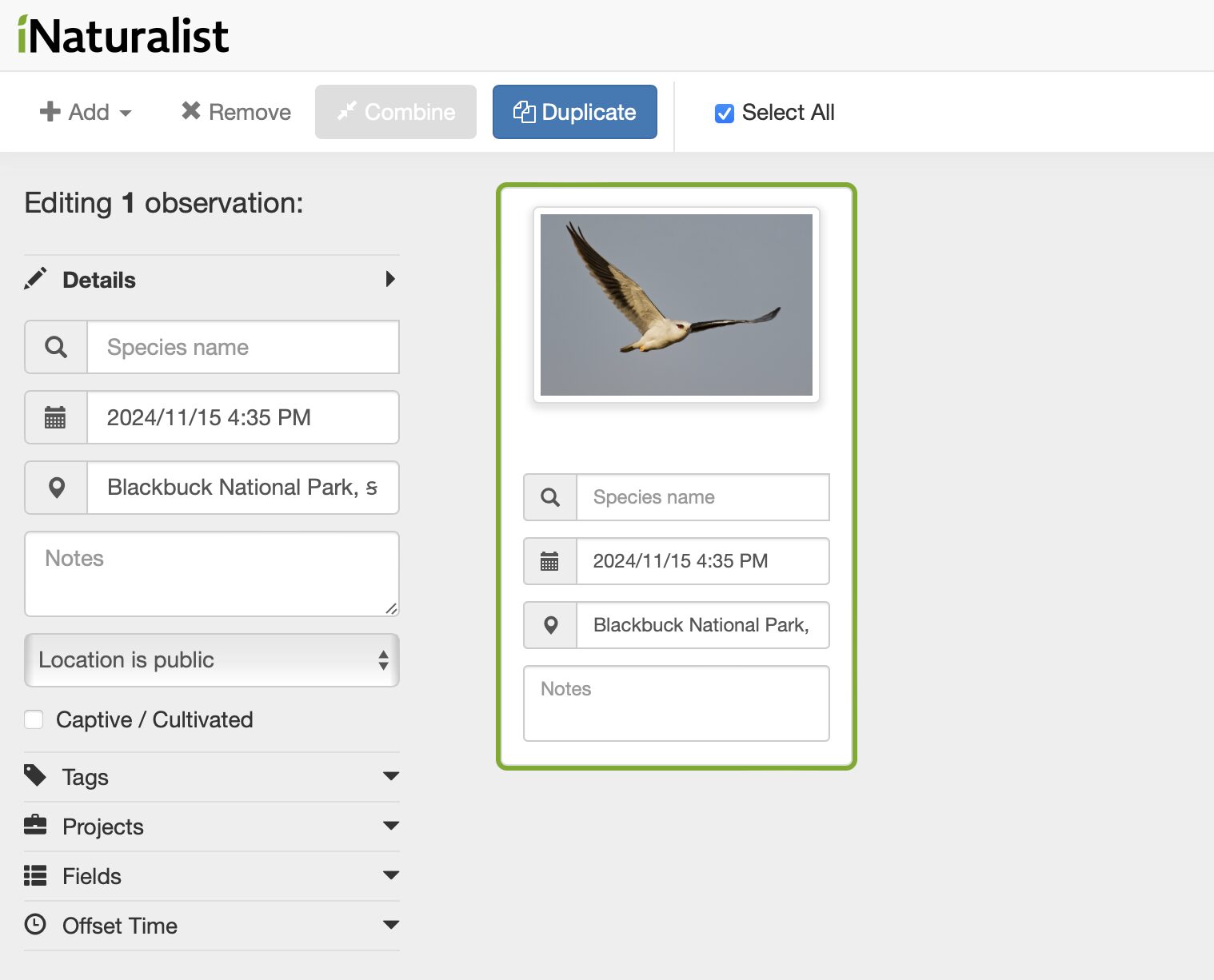
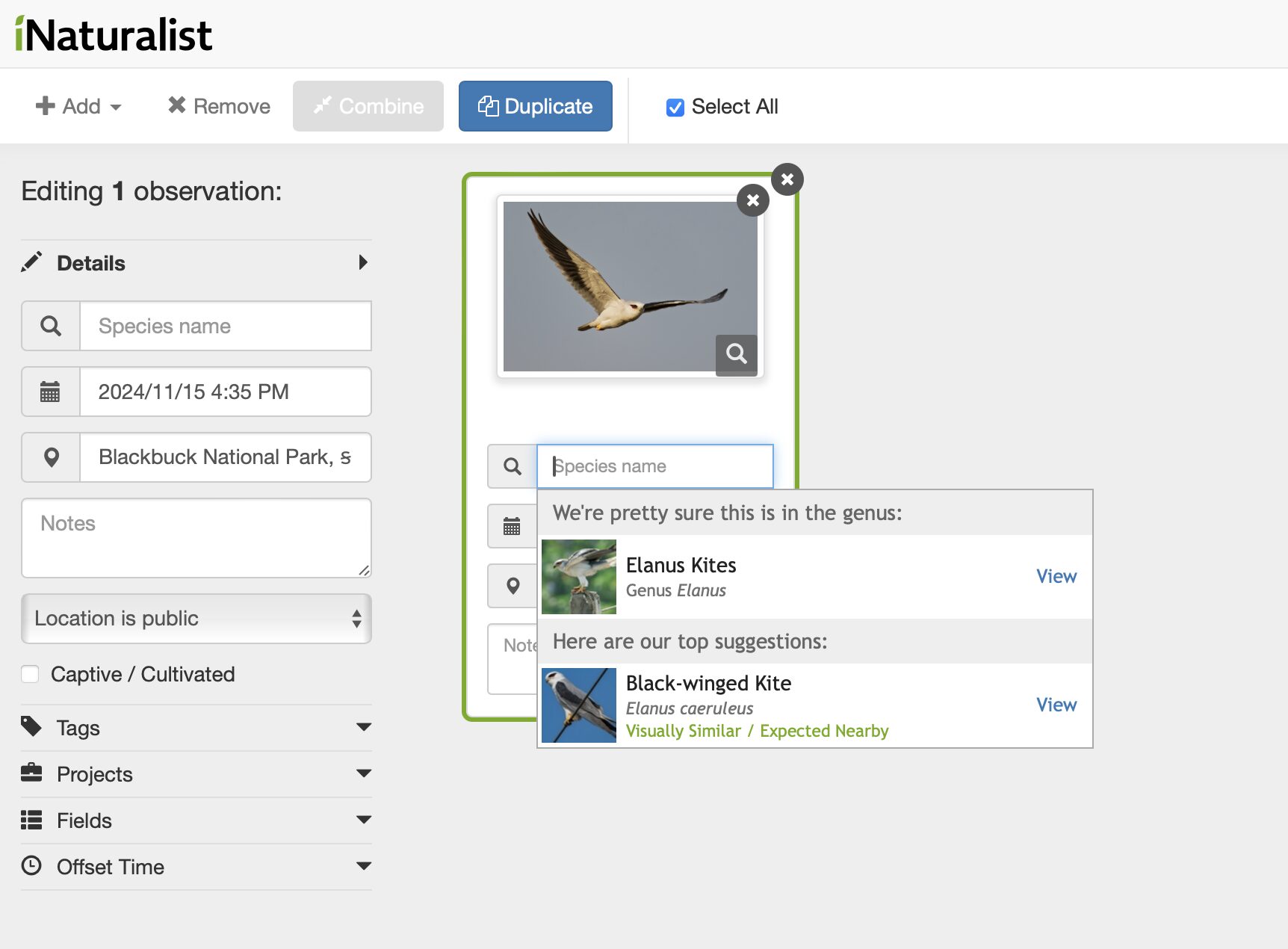
Got old wildlife photos? You can upload historical records, too.
iNaturalist has a detailed step-by-step guide to making observations here.
Citizen science
If an observation reaches "Research Grade" (has all the data listed above and the ID is agreed upon by at least 2/3 of identifiers), then scientists can use it. You might see your observations included in a research paper or upcoming study.
Occasionally, iNaturalist leads to the rediscovery of a species or the discovery of new ones. This month, a London commuter uploaded an invasive insect not seen in the UK for 18 years. Last month, a marine worm was rediscovered after 68 years when researchers spotted it photobombing seahorses, and a user spotted a humpback whale in New York's East River!
Four years ago, 350 elephants died near Botswana's Okavango Delta, but the cause of their deaths was a mystery. It turns out that blue-green algae fatally poisoned them.
All the elephants died between May and June 2020. From the positioning of some of the carcasses, it was clear that the deaths were sudden. Many were face down, suggesting that they had collapsed.
Researchers quickly ruled out several causes. The elephants were too big to have starved. Nor did poachers kill them because all tusks were intact, and there were no bullet wounds. Vultures fed on the carcasses, eliminating human poison, which the scavenging birds detect.
The pandemic stopped further on-site investigations. Many suspected the elephants had died from toxic algal blooms, but they could not prove this.
A team of researchers from Botswana and the UK took up the challenge. Using satellite data, they tracked algal blooms across 3,000 waterholes in the region during 2020.
Davide Lomeo, lead author of the new study, said, “We identified 20 waterholes near fresh carcasses that experienced increased algal bloom events in 2020 compared to the previous three years combined.”
By mapping the positions of the carcasses in relation to the affected watering holes, it became clear that the two were linked. The number of dead animals hinted at the strength of the toxins. It seems that the elephants keeled over within 88 hours of drinking the contaminated water. They walked an average of 16.5km before the toxins killed them.
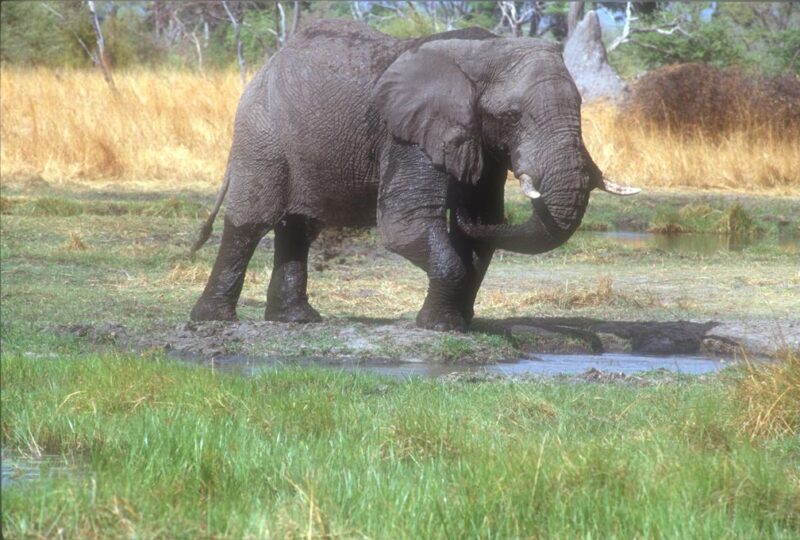
The mass die-off sparked huge concern at the time. Botswana has one-third of all African elephants. If conditions like this had continued or recurred, it could have had a huge impact on the endangered elephant population.
Algae might sound harmless, but the waterholes hosted blooms of cyanobacteria, a group of algae that produces incredibly harmful toxins. During the dry season, most of Botswana's elephants depend on a small number of these waterholes. They come from far and wide and have to drink there until the rains come.
Algal blooms do not occur year-round, but they were much more prevalent in 2020. The weather in Botswana shifted dramatically that year, moving from incredibly dry to incredibly wet much faster than usual.
Researchers believe that the sudden influx of rain suspended nutrients closer to the surface of the waterholes. This created the perfect conditions for these toxic blooms.
The team warns that as climate change makes Botswana hotter and drier, events such as the 2020 die-off could occur again.
Judges have chosen the winning photos in the Nature Photographer of the Year contest, now in its ninth year.
Italian photographer Paolo Della Rocca took the overall prize for his image of two snow leopard siblings play-fighting in the Spita Valley of northern India. Della Rocca wanted to photograph the rare cats for years. They have been his favorite animal since childhood.
Della Rocca spoke about the day he took the incredible photo.
This image was anything but easy to obtain. I waited over six hours at the edge of a canyon as the two siblings rested in a cave. The cold –- reaching -25˚C and intensified by a snowstorm –- seeped into my bones. When calm finally returned, the snow leopards began to move, chasing each other up the snowy slopes, playing in front of my astonished eyes. I remember thinking, ‘This isn’t happening; it can’t be real!’ And then, I captured this frame. Not even in my wildest dreams did I imagine photographing such a moment.
This year, the contest had a record number of entries: 22,851 from 96 countries. Twelve category winners were selected. Della Rocca won the Mammals category and then the overall prize.
Check out other winning images below.
Animal Portraits - Winner: ‘Besties’
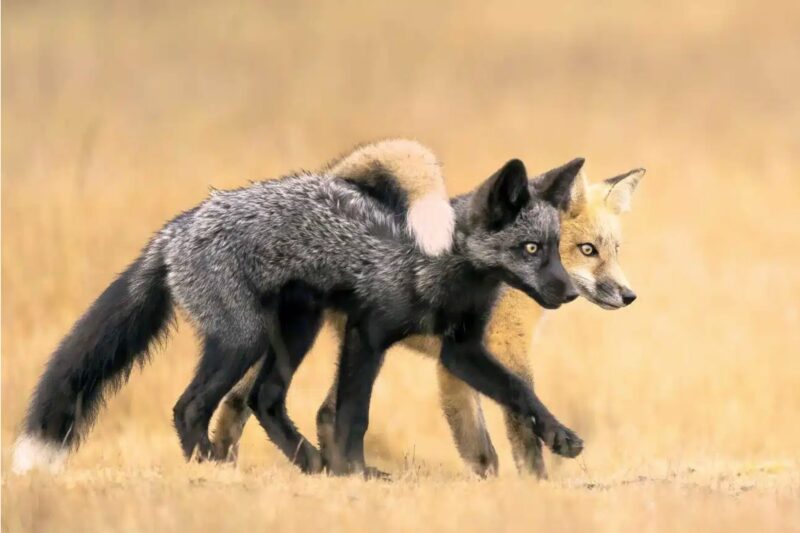
Underwater - Winner: ‘Giant Octopus Dolfleini’
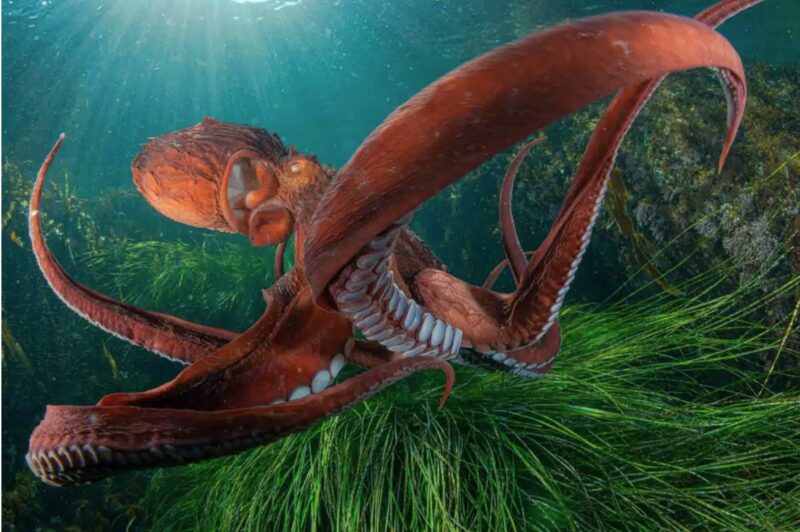
Birds - Winner: ‘Golden Eye’
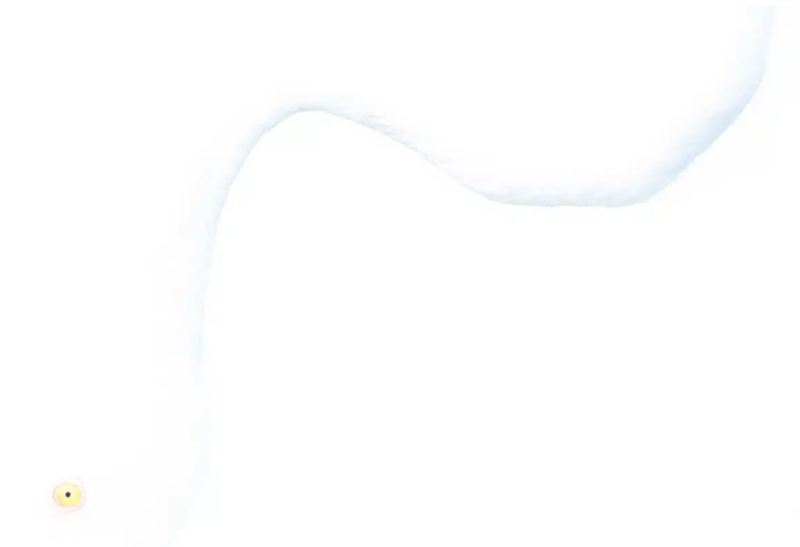
Humans and Nature - Winner: ‘My Pet Tiger’

Other Animals - Winner: ‘Disturbing Shadow’
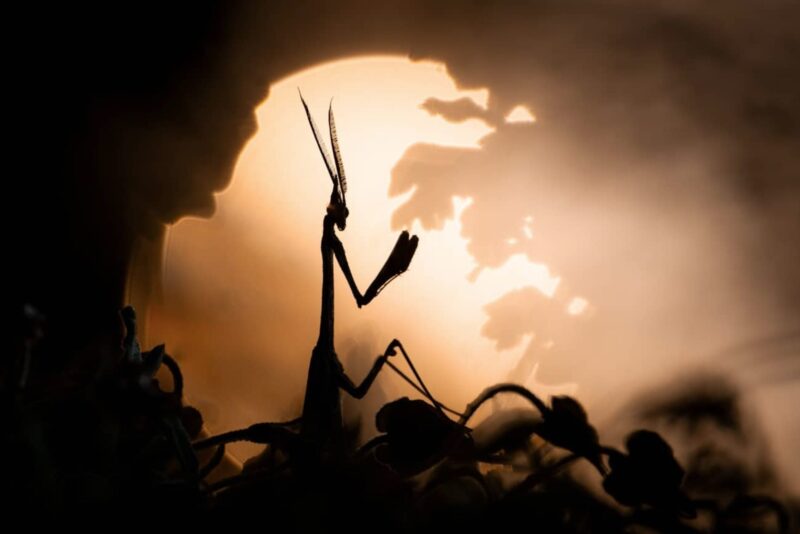
Nature of 'De Lage Landen' - Winner: ‘Colourful Seagull’
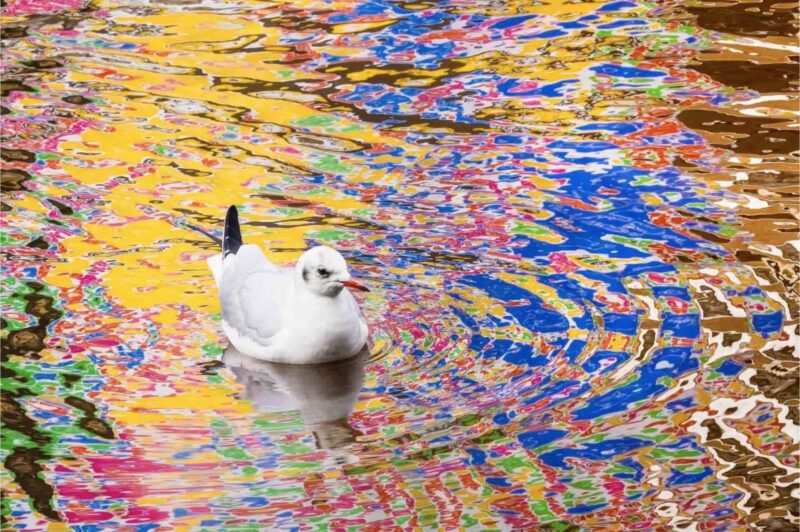
Nature Art - Winner: ‘Amino Acids Mimicking Nature’
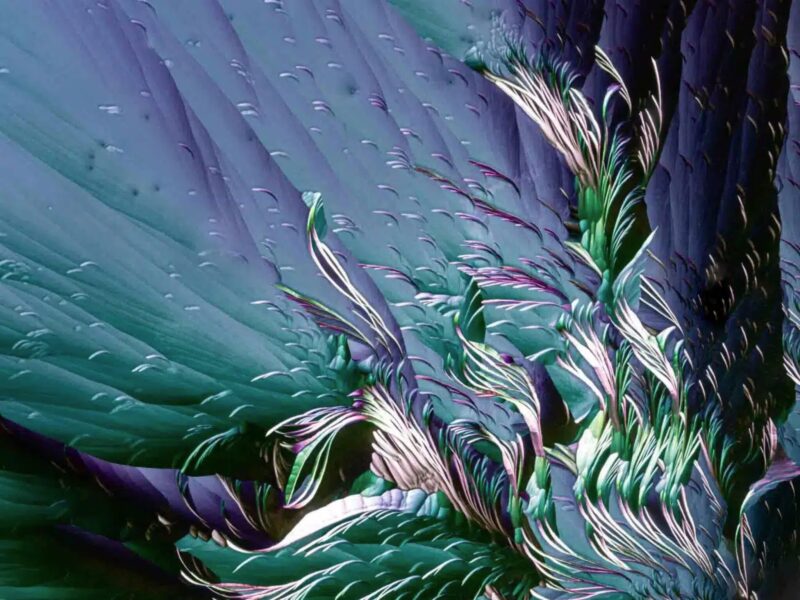
Landscapes - Winner: ‘Black Lava Beach’
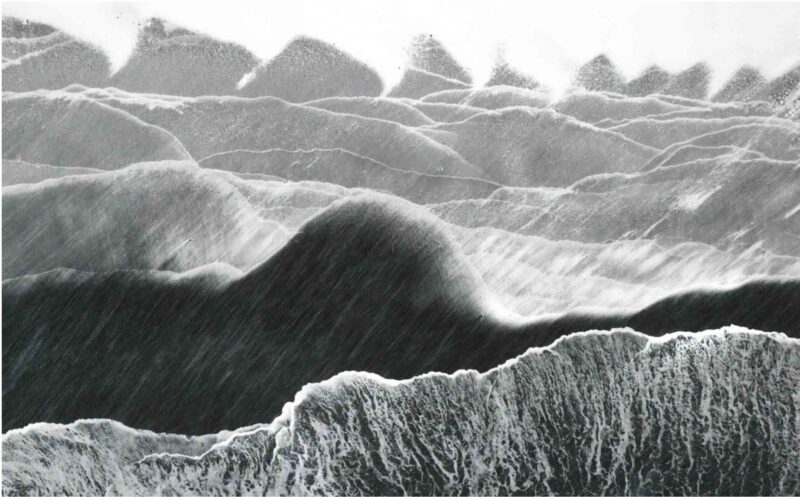
Black and White - Winner: ‘Cross to Bear'

Bad luck became serendipity for a Canadian man when his dropped camera captured dramatic whale feeding behavior.
Peter Mieras is a British Columbia-based underwater videographer. He was experimenting with attaching a camera to a fishing pole when he ran into a hiccup — the line broke, and his camera sank beneath the water.
“I thought, ‘That sucks,’” Mieras told CTV News Vancouver.
He had all the diving gear he needed to retrieve his lost camera. But before he could, a flock of birds and a group of sea lions began feasting on a dense ball of anchovies just off his dock. No videographer would pass up a chance to record that, so Mieras pulled out another camera to capture the action.
Then, a humpback whale joined in the meal, breaching several times as it pushed through the anchovies. Mieras and his wife, Kathy Johnson, spent the next two hours watching the show, then fished out the camera once the animals had dispersed.
But any footage Mieras recorded from his dock paled into comparison to what he saw when he plugged in his once-sunken camera.
The device had landed at a perfect angle to capture the hunt from underwater. In another stroke of luck, the school of anchovies lined up perfectly with the sunshine refracting through the water, meaning the humpback is in perfect silhouette as it crunches through the fish.
"This is once in a lifetime,” Mieras said of the footage.
“We just burst with glee,” Johnson echoed. “We just watched it over and over again because we just couldn’t believe what we were seeing.”
Watch it for yourself below.
From the summer of 2015 to the spring of 2016, beachgoers from Alaska to California encountered something very strange: the bodies of dead and dying seabirds.
The common murre, scientific name Uria aalge, is a type of auk. Long considered one of the most successful seabirds in the Northern Hemisphere, it's 38 to 45cm tall with a 60cm wingspan. They spend much of their time at sea but breed in large, loud colonies on cliffs and along coasts.
Washing up dead and emaciated in large numbers was uncommon for this highly adaptive bird. When researchers examined the bodies, they found that the murres had starved to death. Then, 62,000 of them drifted to shore. Those that remained alive weren’t breeding, imperiling the population even more.
But the cause and the scope of the catastrophe were difficult to measure. It is only now, almost a decade after it began, that researchers understand what happened.
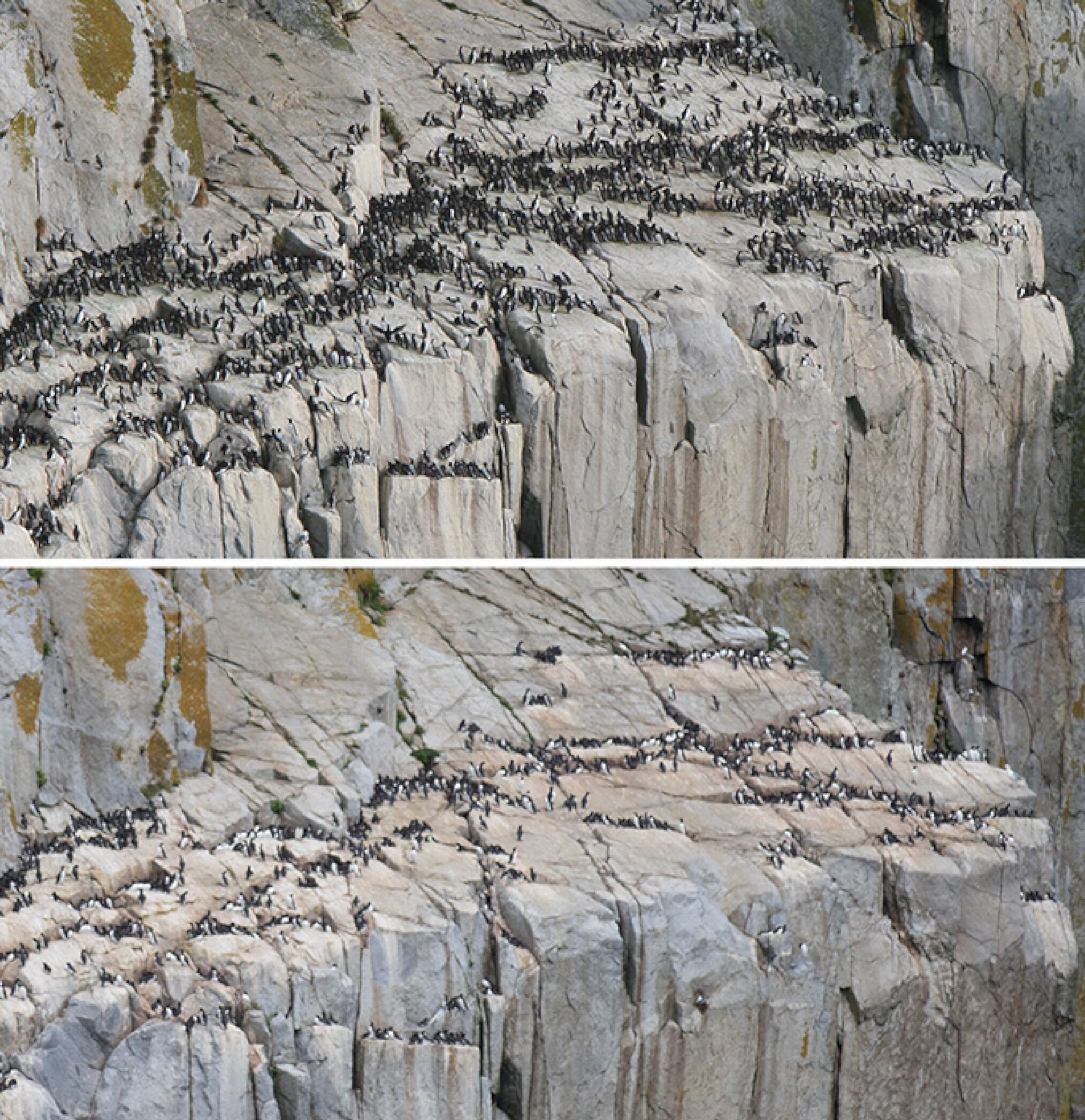
‘The Blob’
Beginning in late 2013, an unprecedented marine heat wave, dubbed "The Blob," began. A high-pressure ridge in the Pacific created a massive pocket of warm water. Between 4˚ and 10˚ higher than average local temperatures, The Blob extended as much as 1,600km across at depths up to 100m.
It surged across the ocean between Asia and North America, landing in the Gulf of Alaska in 2015. There, it remained for about a year before splitting into thirds. Now, three smaller Blobs haunt the Bering Sea, the waters off California, and the coast of the Pacific Northwest.
While the original Blob was in the Gulf of Alaska, it caused an increase in mortality across the top levels of the marine ecosystem. Fin whales, auklets, fur seals, sea lions, cod, flounder, and many more species died or failed to reproduce from 2014 to 2017. But the devastation of the murre was on an unprecedented scale.
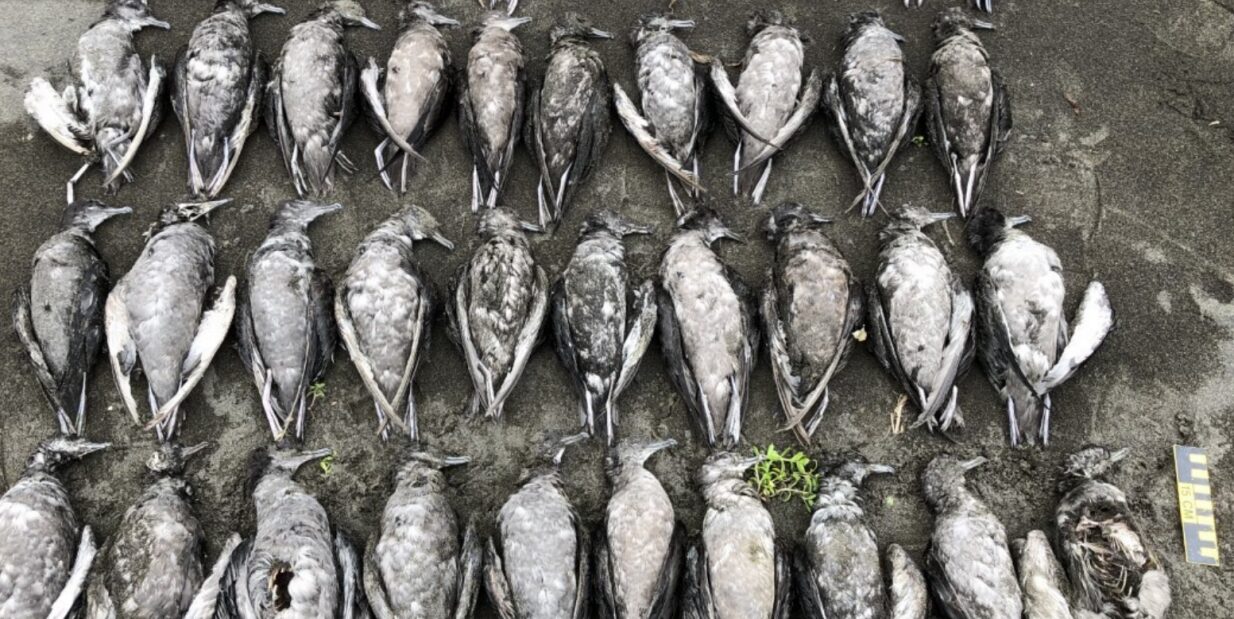
The ectothermic vise
Every level of the ecosystem was affected, leading to a cascade of mortality. The heat killed off plankton, the essential base of the marine food chain. At the same time, the cold-blooded fish, which are more active in warmer water, needed more food to sustain their increased activity.
This created conditions that researchers have dubbed an "ectothermic vise." The ectothermic (warm-blooded) seabirds were trapped between the changing populations of cold-blooded forage fish (which eat plankton) and ground fish (which eat forage fish). The increasingly active ground fish competed with the murres to eat the starving forage fish. This led to an even more extreme lack of food for the seabirds.
Only a small percentage of the birds that died ended up washing ashore, so it was difficult for scientists to get a handle on the total numbers. But they estimate that as many as four million murres died during the 2015-2016 mortality.
“The magnitude of this die-off is without precedent,” said biologist John Piatt. In some populations, half the murres died of starvation. It was the “largest mortality event of any wildlife species reported during the modern era.”

The future of the murre
The large and raucous colonies of murres remain quieter, not just because of the starvation event but also because of a lack of new chicks. During 2015-2016, 22 colonies failed to produce a single chick, and many others had fewer than usual.
It’s been almost a decade since The Blob descended upon the common murre. Time, however, has not healed all wounds. The population is not recovering. Why this is, researchers aren’t entirely sure. One theory is that the much smaller colonies are harder to defend. Fewer birds mean more eggs stolen by gulls and other predators. This, in turn, means fewer birds.
They may bounce back in time, although the world hasn’t seen the last of The Blob. As climate change warms the oceans, delicate marine ecosystems will face population collapse, and the common murre may become common no more.
Two Amur tigers, separated by almost 200km of Russian forest, have found each other again. The unexpected romance is a glimmer of hope for the critically endangered species.
Conservationists rescued the two tigers, named Boris and Svetlaya, from the Sikhote-Alin mountains when they were just a few months old. Both were orphans and would not have survived on their own in the wild. They were placed into a conservation program with other tiger cubs in 2012 and raised with live prey and minimal human contact. The plan was always to release the cubs at 18 months old.
In 2014, conservationists duly released Boris and Svetlaya in the Pri-Amur region. Sitting on Russia’s border with China, it is historically a home to the big cats. The endangered tigers now inhabit just a fraction of their old range, but experts estimate there are 700,000 square kilometers of suitable habitat for the tigers across Asia.
The project's main goals were to restore the dwindling populations of Amur tigers and to spread their distribution. For this reason, researchers separated the cubs by hundreds of kilometers throughout the forest and tracked them for over a year.
At this point, an unexpected love story unfolded. Boris, not content with his new lonely life, began walking. He continued for nearly 200 kilometers until he found Svetlaya. Six months later, she gave birth to a litter of cubs.
Rewilding success
It is the first time that rewilding big cats has been attempted. The conservation project (2012-2021) included 13 cubs that had been raised in captivity. Twelve of the 13 proved as capable of hunting as wild tigers and were successfully released back into the wild throughout the Pri-Amur region.
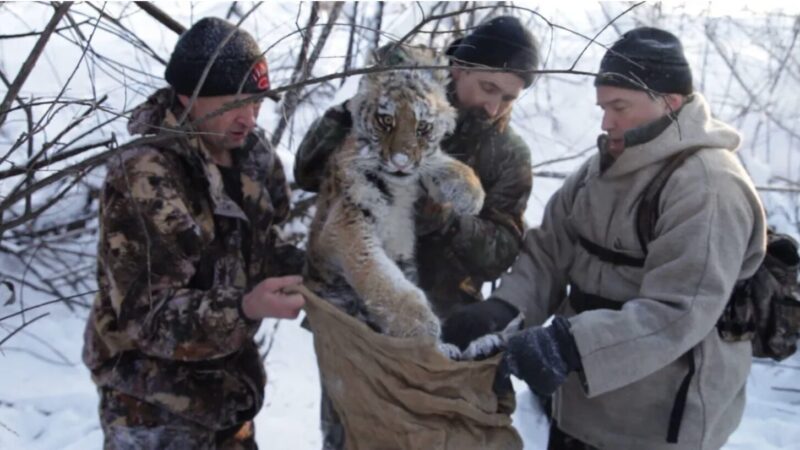
To increase the odds of survival, all the tigers were released during spring, when prey is most abundant. So far, it has been a near-perfect success. Zolushka, another of the female cubs in the project, crossed paths with a male shortly after release. Considering their tiny numbers, this was a huge stroke of luck. Her litter of cubs was the firstborn in that forest in over four decades. In total, six litters have come from the rewilded tigers.
Reason for optimism
“These results indicate that it is possible to care for young cubs in a semi-captive environment, teach them how to hunt, and release them back into the wild. These findings provide a pathway for returning tigers to large parts of Asia where habitat still exists but where tigers have been lost,” said Viatcheslav Rozhnov, leader of the reintroduction project.
Though the project shows great promise, caution is still needed. One rewilded tiger crossed the border into China, into an area where prey is scant. He proceeded to wander into a human area and killed domestic animals, including 13 goats in one night. The tiger has now been placed in a zoo.
The happy ending of Boris and Svetlaya's story shows that tigers can be successfully re-released into the wild with proper isolation from humans and the opportunity to learn to hunt.
"But this process requires...attention to details in preparing cubs for this journey,” said Dale Miquelle, the lead author of the study.
Humpback whales live in all the world's oceans, from the Arctic to the tropics to the Antarctic, and many of them make annual migrations between 3,000 and 8,000km. But one individual has gone on a record-breaking tear from one side of the world to the other.
Humpbacks typically migrate in fixed, roughly vertical patterns. Northern populations move from the Arctic in the summer to the Caribbean, for example, while southern populations swim from the Antarctic to the equator. Not all humpbacks migrate. Arabian Sea populations are homebodies and don’t move much.
Humpback migrations are fairly consistent; different populations don't mix much. This has changed in recent years, however. A mature male humpback has just traveled over 13,000km between usually separate populations.
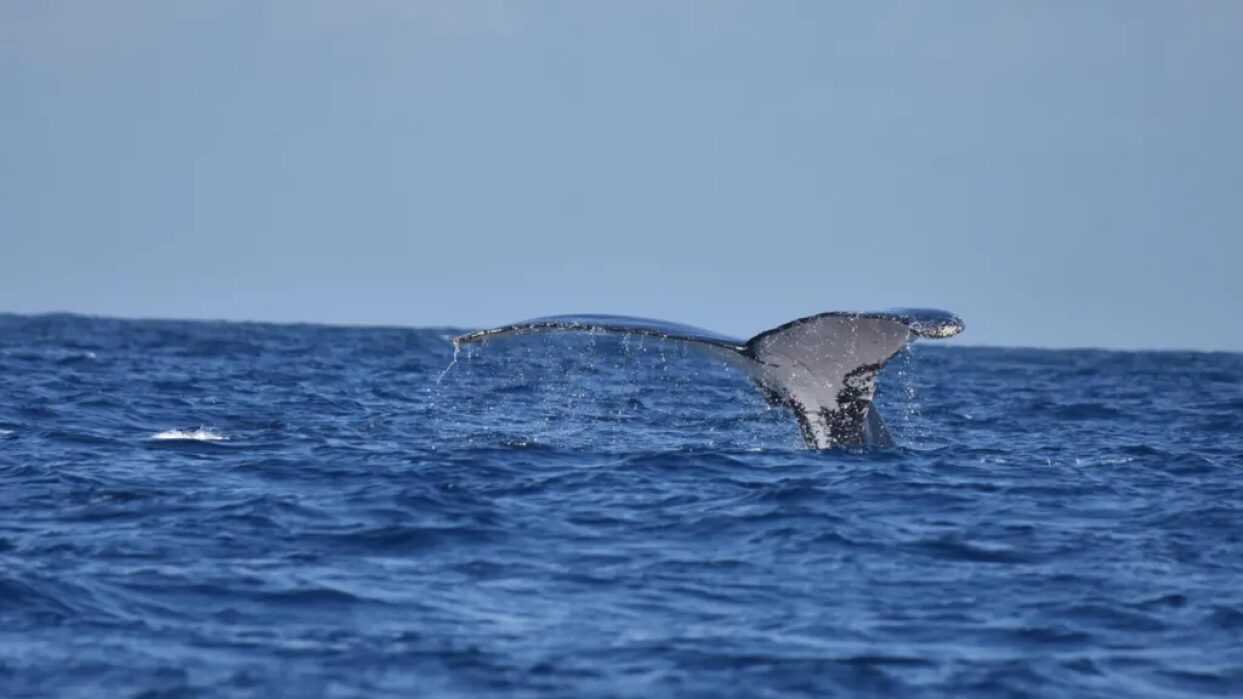
Happywhale
In 2013, a male humpback was spotted in the Gulf of Tribugá in the Pacific Ocean off Columbia. Then, in 2017, he was sighted again, less than 80km away. Both times, he was traveling with other whales. Individual whales are often identified by their fluke patterns, which are as distinct as fingerprints.
In August of 2022, Ekaterina Kalashnikova, a marine biologist with the Bazaruto Center for Scientific Studies, saw the same whale in the Zanzibar Channel. This Indian Ocean waterway lies over 13,000km from his last known location.
She posted the sighting to Happywhale, a site that identifies individual whales based on user-submitted photos and then tracks their movements. In this case, the whale was identified based on a distinctive “lack of a hemispherical lobe near the genital slit.” He was once again traveling with a group of fellow whales.

A horizontal marathon
Researchers don’t know what route the male took, and he likely followed an indirect path. He may have gone much further than 13,000km during the five years between appearances.
The horizontal distance this whale covered is particularly unusual. He had gone 120 degrees of longitude from northwestern South America to southeastern Africa. He had also gone from the eastern Pacific breeding stock to the southwest Indian Ocean stock, which researchers had never seen happen before.
And he had done it as an adult. Previous research has indicated that changes in migration patterns occur mainly in young males. But this individual had already been sexually mature when he was first seen in 2013. By the time of his journey, between 2017 and 2022, he was well into adulthood, and his range should have already been established.
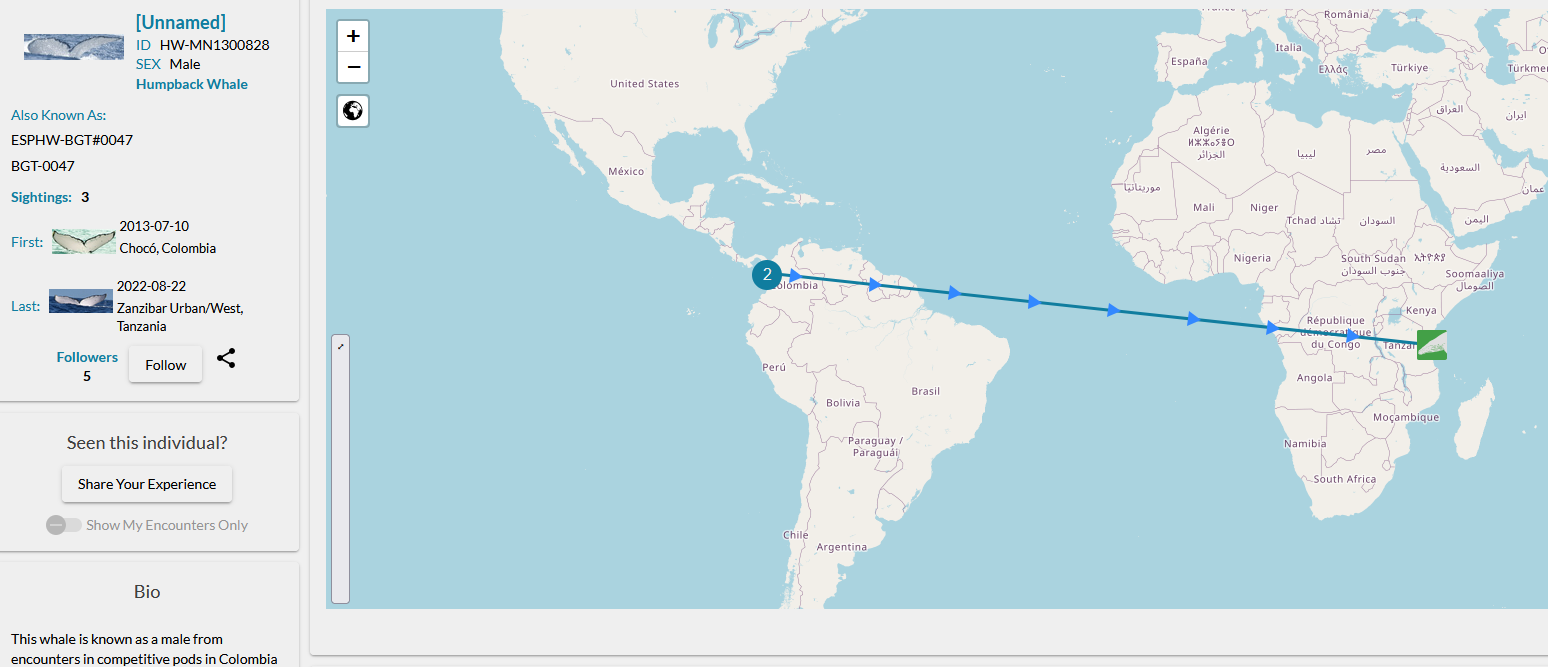
Expanding range?
What drove this male humpback to make such an incredible journey? It’s possible that he was compelled to search for a mate. But climate change could provide another answer.
A changing climate has been affecting the distribution of krill populations in the Southern Ocean. This might drive an enterprising whale to alter its feeding behavior and seek out new grounds.
But this could also be a result of recovery. Centuries of whaling devastated humpback whale populations, but conservation efforts have prompted an impressive increase. Their range has expanded, too, with populations moving into the Bering Sea and the Mediterranean. Higher populations mean more competition, forcing some individuals to travel greater distances for food and mates.
Modern tracking technology, and efforts like those of Happywhale, make it much easier to track whale populations and their movements. So although this whale's journey halfway around the world is mysterious now, future research will allow scientists to better understand what drove him to travel so far and how common these marathon pilgrimages really are.
While unnamed, the male has been given the identification number HW-MN1300828. Using this number, users on Happywhale can continue to track him in the years to come.
Sri Lanka has a new answer to toll booths -- a tax-collecting elephant. Instead of searching the car for some spare change, you must offer up a tasty snack before Raja allows you to pass.
Raja, a 40-year-old male elephant, collects his payments on the Buttlala-Kataragama road that links Sri Lanka’s west and southeast coasts. He will stand by the side of the road and then step onto it when a promising vehicle approaches. At a whopping four tonnes, Raja uses his sizable bulk to block the road. He then waits until he is given payment before moving out of the way.
The clever elephant does not stop every vehicle. He has realized that larger vehicles and buses have the most to offer, so he tends to block those. Once the vehicle stops, he gently pokes his trunk in through a door or window to ask for the toll.
Celebrity status
His behavior has made him a minor celebrity in Sri Lanka. Travelers often buy fruit in advance in case they bump into the large elephant. No one seems to mind that he slows down traffic. Seventy percent of the population in Sri Lanka are Buddhist, and many others practice Hinduism. Elephants are deeply respected within both religions.
Raja is not the only elephant that stops vehicles on this patch of road, but he is the original pachyderm tax collector. Videos of the elephant have gone viral on social media after he unknowingly became a star of Asia, a BBC documentary series presented by David Attenborough. It explores the continent's incredible wildlife and natural wonders. While filming in Sri Lanka, they came across Raja.
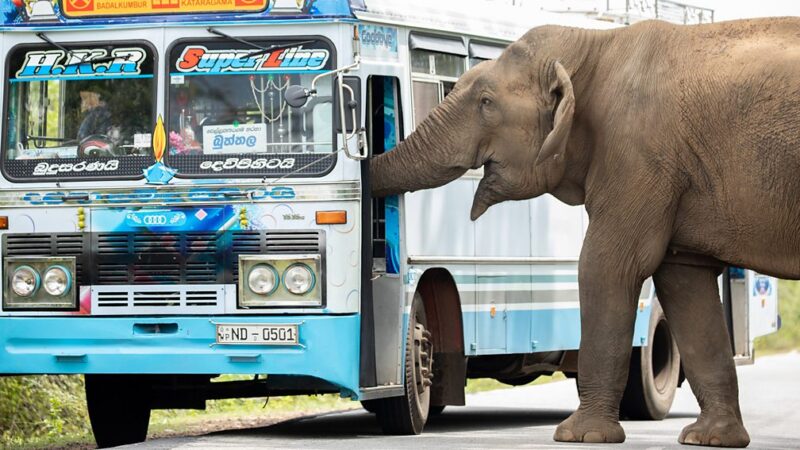
They arrived at the roadside at 6 am sharp every day, and every day Raja was there to greet them, ready for another busy day of stopping cars and collecting snacks. While some of the younger elephants along the road sometimes become aggressive, Raja is a gentle giant.
“Raja was a magnificent 40-year-old elephant who has been hustling by the side of the road longer than any other elephant on this highway,” commented Seth Daood, a researcher for the series. "In fact, he had laid down the blueprint for how to get food from vehicles on the road."
While swimming with a young female humpback, photographer Rachel Moore captured an extraordinary closeup of the whale's eye in French Polynesia.
The juvenile was gamboling around with a few spinner dolphins and seemed quite curious about the swimmers in the water. So although Moore was at the end of her shooting day, she decided to go in the water again. As soon as she did, the whale -- known locally as Sweet Girl -- approached her closely.
“For the next five minutes, we stared eye-to-eye at the surface, with her coming...just inches away," recalled Moore. I zoomed in with my 16-35mm lens...and just as she rolled upside down, I pressed the shutter, capturing the last bit of sunlight illuminating her eye.
“The way she looked at me left an indelible mark on my memory," said Moore. "It was one of the most powerful and profound moments of my life."
The photo shows the eye in more detail than ever before. In real life, the eye was the size of a grapefruit. The image shows an electric blue ring around the pupil and the insulating fat that protects the eye.
Through no fault of the photographer, the story did not end happily. Days later, Sweet Girl died when hit by a ship.

Call for slower speeds
The Island of Mo’orea, where the photo was taken, is famous for its humpback whales. Its waters are a birthing ground for them as they journey to Antarctica. Earlier this year, Indigenous groups across Polynesia signed a historic treaty granting whales personhood. They do not see them simply as animals but as a significant part of their history and culture.
The death of Sweet Girl has prompted calls for more protection. Nearly 50,000 people have signed a petition asking for reduced ship speeds in the region.
Moore, a long-time ocean advocate, agrees and worries about many tourists' behavior toward the ocean giants.
“Our goal should always be to respect these animals and their space, observing their behavior without disturbing it," she says. "Whales are here to rest, mate, give birth, and nourish their young. Chasing after them only drains the energy they need during their six- to eight-month fast.
"Swimming with these majestic beings is a privilege, and respecting their space is crucial — there's no need to chase after or force interactions. On rare occasions, whales may choose to interact on their own terms.”
The fashionistas of the ocean have spoken, and it’s official -- salmon hats are making a comeback.
Initially a trend in the 1980s, the dead salmon hat is once again hitting the runways of the Salish Sea in Washington, at least among orcas. One trendsetting female first wore the stylish headpiece in 1987. Within a matter of weeks, three pods of killer whales in Puget Sound donned the dead fish accessory. But as fads do, as quickly as it started, it was soon dead in the water.
Three-and-a-half decades later, Blackberry the orca has brought it back. Local photographers and researchers were shocked to see her attempting the daring look. “We saw one [orca] with a fish on its head. So that was fun –- it’s been a while since I’ve personally seen it,” said Deborah Giles, research director at Wild Orca.
Putting her own spin on it, Blackberry perfectly balanced the large dead fish next to her blow hole. In the 1980s, perching the salmon closer to the end of the orca's snout was the more popular option.
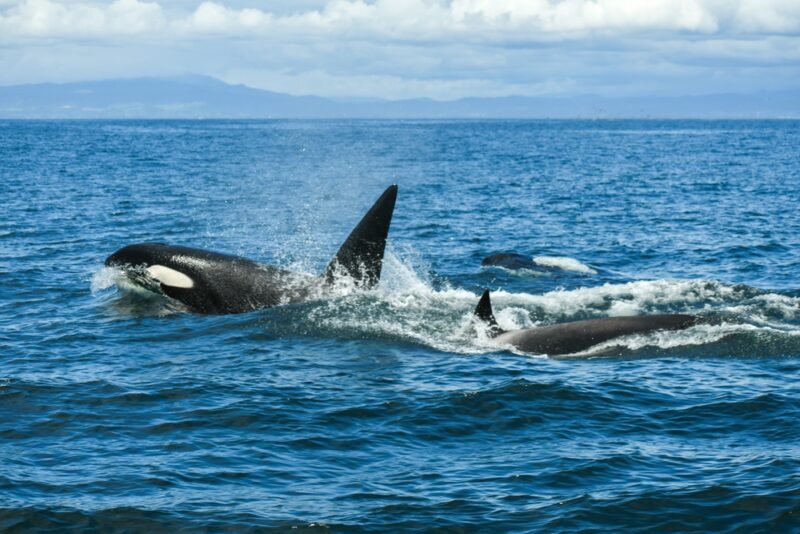
Whales seem to like hats
Flamboyant headgear has often been a popular choice in the cetacean world. Just last year, hundreds of whales were spotted donning kelp hats. Research suggests that kelp hats are both stylish and practical. They offer antibacterial properties and a rough surface to rub off stubborn barnacles.
Blackberry belongs to a group of killer whales known as the "J pod," and this year, they have stayed in the region much longer than they usually do. The whale sighting network believes this is because of the abundant salmon stocks available at the moment. Like the kelp hats, researchers suspect that the vogueish salmon hats might serve another purpose. In this case, they also act as a lunch box.
Stashing away food for later has been seen in killer whales before. Other orca populations sometimes stow chunks of food under their pectoral fins in case they feel peckish. In the 1980s, researchers were less able to study the salmon hat craze. This time, drones have allowed scientists to follow the trend. Observing one male with a drone, Giles and her team noted that he wore the hat-cum-snack-box for half an hour before eating it.
The researchers hope to follow more of the J-pod to finally understand the logic behind the trend. We just have to hope that the revival lasts longer than it did in the 1980s.
Every week, nature unveils its quirks in unexpected ways — whether through bizarre new animal behavior, the sighting of a creature thought to be extinct, or an uncanny interaction between species that defies the usual rules of survival.
Here are our best wildlife oddities of the week.
Crows Hold Grudges for 17 Years: Don't get on the wrong side of a crow. Like the proverbial elephant, it won't forget. A new, decades-long study shows that the intelligent black birds can hold a grudge against humans for up to 17 years. Crows also tell their kin about the threatening human in question, and they too will take up the grudge.
In 2006, environmental scientist John Marzluff wore a "fearsome" mask and trapped seven crows. Before letting them go, he tagged them with leg rings. Over the years, he sporadically walked around his university campus in the mask, feeding the crows. In one of these strolls, he encountered 53 crows, and 47 began scolding him. This is a far greater number than the seven crows he initially trapped. Clearly, the crows somehow spread the word.
Marzluff continued this study until 2023, regularly going out in the mask. In 2013, seven years after trapping the crows, the number of birds who were aggressive toward him reached an all-time high. After that, it decreased until finally, in 2023, not a single crow scolded Marzluff on one of his walks.
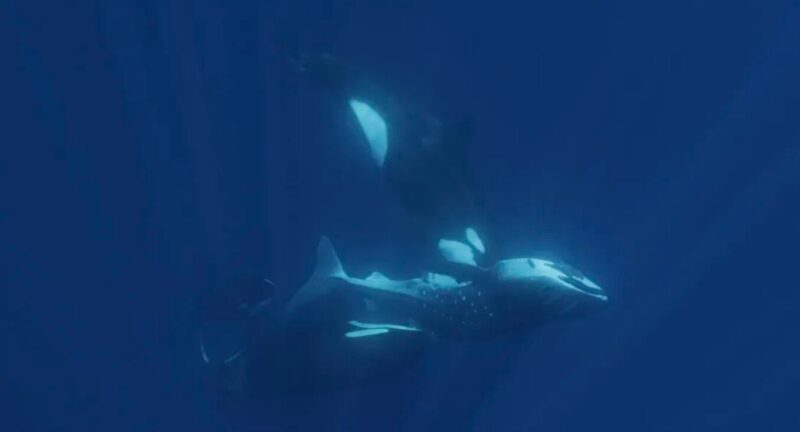
Orca strategy
How Orca Pods Hunt the World’s Largest Fish: At up to 18m long, whale sharks are the world's largest fish. Taking on such gigantic prey is difficult even for orcas, but they have devised a strategy to prey on at least the younger sharks.
Despite their shark heritage, whale sharks are the gentle giants of the ocean. They have almost no defense against orcas except for their size and deep-diving skills. Researchers have followed an orca pod off the coast of Mexico for six years and captured footage of them hunting whale sharks.
The orcas start by swimming into the whale shark at high speed and then flipping it over so it is belly-up in the water. In this upside-down position, it seems to enter a state of immobility, as if paralyzed by fear. The orcas then rip open its abdomen and begin eating its internal organs.
Researchers think the orcas hunt the large sharks for their nutrient-rich, fatty livers, as with some other species of shark.
Creepy but useful
Little Bird Tricks Swarm of Ants: Safari guides in South Africa have captured footage of a small hornbill bird tricking ants into cleaning its feathers. The little bird sits quietly on top of an active ant colony and lets them swarm over her entire body.
This sounds like most people's worst nightmare. But the bird cleverly uses the small army of ants to clean its feathers, a process known as "anting." As the ants crawl over the bird, they secrete formic acid, which kills off the parasites within the feathers. Like the little hornbill, some birds passively sit and let the ants get on with it. Others actively rub ants over their feathers to rid themselves of the pesky parasites.

Woman Killed by Wild Boar: A wild boar has killed a 76-year-old woman in Northwest China’s Shaanxi Province. The boars had been damaging crops, and four people from the nearby village tried to take matters into their own hands.
They took hunting dogs into the mountains to chase the wild boars away from the crops. But one of the boars, chased by the dogs, ran towards a local farm and entered the yard. It was here that the boar attacked the woman. She sustained serious injuries and died later in hospital.
Bones and fossils found in caves show that polar bears once roamed the Scottish Highlands. Initially thought to belong to brown bears, new analysis of the bones and teeth prove they actually belonged to their arctic cousins.
Bears are not often associated with Britain, but they were once common here. They went extinct around 1,000 years ago. The University of Aberdeen and National Museums Scotland have been reviewing the ancestry of bears in Scotland. When they re-studied a fossil collection from the Inchnadamph Bone Caves, they discovered that the bears that stalked across the Highlands 30,000 to 50,000 years ago had a heavy seafood diet. This differed considerably from the diet of modern brown bears, which feed on meat and plants, and of other ancient bears in Britain.
From this, they concluded that polar bears lived in Scotland during the last Ice Age.
“These bears appear to have lived almost exclusively on seafood," said study co-author Kate Britton. "Even modern grizzly bears, known to gorge seasonally on salmon in some places, don't show anything close to this level of seafood consumption in their diet.”
The huge disparity in diet means one of two things. Either brown bears ate differently in the past, or the bones and teeth belong to a different species of bear.
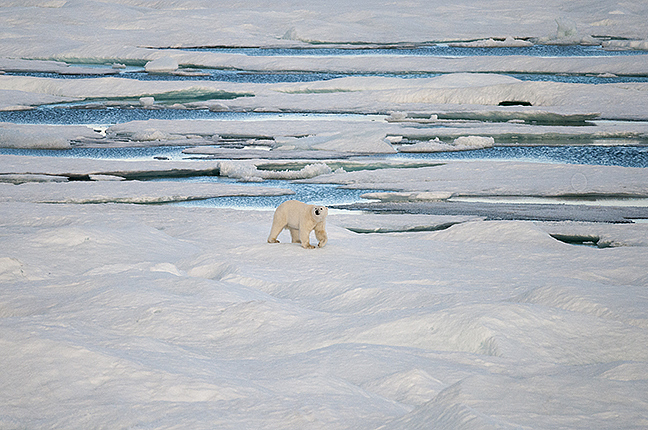
Great swimmers
The idea that they might belong to a polar bear is not that far-fetched, considering the climate at the time. During the last Ice Age, sea ice in the Atlantic Ocean would have stretched into more southerly waters. Polar bears are excellent swimmers. Even today, individuals have been spotted more than 300km away from land. To reach Scotland is far from impossible. Even Greenland Inuit in their kayaks found their way to Scotland on at least one occasion.
So far, this is the only evidence that polar bears once roamed the UK. But if Ursus maritimus was here, it would likely have encountered ancient brown bears.
The next step is to look for crossovers in DNA. Currently, the team is analyzing modern polar bears for brown bear DNA and examining the remains of Ice Age brown bears for polar bear DNA.
“We know that polar bears and brown bears can successfully interbreed today where their ranges overlap," said co-author Andrew Kitchener.
The juried winners of the 60th Wildlife Photographer of the Year contest were announced earlier this year, but the People's Choice Award contest is still in full swing. And you can help select the winner.
The contest's organizer, the Natural History Museum in London (NHM), selected 25 finalists for the award and posted the images on its website. Members of the public have until January 29 to make their choice. The museum will announce the winner and four runners-up on February 5. Head over to the NHM's website to cast your vote.
There's a limit of one vote per person, and votes cannot be changed — so choose carefully.
In the meantime, here are some of ExplorersWeb's favorites.
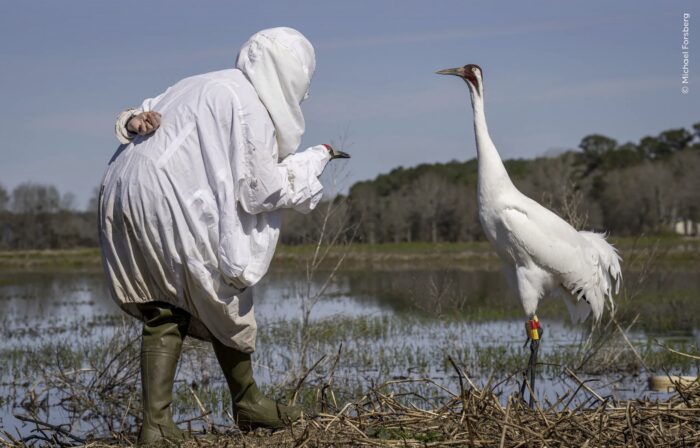
Biologist in disguise
Michael Forsberg captured this dynamic shot of science in action as a part of his ongoing effort to chronicle the lives of whooping cranes. The disguised biologist in this photo was attempting to get close enough to the crane to change the transmitter on its leg.

A barn owl leaves its perch at dusk. It took photographer Jess Findlay 10 nights and a motion-sensitive flash to capture this haunting and haunted image.
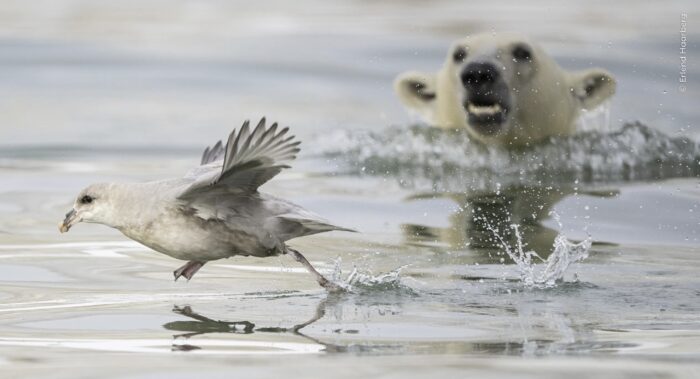
This photo is called "Sneak Attack" for obvious reasons. According to photographer Erlend Haarberg, the polar bear cub shown here was more interested in ambushing northern fulmars than it was in eating the walrus carcass its mother had found.

Minimalism is the name of the game with Michel d'Oultremont's simplistic image of a stoat in a snowstorm. The photographer has been photographing stoats for years, but this is the first time he has encountered one in his native Belgium. To get this shot, d'Oultremont took a page from the stoat's playbook and camouflaged himself in white.
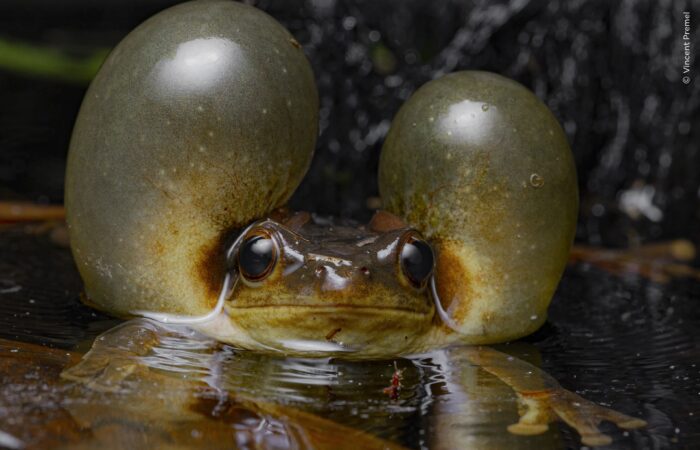
Herpetologist and photographer Vincent Premel captured this Surinam golden-eyed tree frog mid-concert just as the first rains fell over French Guiana.

Irritated owl
Nobody does bemused or irritated quite like an owl. Photographer Bence Mate named this photo of a little owl (that's the species' common name) and a European roller "Annoying Neighbor." To get the shot, he spent 27 days in a blind, waiting for the right moment.
You can see all 25 of the photos in the running for the People's Choice Award on the Natural History Museum's website.
A solitary bottlenose dolphin has been roaming the Baltic Sea since 2019. The only one of his kind in the Baltic Sea, he has been completely alone for the last five years. Without any pals to keep him company, he seems to have been muttering to himself.
The dolphin, known as Delle, has captured the hearts of locals and the curiosity of marine biologists. Bottlenose dolphins are inherently sociable and usually inhabit warm and temperate waters. They are a rare sight in Denmark, which makes Delle so interesting to researchers. He has been solo since he was first spotted in the Svendborgsund Channel. Despite its chilly waters, he seems keen to stay in the region. Distinctive markings on his dorsal fin show that before his unusual migration, Delle was one of a well-researched pod of dolphins off the coast of Scotland.
Using underwater recording devices, a team from the University of Southern Denmark listened to Delle's various noises for three months. They expected to hear him making some noises but assumed he would be relatively quiet since he was by himself. That could not have been further from the truth. To the researchers' surprise, he made 10,833 different sounds.

Mysterious chatter
“I thought we might pick up a few distant whistles or something along those lines," Olga Filatova, lead author of the study, told Live Science. "I certainly didn’t anticipate recording thousands of different sounds. If we hadn’t known that Delle was alone, we might have concluded that a group of at least three dolphins was engaged in various social interactions.”
The complex vocals are usually associated with dolphin-to-dolphin communication. This suggests he is having an ongoing conversation with himself. Researchers detected everything from the whistles and high-pitched clicks normally heard during echolocation and social interactions to deeper noises usually linked with territorial behavior. He even made "signature whistles" -- noises that dolphins make to identify themselves. They're a bit like a nametag.
Why he is making the noises is a mystery. Initially, researchers thought he might be attempting to communicate with nearby humans. But he was also making them at night when no one was around. Researchers now think he could be trying to distract himself from loneliness like humans often do when they are alone. He could also be making involuntary noises like when we laugh aloud, reading or seeing something funny.
It is an intriguing window into the behavior and psychology of another species. Though the researchers are speculating on what the noises might mean, they admit we must be “cautious in drawing conclusions about other species with complex communicative systems.” We still don’t fully understand why humans talk to themselves, let alone why Delle the dolphin is doing so.
An emperor penguin that swam 3,500km from Antarctica to Australia was released back into the chilly waters of the Southern Ocean this week.
The only emperor penguin to make such a marathon migration, Gus -- as his caregiver, Carol Biddulph, dubbed him -- had gained weight during his time as a minor Australian celebrity. He was a scrawny 21 kilos when he unexpectedly waddled onto a beach in southwest Australia on November 1. Under Biddulph's care, he increased to a slightly more stocky 24.7 kilos.
Healthy male emperors can weigh more than 45 kilos. But wildlife officials felt it was important to turn Gus loose before the Australian summer made life even more difficult for a creature more used to -40 than +40˚C.
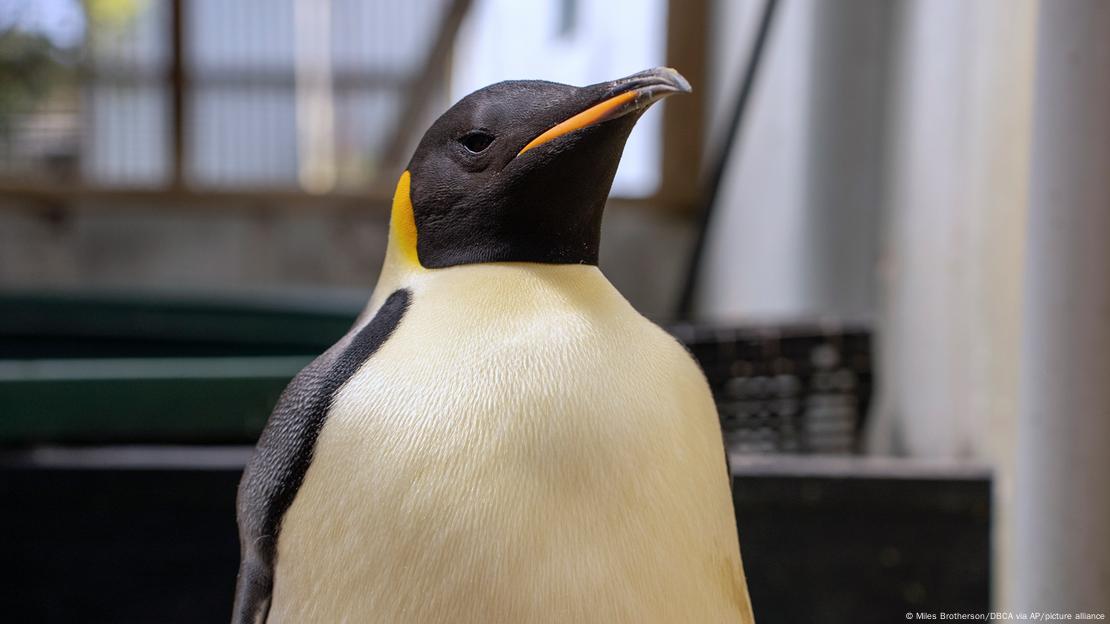
“I really didn’t know whether he was going to make it to begin with because he was so undernourished,” Biddulph said in a video released today by the government.
As she had done with other orphaned penguins, Biddulph added a mirror to his enclosure for company so that the social bird would not feel quite as solitary.
"I think that has been crucial in his well-being," she said. "He [stood] next to the mirror most of the time.
The boat traveled several hours into the ocean before Gus was released, so he had a bit of a head start.
"I've got every faith he will get home," she added.
Photographer and conservationist Carlos Gauna has captured footage of five great white sharks circling a poisoned sea lion. Known as the Malibu Artist, Gauna highlights the ongoing issue of domoic acid poisoning in California.
The sea lion seems to be suffering from paralysis due to domoic acid poisoning. Lying near the surface of the water, it occasionally lifts its head to breathe but otherwise barely moves. Throughout the video, five great white sharks swim around the stricken sea lion as it floats in the water. Says Guana, who focuses on great white sharks, “You undoubtedly know why they are there. Like most predators, white sharks are animals of opportunity.”
All five sharks approach their potential opportunity quite cautiously. None of them attempt to eat the sea lion. Even when some get incredibly close, they all end up retreating. They seem to be weighing whether they should strike.
Guana believes that their constant circling is a method of gathering information about their potential meal. All conclude that the risk is too high.
Where the toxins come from
California is home to a huge population of sea lions, and great whites are one of their most common predators. But there is an ongoing problem in the Golden State. Algae blooms are killing off its sea lions and other marine creatures, and these blooms release a dangerous neurotoxin.
Domoic acid outbreaks have occurred along the southern California coast for months. Upwellings of cold, nutrient-rich water feed these huge algal blooms, contaminating the fish and shellfish that chow down on these toxic diatoms.
In turn, the domoic acid builds up in the food chain. Giancarlo Rulli of the Sausalito Marine Mammal Center told The Los Angeles Times, “The levels we're finding inside these animals is off the charts."
The center has received many reports of sea lions becoming aggressive toward beachgoers and other unusual behavior. The main symptoms of the poisoning are lethargy, aggression, seizures, vomiting, miscarriages, and death. Domoic acid events are not new in the region, but researchers worry that they are becoming longer-lasting and more frequent.
Food-habituated bears sometimes break into backcountry cabins and cars at campgrounds. Once every long while, there are disturbing human-bear conflicts. But sometimes, bears just get accused of things they didn't do.
Last month, a bear was initially blamed for killing Montana camper Dustin Kjersem. State police later charged a human suspect with murder. And this week, law enforcement authorities in Los Angeles arrested four men in a bizarre insurance scam.
The men are accused of trying to bilk two insurance companies out of nearly $142,000 by blaming a bear for damage to a Rolls Royce and two Mercedes in the San Bernardino Mountains earlier this year.
In two separate claims to different companies, the men provided a grainy, nighttime video of the marauding "bear" inside the vehicles. They also showed what appeared to be claw marks on the seats and doors.
But something was fishy. Insurance investigators believed that they were watching not a bear but “clearly a human in a bear suit,” the insurance department said.
To confirm their suspicions, they sought out the expert opinion of biologist Kevin Howells with the California Department of Fish and Wildlife. Howells pointed out “visible slack in the suit.”
“As soon as the bear came into frame, to me, it was pretty quick and fairly obvious that it was not [a real bear],” Howells told The Washington Post.
Detectives executed a search warrant for what had been dubbed Operation Bear Claw and found the costume in one of the suspects' homes.

There's an old truism that's well worth remembering if you're scared of sharks. You're more likely to get struck by lightning, killed by fireworks, or have a stroke than you are to perish from a great white.
But attacks do happen, and the main problem is that great white sharks probably mistake surfers and their boards for seals.
Thankfully for wave chasers, researcher Laura Ryan of Macquarie University in Sydney has made what may be a game-changing discovery. She and her team recently spent over 500 hours studying great white shark hunting behavior using decoy seals. It led to a simple, effective method for deterring accidental shark attacks on surfers.
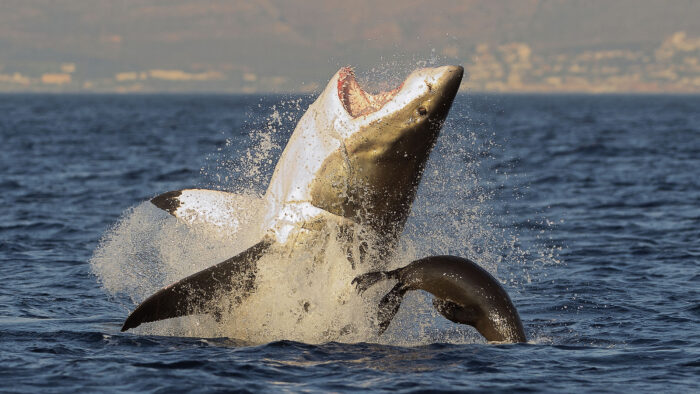
Lighting decoys
The experiment was fairly simple. The team rigged up a series of seal-shaped decoys with a variety of lighting arrays — vertical and horizontal strip lighting, as well as strobe lighting of varying brightness. Then they towed the decoys and observed what happened. After each tow of a lit decoy, Ryan immediately towed an unlit decoy (the control group) and compared the results.
“We have taken the approach of understanding these animals’ sensory system and how they see the world, [with] their behavior," Ryan told New Scientist.
The results, published this week in the journal Current Biology, are intriguing. The great whites followed or attacked the unlit control dummies the most. They showed less interest in strobe-lit dummies and even less in dummies with vertical striped lights.
However, the sharks still showed some interest. Probably, Ryan said, because those configurations still allowed the sharks to make out the silhouette of potential prey.
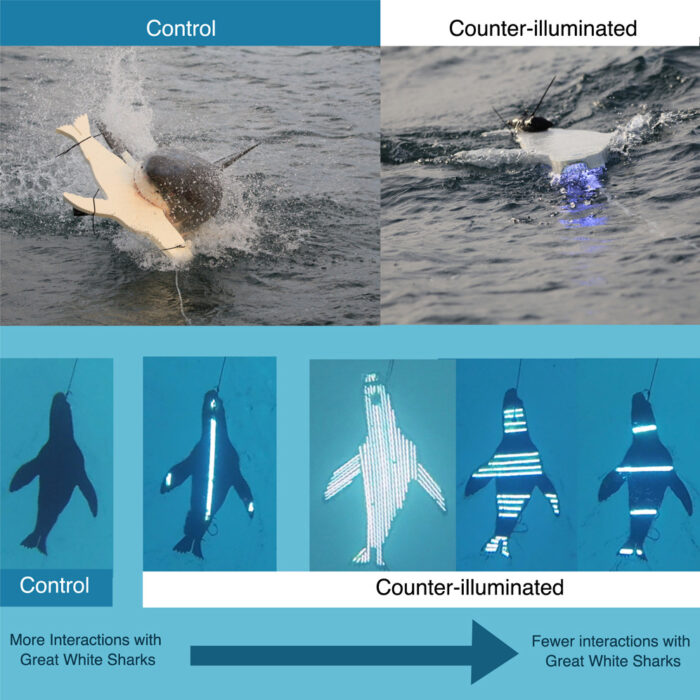
Brighter than the background
Horizontal lighting turned up to the brightest setting, on the other hand, was the clear winner. During the study, great whites showed zero interest in decoys lit in such a fashion. Horizontal lighting apparently broke up the silhouette enough to avoid a predation response.
“The most critical thing was that the brightness on the decoy had to be brighter than or equal to the background light,” Ryan said. “As long as the lighting stopped the silhouette from looking black, it seemed to work.”
This is great news for surfers and a good example of research that could have an almost immediate benefit.
“We are now moving from research into providing protection for swimmers and surfers,” the scientist noted.
Ryan has previously been involved in magnet-and-electrical-based shark deterrent research. But it seems likely that LEDs will find their way onto surfboards well before complex magnetic gizmos will.
She pointed out the study focused only on great whites. The method has yet to be tested on other sharks with a record of human attacks, such as tiger sharks and bull sharks.
Beachgoers in Denmark, Australia, were shocked to see a lone emperor penguin waddling out of the ocean last week. This species, the world's biggest penguin, lives only in Antarctica. This is the farthest north one has ever appeared.
Nicknamed Gus, the penguin swam 3,400km from its icy home to Western Australia. Aaron Fowler was on the beach when it came ashore and described the scene.
“It was massive, way bigger than a seabird, and we are like, what is that thing coming out of the water?” he told ABC News. "And it kind of had a tail sticking out like a duck. It stood up in the waves and just waddled straight up to us...He was probably about a meter high, and he was not shy at all."
Providing entertainment for those around him, Gus then attempted a belly slide, as penguins do on ice, only to end up with a face full of sand. Unperturbed, he stood up and shook the sand off before continuing his exploration of the beach.

Carol Biddulp, a bird caregiver with the Department of Biodiversity, Conservation, and Attractions, is now looking after the malnourished migrant. She admits she never expected to be caring for a lost emperor penguin.
Skinny after long swim
Gus was underweight to the point that his bones were visible. Given his poor condition and the hubbub that would have occurred if this unique attraction had stayed on the beach, Biddulp brought the bird in.
This was not as easy as it sounds. Even in his malnourished state, Gus weighed 23 kilograms. “Getting him back to the car was quite a challenge," she explained. "We got him into a carrier, a large canvas pet carrier, nice and soft, into the car and home.”
Why the penguin made the epic journey across the Southern Ocean is a mystery. Researchers think he may have followed a current to Australia.
“What they tend to do is follow certain currents where they’re going to find lots of different types of food,” said Belinda Cannell, a research fellow at the University of Western Australia.
“There is a python with a platypus in its mouth,” Elliot Bowerman's friend called out as the two walked through a forest in Queensland, Australia.
Sure enough, in the nearby creek, a two-meter-long carpet python had its jaws clamped down on a platypus’s foot. The pair watched for a few minutes, took some photos of the rare encounter, and then continued walking.
“We didn’t want to disturb the snake,” they told The Guardian.
The male platypus was already dead when they spotted the snake clinging onto it. Bowerman, an ecologist, suspects the kill was quite recent as the platypus did not smell, and rigor mortis had not set in.
“I imagine he put up quite a fight with those venomous spurs,” Bowerman said.
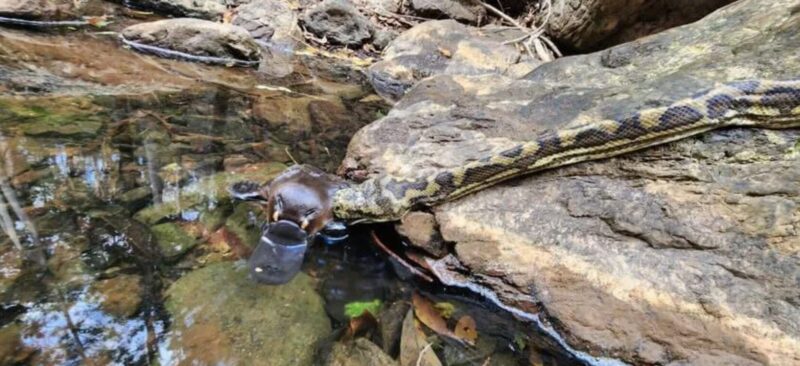
Tamielle Brunt, a platypus expert with Queensland's PlatypusWatch project, has called the images “incredible.” Although snakes are considered a potential predator for the egg-laying mammal, a python attack on this unique Australian creature has never been seen before.
“Most commonly, [the platypus's] native predators would be sea eagles and hawks," Brunt told Yahoo! News. "They could easily drop down and take one from the water… Then obviously there’s invasive predators like cats and foxes.”
Snakes are more dangerous to platypus eggs.
Bowerman seems to have a knack for witnessing bizarre animal interactions. Hiking last year in New South Wales, he heard a rustling in the bushes. It was an antechinus (a carnivorous marsupial mouse) eating a dead antechinus. It was the first time that cannibalism had been witnessed in this species.
For the eleventh year, October 23 marks International Snow Leopard Day. Only 3,500 to 7,000 of the beautiful speckled cats, listed as vulnerable by the International Union for Conservation of Nature (IUCN), remain.
The snow leopard lives in 12 of the most mountainous countries in the world -- Afghanistan, Bhutan, China, Kazakhstan, Kyrgyzstan, India, Mongolia, Nepal, Russia, Pakistan, Tajikistan, and Uzbekistan. Typically, the greyish felines roam at altitudes of 3,000m to 5,200m, often stalking high-altitude ungulates such as blue sheep and ibex.
For years, snow leopards were so elusive that only local people ever saw them, rarely and at a distance. With a better understanding of their habits, patient visitors are often able to spot them, especially in India and Bhutan.
Last year, India's first-ever snow leopard survey pegged the number of cats at 718. Bhutan has 134 snow leopards, while in Nepal, the number ranges from 300 to 500.
"A cloud of cumbrous gnats do him molest,
All striving to infix their feeble stings,
That from their noyance he no where can rest.”
– Edmund Spenser, The Faerie Queene (1552-1559)
Most of us can sympathize with Spenser’s hero. In some places, hungry flies can turn summer into hell on earth. We can tell ourselves that every living creature has its role in nature, but even the Dalai Lama admits that compassion for the mosquito is difficult after the third bite.
Today, we have many ways to fend off mosquitoes and black flies, but they all carry minuses: the repellent DEET is oily and dissolves plastics and nylon. Insect-proof clothing turns hot days into sweatfests. You can barely see through a head net, especially when looking into the sun. Relieving yourself outdoors takes preparation, timing, and speed.
Even when you’re well-armored against bites, mosquitoes and black flies are so abundant in parts of the North that they dominate one’s consciousness. Close your eyes at the end of a day and all you see are specks, specks, specks.

No-see-ums and deer flies add their personalities to the torment mix. No-see-ums combine near-invisibility with a bite vastly out of proportion to their size. They aren’t dubbed flying jaws for nothing. And deer flies exhibit a maddening stubbornness once they start orbiting you on a sunny day. But their numbers don’t compare to those of mosquitoes and black flies.
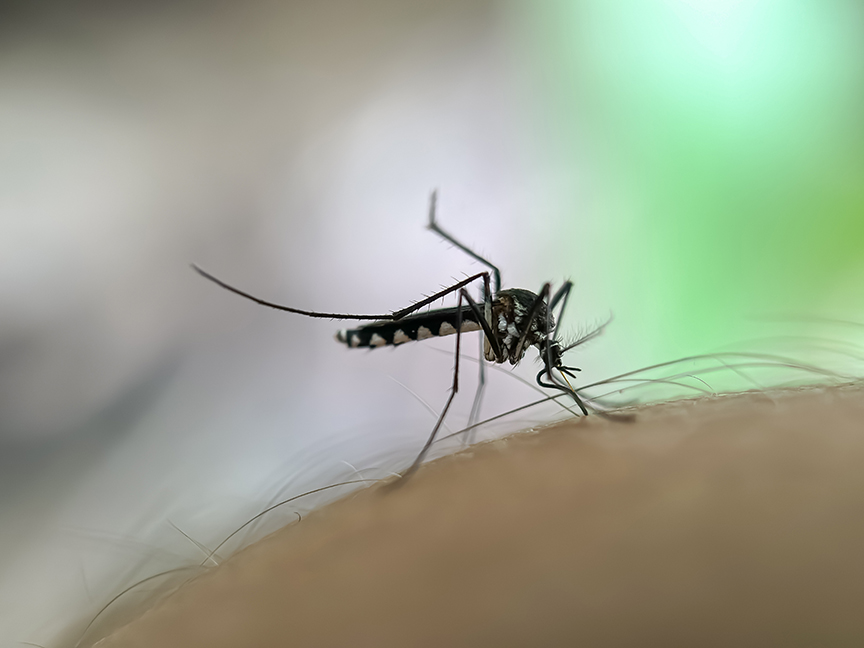
Blue jeans turn grey
Whatever the blood-hungry insect, the North serves them up like no other place on Earth. Where else can blue jeans turn grey with mosquitoes, or your hand leave an imprint in squished flies on your partner’s back? Yet travelers still rave about their tundra trips and chalk the bugs up as one more challenge overcome, like a difficult portage or a bear shooed from camp. Afterward, the welts and scabs feel like hard-won medals from a true adventure.
But does it really have to be so brutal? Drawing from local lore and historical accounts from agonized explorers, plus briefs from bug-obsessed biologists, this guide to winged misery lets you know your enemies –- the better, as Sun Tsu points out in The Art of War, to have them at your mercy.
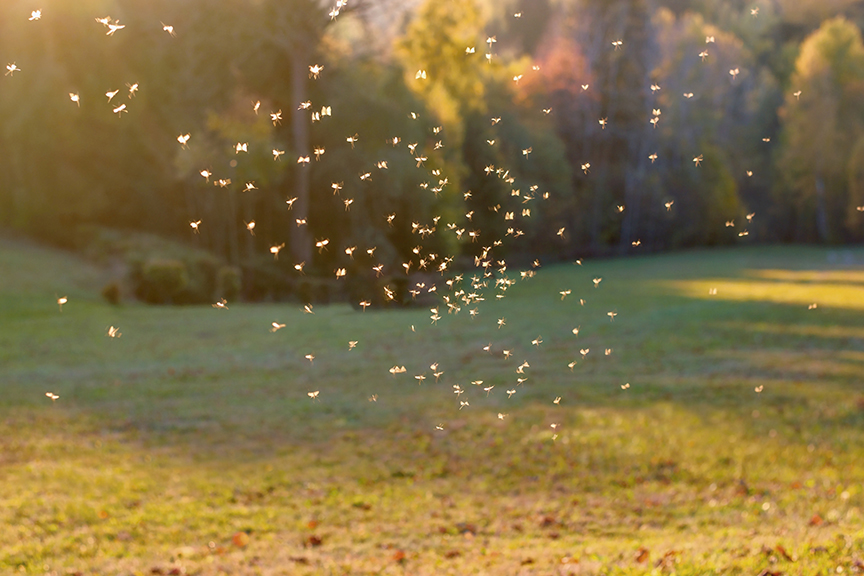
12.5 million mosquitoes per hectare
Studies of our mosquito and black fly populations are rare –- would you want to earn your PhD counting blood-sucking insects? -- but a few hard-bitten researchers have unearthed shocking results. The Hudson Bay lowlands have 12.5 million mosquitoes per hectare of a single species, and you need to multiply that at least threefold to account for the other mosquito species present.
Some boreal rivers in Canada have 750,000 black fly larvae per square meter. Black fly larvae on a single river in northern Sweden produce 69 tonnes of excrement per day. That's just their excrement.
The clearest picture of mosquito and black fly numbers comes from accounts of afflicted explorers.
“Backs and hats were brown with the vicious wretches,” wrote northern traveler H. Hesketh Prichard, who devoted a whole horrified chapter of his 1911 book, Through Trackless Labrador, to what he called the Kingdom of Beelzebub.

Indescribable
“What these mosquitoes are is indescribable,” Prichard continued. “They give no rest, no peace. Day and night they go on and on and on.”
“Nearly demented,” he noted in his journal a day later.
Naturalist Ernest Thompson Seton may have left the best literary record about northern mosquitoes. He regarded the Grey Terror with a scientific enthusiasm that belies how unpleasant his experiences were.
“On six square inches of my tent, I counted 30 mosquitoes, and the whole surface was similarly supplied,” he recalls in his 1911 classic, The Arctic Prairies. “That is, there were 24,000 on the tent…They reminded us of Klondike gold-seekers. Thousands go; great numbers must die a miserable death; not more than one in 10,000 can get away with a load of the coveted stuff, and yet each believes that he is to be that one, and pushes on.”
Mosquito gauge
Seton’s most memorable invention was his mosquito gauge: “Mere adjectives could not convey any idea of their terrors,” he explained. So as he traveled different parts of Canada's Northwest Territories, he periodically removed his glove, then tallied the number of mosquitoes that alighted on the back of his hand in five seconds.
In one spot, he counted five to 10; near Fort Resolution, 20 to 40. But deep in the Barren Grounds, that area of tundra ponds, streams, and mossy plains north of Manitoba, took the record: 100 to 125 mosquitoes on one hand in five seconds.
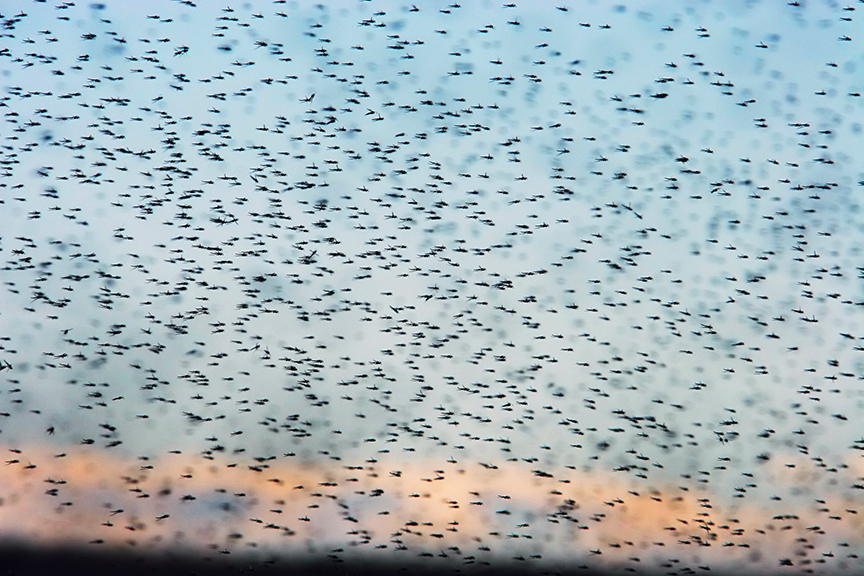
“It was possible to number them only by killing them and counting the corpses,” he writes.
As the contrast between Seton’s curiosity and Prichard’s anguish suggests, some of us are psychologically more pained by swarming flies than others. It’s not just stoicism. Even the tough First Nations people, who endured this yearly plague for centuries, were hardly indifferent. When explorer Knud Rasmussen traveled across northern Canada early in the 20th century, he found that the second most popular trade item, after sewing needles, was mosquito netting. The people he met may have been tough, but they weren’t crazy.
'Little fly'
Mosquitoes –- Spanish for “little fly” –- have been on earth for more than 100 million years. They’ve sunk their proboscises into everything from velociraptors to early hominids.
Currently there are about 3,500 species worldwide, and 74 in Canada and Alaska. Just two cold-resistant types inhabit the arctic islands, and their numbers taper the farther north you go. The High Arctic has hardly any, except in mild enclaves called polar oases.
But as the climate warms, their beachhead is expanding: Residents of normally mosquito-free Grise Fiord, the northernmost village in Canada, have noticed a few in recent summers. Even though there currently aren't many, "people freak out when they see one or two," says one resident.
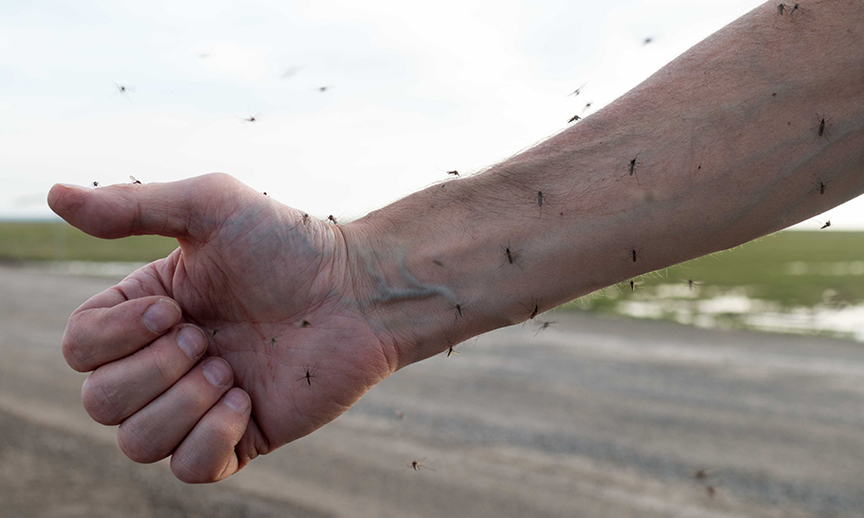
According to a native legend, originally there were just two mosquitoes. They were tall as pine trees and ate people whole. When men finally surrounded and killed them, swarms of tiny replicas sprang from their spilled blood. Today, they bite us out of revenge.
The voyageurs believed that a certain saint, banished from heaven for disobedience, had to live alone for eons in an uninhabited part of the world as punishment. In her loneliness, she prayed for a few flies to keep her company. She didn’t expect the flies to bite. When the saint was let back into heaven, the flies stayed on earth to remind us of the folly of trying to distract from the consequences we’ve brought on ourselves.
The world’s most dangerous animal, mosquitoes carry West Nile virus, encephalitis, and many other diseases, especially malaria. Malaria infects 247 million people worldwide each year and kills a million. A simple mosquito bite single-handedly transmits the disease, says the World Health Organization.
Airport malaria
Discounting travelers who bring back the disease from overseas, the main incidence in some places is so-called airport malaria, caught near airports from disease-bearing mosquitoes that have hitched on international flights.
Only female mosquitoes bite (so they can nourish their eggs with blood’s protein). They hunt their prey like a homing missile. When a mosquito detects carbon dioxide from breath –- from as far as 35 meters away -- it flies a zigzag course toward higher concentrations to locate the source.
As it closes in, other cues take over, including body odor, heat, and sight. Perfume attracts them, as do stinky feet, which contain an alluring bacteria also found in Limburger cheese. When mosquitoes are about three meters away, they use sensitive thermal receptors on their antennae to locate blood beneath the surface of the skin.
The range of these receptors triples in high humidity. While black flies gnaw a messy crater and then lap up the pooling blood, mosquitoes insert a double-barreled straw. Through one straw, they inject an enzyme that inhibits clotting and causes itching and a bump on the skin. They use the other straw to suck up blood.
Three times its weight in blood
A mosquito can drink up to three times its weight in blood, but it would take more than a million bites to drain all the blood from an adult human. Urban myths aside, this couldn’t happen, even to a naked person on the tundra, because swelling would create a watery fluid barrier that would keep late-arriving legions from accessing the blood.
Still, the number of bites a body would have to endure in order to reach this agonizingly swollen, protective phase would be in the thousands. One researcher inserted his bare arm into a cloud of mosquitoes and got 289 bites in a minute.
Less ubiquitous than mosquitoes, black flies still terrorize bush country, attacking in clouds. Burrowing through the protective fur of mammals to the soft skin beneath, black flies are particularly –- some say diabolically -– adept at finding their way through the smallest chinks in clothing. They also like ears, scalps, wrists, ankles, the belt line, and other areas where clothing has pinched the skin tight.
The small white stripes on the legs of our most common species give rise to one of their many nicknames, white socks.
The tormentor
Worldwide, there are more than 1,250 species of black flies. In the Canadian North, where they are most abundant, they reach as far as Baffin and Banks Islands, but the High Arctic is blessedly free of them. The most common Barren Ground black fly has the species name of tormentor. Another northern species is irritatum. Scientists aren’t above putting their personal feelings into their work.
While mosquitoes hatch in stagnant water, black flies prefer running streams. The females lay their eggs (150 to 600 per season) on submerged objects. The larvae attach to rocks and underwater vegetation and filter feed on drifting nutrients. They’re sensitive to pollution, so the presence of black flies indicates clean water. A small consolation.
Black fly numbers increase toward sunset but they don’t bite at night. Nor do most species bite indoors. This includes tents, houses, and even vehicles with open windows.
inside, black flies become disoriented. In a tent, for example, they lose interest in biting and crawl up the netting, trying to escape. It’s easy to unzip the door and brush them outside. For campers, it’s a welcome reprieve from sneaky mosquitoes, which will bite indoors night and day.
The black fly's weak spot
Scientists aren’t sure why black flies don’t like a roof over their heads. “If we could bottle whatever it is, we could make a lot of money,” says entomologist Tom Chapman of Memorial University in St. John’s, Newfoundland.
Black flies sometimes swarm cattle in such numbers that they kill them. The cattle don’t die from blood loss but from anaphylactic shock. The saliva that the flies inject to keep blood from clotting can affect sensitive people too, especially after hundreds of bites.

Some northern expeditions, such as the famous 1903 Leonidas Hubbard expedition in Labrador, suffered from black fly fever. “They got into our nostrils, into our ears, into our mouths, into our eyes even,” wrote one of Hubbard’s companions. “They were villainous, hellish."
Hubbard frequently remarked that the mosquitoes seemed friendly in contrast. "For ten days, I was fairly sick from the poison the [black flies] instilled.”
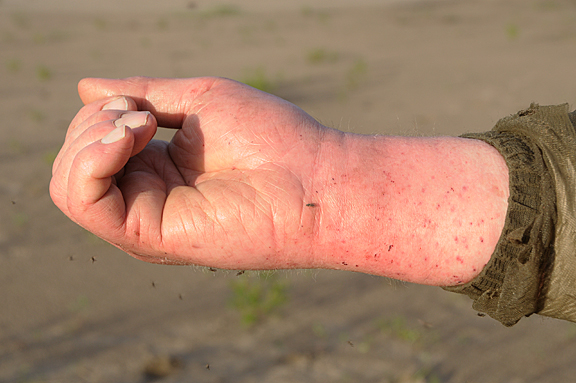
Deterrents
Monty Python once performed a skit in which mosquitoes were gunned down with automatic weapons and blown up with grenades. Although we might yearn for such revenge, quieter deterrents are more effective. Since 1957, DEET has been the gold standard in repellents. Developed by the military after World War II, DEET was thought to blind the insects’ senses so the biting instinct didn’t kick in.
It turns out this isn’t quite true. Recent studies suggest that DEET acts as a true repellent. Mosquitoes simply hate the smell of the chemical, even though it doesn’t seem to affect their ability to detect carbon dioxide.
DEET comes in sprays, oils, roll-ons, and lotions of varying strengths. You can still buy 100 per cent DEET in the United States, but Canada limits consumer products to 30 per cent or less because of the skin irritation some users suffer. Higher percentages of DEET don’t repel better; they just last longer.
An alternative repellent developed in the 1980s called Picaridin is reportedly as effective as DEET and doesn’t cause skin irritation. Unlike DEET, it also won’t dissolve the arms of your sunglasses or a plastic watch strap.
Dozens of traditional concoctions and modern inventions claim to keep biting flies at bay. None do as well as the certified test tube products, though. Citronella works for less than an hour. Avon Skin So Soft moisturizer is celebrated for its accidental repellent properties but also doesn’t last.
Ultrasonic devices and bug zappers do nothing. Neither do Vitamin B tablets. Garlic works for 20 minutes or so when rubbed on skin but not when eaten. And contrary to myth, bananas don’t attract biting flies, so eat away. But drinking beer does seem to make a person more attractive, at least to flies.
Scientists have recently discovered that geckos have a sixth sense that detects low-frequency vibrations. Until now, only water-based creatures like amphibians and fish have shown this ability. This duality — both hearing and vibration sensing — suggests how hearing evolved from fish to land animals. People might have this residual ability, too.
“The ear, as we know it, hears airborne sound. But this ancient inner pathway, which is typically linked to balance, helps geckos detect vibrations that travel through mediums like the ground or water,” said study co-author Catherine Carr.
The vibration detector, called the saccule, sits in the gecko's inner ear. It is vital for balance and completely independent of the gecko's normal hearing mechanism.
With just their normal ears, geckos can hear higher-frequency sounds between 1,600 and 5,000 Hertz. The saccule targets the lower end of the spectrum, allowing them to detect faint low-frequency vibrations between 50 and 200 Hertz.
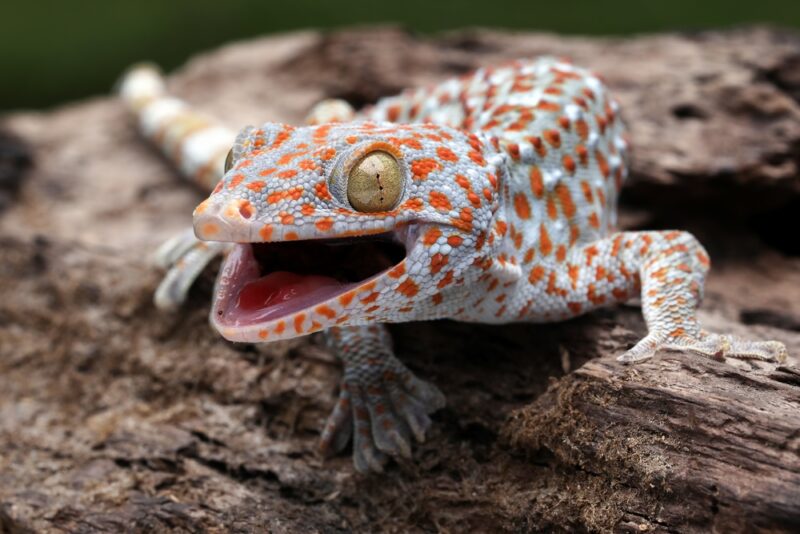
The researchers think that this link between the geckos' hearing and the part of the inner ear that affects balance might also be present in humans.
“Think about when you’re at a live rock concert. It’s so loud that you can feel your whole head and body vibrate in the sound field. You can feel the music, rather than just hear it…meaning our sense of hearing and balance may also be closely linked,” said Carr.
The discovery also hints that other reptiles might actually be able to hear.
“A lot of snakes and lizards were thought to be ‘mute’ or ‘deaf’ in the sense that they do not vocalize sounds or hear sounds well,” explained lead author Dawei Han. "But they could potentially be communicating via vibrational signals."
Most visitors don’t consider the Himalaya a wildlife destination, but the world’s highest mountains hold a surprising amount of diversity.
From snow leopards and grumpy Pallas's cats to blood pheasants and red pandas, here are some of the places wildlife watchers head for mountain wildlife.
Hemis National Park, Ladakh, India
Hemis covers 4,400 square kilometers a vast swathe of rugged, high-altitude desert between 3,000 and 6,000m in Ladakh, India.
The park holds a stable population of argali, urial, and bharal (all wild sheep species). These are nice to spot, but for most visitors, they are more important for what they represent: big cat food. An abundance of prey supports an estimated 200 snow leopards in Hemis, which might be the highest density of any protected area in the world.
For a long time, wildlife watchers regarded seeing a wild snow leopard as almost impossible. Evidence of their presence (scat, territorial markings, paw prints) was easy enough to find, but actually spotting the ghost of the Himalaya was a tall task. Sightings required insane luck or months, if not years, of work.

Now, things are much easier. Increased knowledge of territories and habits revealed that snow leopard sightings were not just possible but likely, given enough time. You needed to be in the right place at the right time. And you will need to spend long hours in the cold.
Sightings generally require at least a few days spent scouring ridges and cliff faces at dawn and dusk. It’s cold, uncomfortable work, but the potential payoff for photographers and wildlife enthusiasts is worth the effort.
And sightings aren’t restricted to big national parks like Hemis. In remote Ladakhi villages, residents will tell you that they regularly see the cats. Locals have shown me phone camera videos of snow leopards practically close enough to touch, stalking past houses and leaping dry-stone walls (and occasionally taking domestic livestock -- leading to some human-wildlife conflict). As a result, some of these out-of-the-way hamlets now draw tourists for week-long stays.
Eagle’s Nest, Arunachal Pradesh, India
Foreigners require special permission to visit Eagle’s Nest in Arunachal Pradesh. This means it’s not a cheap trip, despite only basic accommodation at two campsites. However, it continues to attract adventurous wildlife enthusiasts because the area has built a strong reputation for unusual wildlife sightings.
Named after an old military base (formally occupied by the “Eagles” unit), the area is particularly popular with birders. In 2006, researchers described a new species of liocichla from here. Ornithologists named it the Bugun liocichla after a local ethnic group. With evidence of only 10 breeding pairs, it is critically endangered.
Though it has long been a birding destination, it has only recently caught the attention of mammal watchers. The road between the two campsites has proved productive for some hard-to-see nocturnal species, including mega-rarities like clouded leopards and golden cats.
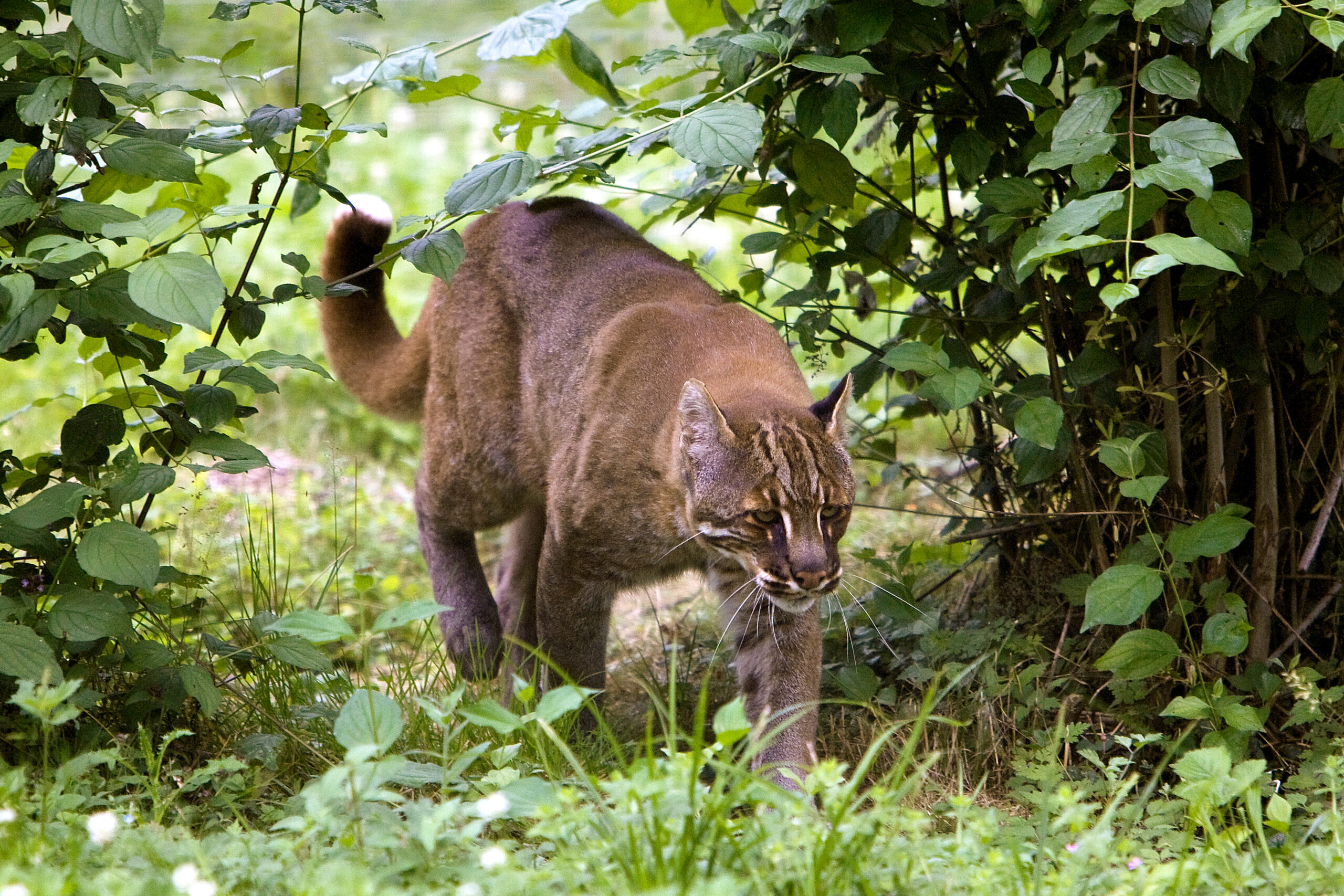
Sagarmatha National Park, Nepal
More than just Everest, Sagarmatha National Park is surprisingly busy with wildlife. Despite the heavy foot traffic during trekking and climbing season, you can see many pheasant and grouse species, including blood pheasants and the national bird of Nepal, the monal. Commonly seen mammals include Himalayan musk deer and Himalayan tahr.
Humans wiped out snow leopards here in the 1970s through overhunting, both of the cats and their prey. A small number have returned over the last half century as the prey species have rebounded. However, sightings remain extremely scarce.
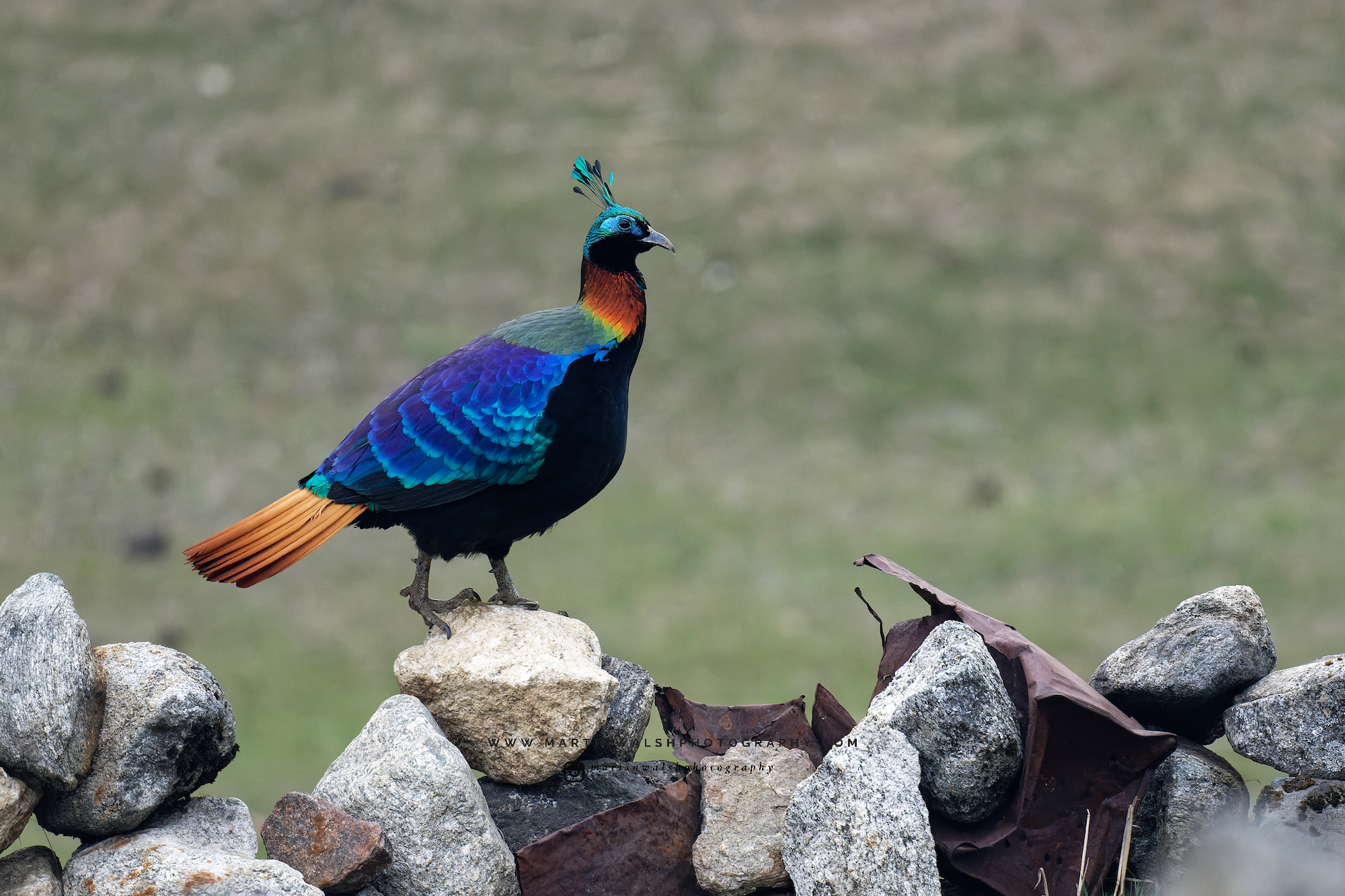
Langtang National Park, Nepal
Established in 1976, Langtang was the first-ever Himalayan National Park. Its proximity to Kathmandu (it starts just 30km from the capital and stretches to the China-Tibet border) makes it easy to visit independently.
It has a reputation as a good spot to find red pandas and is fantastic for birds (373 species recorded) because of lakes such as Gosainkunda. Commonly observed mammals include Himalayan tahr, Himalayan musk deer, Assam macaque, and Nepal sacred langur.
While most wildlife-focused visitors to Nepal head to Chitwan National Park or Bardiya National Park down in the Terai, it’s worth combining a visit with some hiking to look for mountain specialist species.
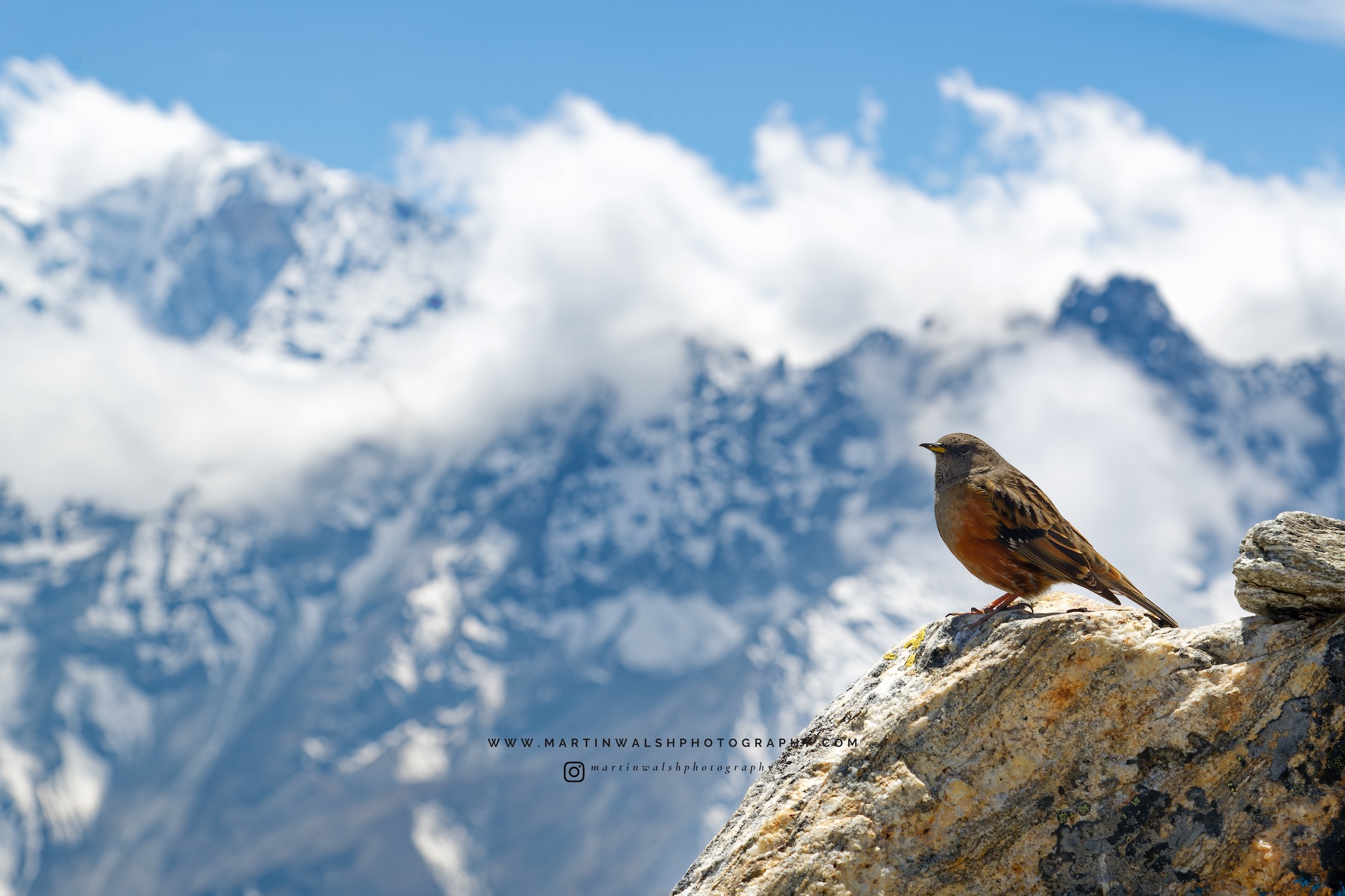
Hengduan Mountains and the Tibetan/Himalayan Plateau, China
Though they are not technically the Himalaya, I’m lumping the Hengduan mountains of Sichuan and neighboring areas of the Tibetan Plateau into this list.
This is one of the best regions in the world to see an array of cat species. Pallas’s cat (the manul), Eurasian lynx, snow leopard, Chinese mountain cat, and leopard are all possible here. Asian brown bears and wolves are not uncommon. Tantalizingly, it is also one of the few places where you might spot a wild panda.
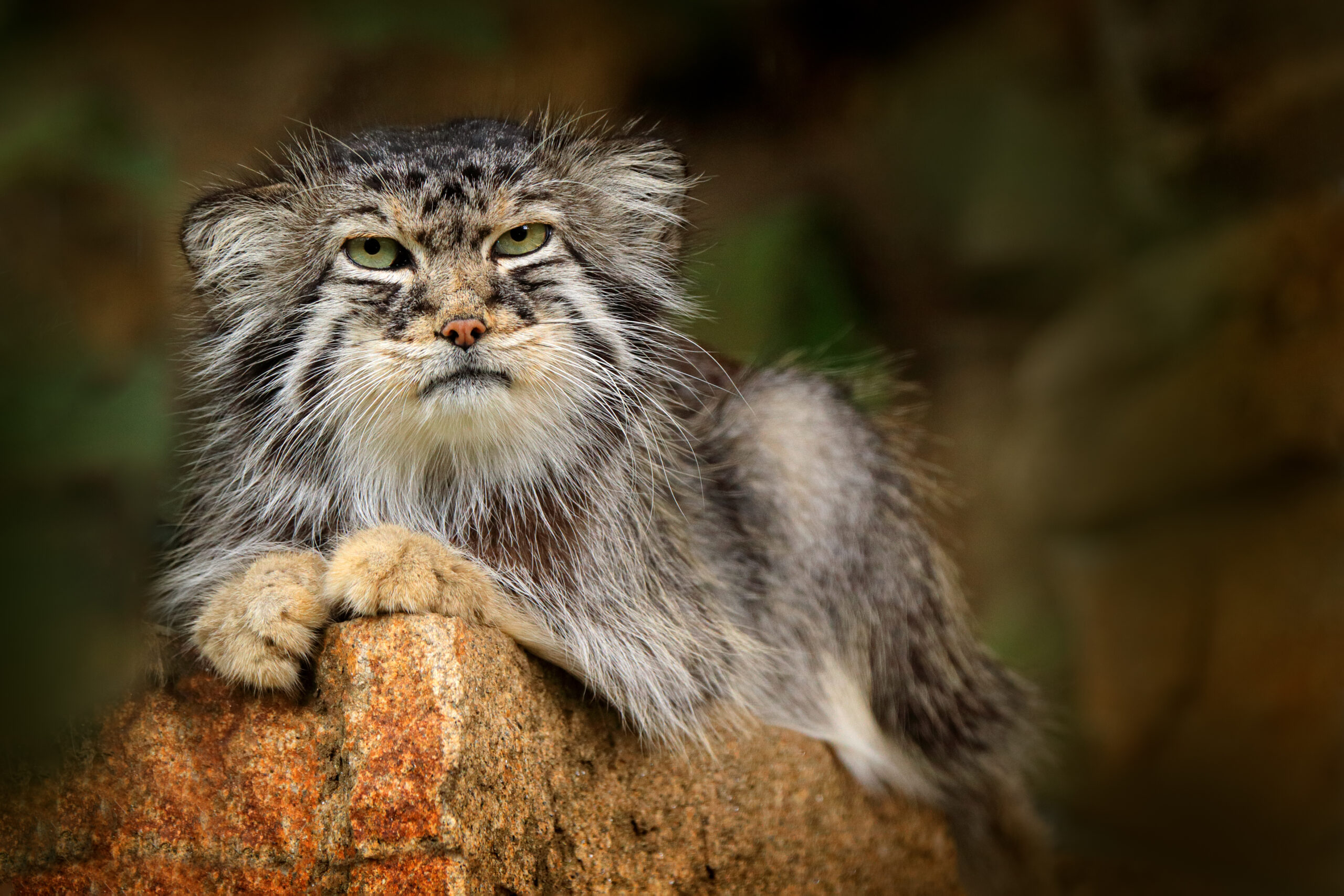
National parks are a new concept in China. The government revealed five initial national parks in 2021. One of these was Giant Panda National Park, an effort to unite a sprawling group of 81 existing nature reserves. Tangjiahe Nature Reserve in the Hengduan Mountains is part of the park's core area. The elevation ranges from 1,150m to 3,837m and features a mix of dense bamboo and subtropical forest. It is an important panda habitat.
Sightings are extremely difficult, and those who do spot a wild panda are reluctant to reveal exactly where sightings took place. Researchers estimate that there are 39 pandas in the reserve.
Other charismatic megafauna present include golden snub-nosed monkeys and Tibetan takin, a species of goat-antelope.
Canada's Shane Gross has won the annual Wildlife Photographer of the Year competition with his backlit image of tadpoles underwater. Gross beat stiff competition from a record-breaking 59,228 entries to take the award.
A marine conservation photojournalist by trade, his image shows a swarm of black and gold western toad tadpoles moving through the stalks of lily pads. It is the first time the species has featured in the competition.
Gross took the photo while swimming in Cedar Lake on Vancouver Island, British Columbia. Only one percent of tadpoles make it to adulthood.

“The jury was captivated by the mix of light, energy, and connectivity between the environment and the tadpoles,” explained Kathy Moran, chair of the jury for Wildlife Photographer of the Year.
Other winners
Young Wildlife Photographer of the Year went to Alexis Tinker-Tsavalas from Germany for his macro image of a raspberry-colored springtail edging towards slime mold.
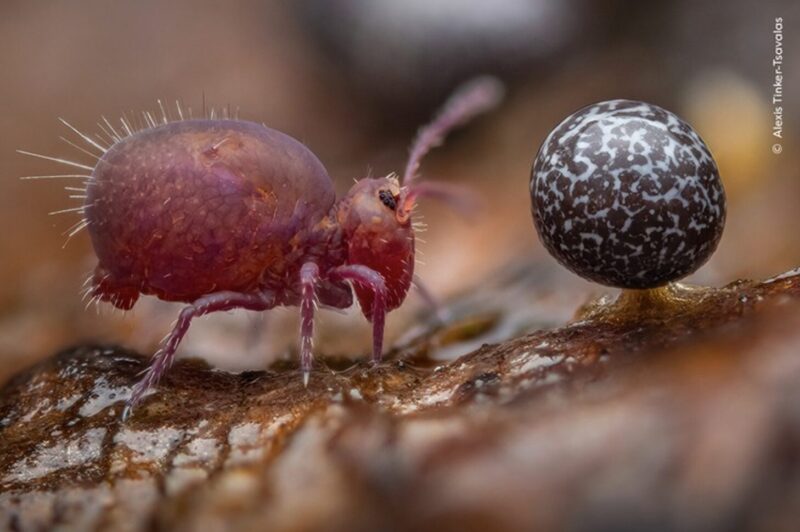
Springtails are tiny creatures, just a few millimeters long, known for their rapid pace and jumping skills. To create the final image Tinker-Tsavalas snapped 36 frames at slightly different focal lengths. He then combined them to create the incredible photo.
“To see a macro image of two species photographed on the forest floor, with such skill, is exceptional,” said Moran.

This is the 60th anniversary of the prestigious Wildlife Photographer of the Year contest held by the Natural History Museum in London. At the same time as naming the two grand title winners, the jury of judges awarded the winner of each of the 18 categories within the competition. An exhibition of 100 images that took home commendations and awards is now on display at the museum. “


Octopuses are usually solitary creatures, but occasionally they group together with fish to share the burden of hunting. But woe betide any fish that does not toe the line.
Researchers have analyzed 120 hours of footage about the social behavior of these mixed hunting packs. One thing they noticed was the level of aggression within the groups. Though working towards the same goal, hunting was not always a harmonious endeavor.
Fish within the group often darted toward other fish, forcing them to move out of the group or into a different position. Octopuses went one step further. If a fish was not contributing, the octopus would punch it out of the way.
Blacktip groupers, for example, often loitered near the periphery of the group and did not add to the joint hunt. Instead, they tried to snatch up the prey opportunistically. Unimpressed by this behavior, the octopus of the group often gave the offending grouper a swift punch.
Mixed species hunting groups have been seen before, but there is no record of them correcting each other's behavior in this manner.
"These results broaden our understanding of leadership and sociality, emphasizing the complexity and adaptability of social interactions in nature," said Eduardo Sampaio, lead author of the new study.
Shared leadership
The team observed 13 different groups, all made up of one octopus and an array of other fish. The octopus and fish appear to share leadership. This seems to depend on the decision that needs to be made at any given time. For example, goatfish appear to decide on the group's direction and areas of interest, but the octopus seems to be in charge of deciding when they actually move.
"The octopus basically works as the decider of the group,” said Sampaio.

The fish and octopus both bring useful techniques to the hunt. The fish can patrol and signal when prey are present, while the octopus can search crevices that are inaccessible to the fish. This alliance allows both creatures to catch more prey.
Though they hunt together, the fish and octopus do not share the prey.
"One item of prey is not divided; it is taken by whoever catches the prey first,” Sampai told Nature News.
Polar bears aren't native to Iceland, though an occasional vagrant arrives from Greenland. So, it was quite a surprise for an elderly resident of a remote village to find one raiding her bins. Panicked, she locked herself upstairs and called for help.
After consulting with the Icelandic Environment Agency, police arrived and shot the bear. The agency decided not to try and relocate the animal, following recommendations laid out in a 2008 study. That study concluded that moving bears back to Greenland was prohibitively expensive and suggested killing vagrant bears was the best response.
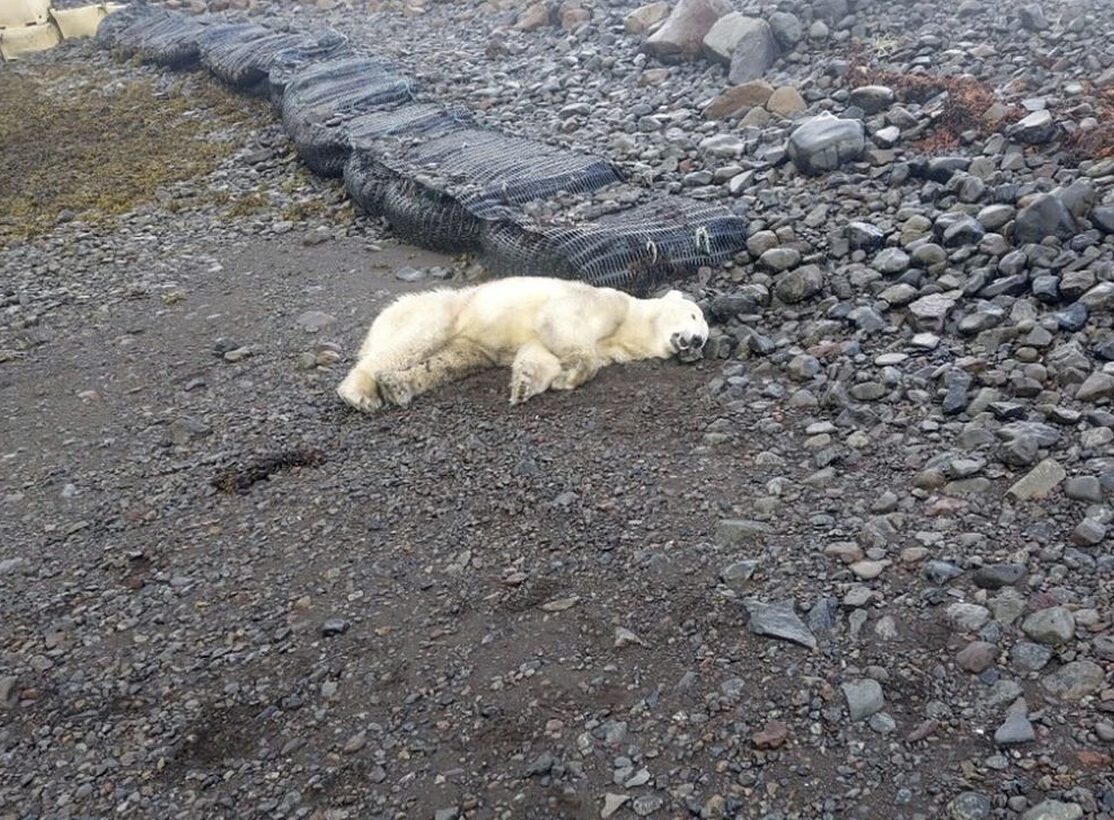
A protected species?
Polar bears are a protected species in Iceland and cannot be killed at sea. However, they can be killed if they threaten humans or livestock.
"It’s not something we like to do," Westfjords Police Chief Helgi Jensson told The Associated Press. "The bear was very close to a summer house. There was an old woman in there."
This is the first polar bear sighting in Iceland since 2016. Only 600 polar bears have been recorded in Iceland since the ninth century. Experts believe this bear may have traveled from eastern Greenland on an iceberg, of which several were spotted near the north coast recently.
Wildlife photography is as much about luck as skill, but you have to take your opportunities. Photographer Tomis Filipovic certainly made the most of his.
While photographing whales, Filipovic caught a once-in-a-lifetime moment in the Strait of Juan de Fuca near Vancouver Island, Canada. A feeding humpback whale accidentally caught a harbor seal in its mouth, spitting out the undoubtedly confused seal soon after.
"Luckily, a humpback's throat is only about as wide as a grapefruit, so it can't take in anything bigger than that," Filipovic told CTV News in an interview.
Filipovic wasn't the only observer to capture the moment. Brooke Casanova with Blue Kingdom Whale & Wildlife Tours also landed a shot of the rare encounter.
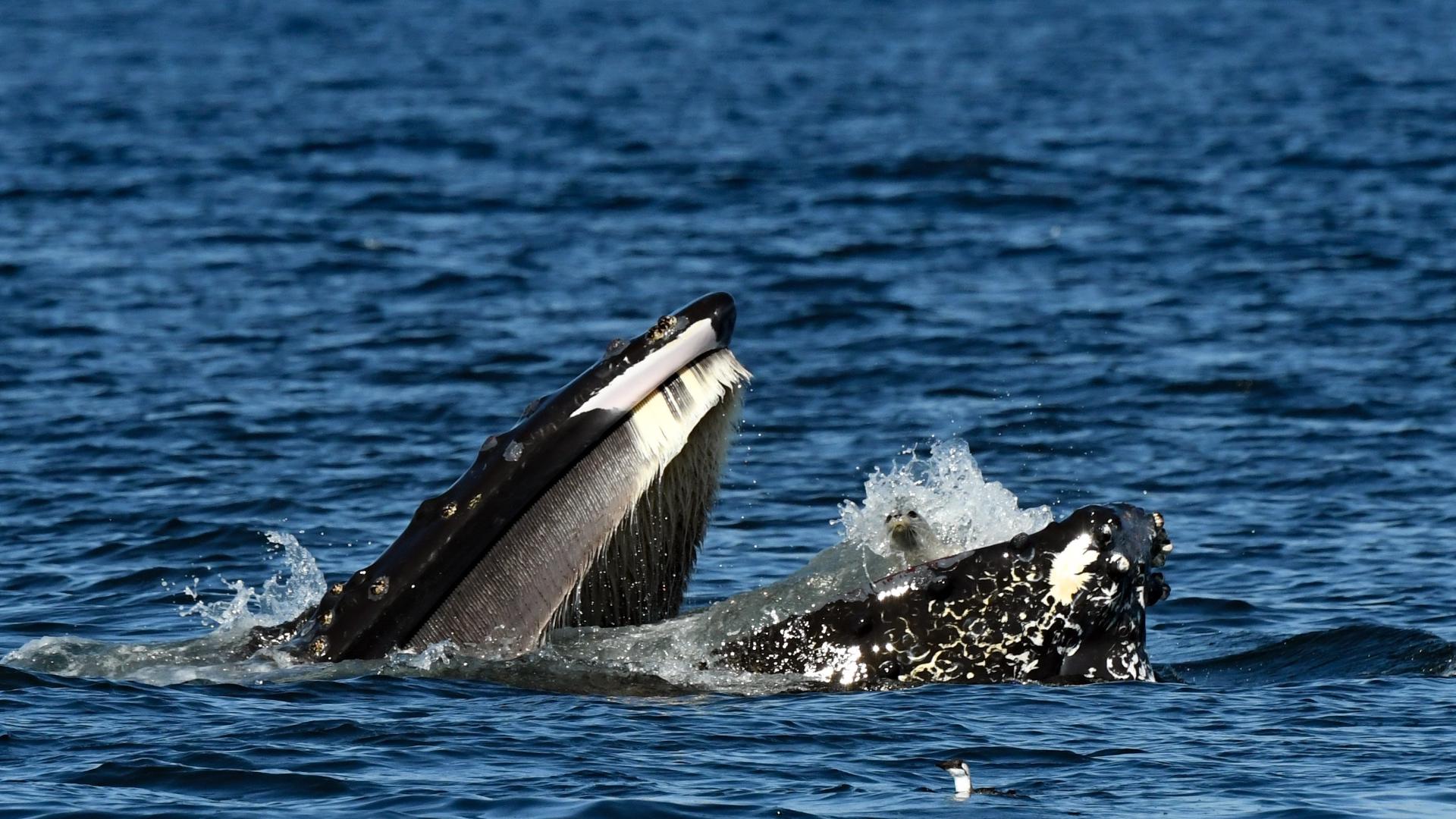
In an extremely unusual situation, a golden eagle was killed after a string of attacks in Norway. The bird attacked four people, including a toddler.
Golden eagles are a widely distributed species with an average wingspan of around 2m. Though intimidatingly large birds, golden eagles usually hunt small prey, such as rabbits and marmots. Attacks on humans are practically unheard of. Yet, over a few days last week, a young eagle showed behavior that was "radically different from normal."
A brazen attack
The most recent (and final) attack may have been the most terrifying. The eagle grabbed a 20-month-old toddler while she was playing in her garden in Norway's central Trondelag region. Fortunately, her mother and a neighbor were nearby. It took both adults to force the eagle to release the toddler, who needed stitches and was left with scratches on her face.
"But it kept coming back," the child's father told Norwegian public broadcaster NRK. It was undeterred even when "the neighbor chased it away with a stick."
The incident with the toddler appears to have been the fourth attack. Two days previously, 31-year-old Francis Ari Sture was out hiking when he thought a human had tried to shove him from a cliff. Turning to confront his attacker he came face to face with an extremely aggressive golden eagle.
"We are staring at each other for, maybe, a whole minute," Sture told the Associated Press. Then, the eagle launched a barrage of attacks, chasing him down the mountain and scratching at his head and face. Sture managed to escape and a local hospital treated him for deep wounds to his face.

An eagle with a behavioral disorder
A day before that, the eagle attacked Mariann Myrvang. The eagle landed on her shoulders, forcing her to her knees under its weight. Myrvang's husband had to beat it with a tree branch to drive it away. Like Sture, Myrvang required a hospital visit.
Alv Ottar Folkestad from BirdLife Norge believes that the young female eagle must have had a "behavioral disorder," that prompted the highly unusual sequence of attacks.
Whatever the cause, the bizarre reign of terror is now over. Local game warden Per Kare Vinterdal arrived shortly after the attack on the toddler and killed the eagle.
Scientists have solved a marine murder mystery in which a pregnant porbeagle shark was the missing victim and the open ocean was the crime scene.
Researcher Brooke Anderson and her team are studying pregnant porbeagle females and wanted to track their long migration. The movement of pregnant females has often eluded researchers. The team was looking for areas important for pup-bearing to protect them.
One female shark had a satellite tracking device that was supposed to stay attached for a year. During that time, it collects information about water temperature, depth, and location. After a year, it detaches from the shark and floats to the surface. Here, it transmits its data to scientists. But this tag began sending data far ahead of schedule.
Initially, the team assumed that something had malfunctioned, and the tag simply detached too early. But the data was bizarre. “I knew something had happened that I had never seen before,” said Anderson.
A mysterious rise in temperature
The last week of data showed that the temperature had increased and stayed higher for a few days. At the same time, the tag was almost constantly located a few hundred meters below the surface.
The team explored different scenarios but could only think of one logical explanation. “That would really only occur if the tag was now in the stomach of a predator that can warm its body temperature compared to the ocean.”
So something had eaten the pregnant porbeagle shark. Predator had suddenly become the prey.
“I couldn’t believe that an eight-foot-long porbeagle shark...would have gotten eaten by something,” said Anderson. An adult porbeagle shark is fierce and formidable, and becoming prey to another species was unprecedented.
The next mystery is what killed the porbeagle. They crossed orcas off the suspect list because they are warm-blooded -- the tag's temperatures, though warmer, were still too cool to come from inside an orca.
That means the only option was another species of shark, specifically a shortfin mako or a great white. Both can warm their bodies the appropriate amount. This, combined with the depth data, narrowed it down to one culprit –- a great white shark. Its dive pattern most closely matched the changes in depth recorded by the tracking device.
BY ALEXANDER HARO
Hvaldimir, a beluga whale that became an internet phenomenon for possibly being a Russian spy, has died. According to reports, a father and son in southern Norway found the whale’s body over the weekend.
Hvaldimir first came into the public eye when he appeared in 2019 near Ingoya, an island off of Norway. He was wearing a harness with a mount for a small camera at the time, and it was stamped with “Equipment St Petersburg.”
He was strangely comfortable around humans and responded to hand signals, which led to the presumption that someone had trained him. His name is a portmanteau of the word Hval, which means "whale" in Norwegian, and Vladimir, after the president of Russia.
When he first showed up, he routinely rubbed himself against boats in an apparent attempt to get the harness off. Eventually, a fisherman donned a survival suit, leapt into the chilly waters off Norway, and cut him free. The whale continued to interact with humans and vessels, playing fetch — he famously returned a cell phone and a GoPro on separate occasions — and asking for food. He even let people pet him.
A beacon of hope
“Hvaldimir was not just a beluga whale,” the Marine Mind NGO said on social media. “He was a beacon of hope, a symbol of connection, and a reminder of the deep bond between humans and the natural world.”
Although Russian officials have never responded to the allegations that Hvaldimir was trained to be a spy, Norway’s domestic intelligence agency had strong suspicions that he was, in fact, part of a research program to be one before he entered Norwegian waters.
As of this writing, there’s no clear answer to what caused his death.
“It’s absolutely horrible,” marine biologist Sebastian Strand, who worked with Marine Mind, told NRK (Norwegian public broadcasting). “He was apparently in good condition as of [Friday], so we just have to figure out what might have happened here.”
This story first appeared on The Inertia.